Museum Catalog
The Vermont Historical Society houses over 25,000 objects relating to our State's history. Over the next five years all of these items will be digitally documented and placed in this catalog for public use. Items are presented in topical exhibits as well as categorical groupings. Please check back regularly as items will be added monthly. This catalog also houses the Vermont Women's History Database and the Vermont Black History Database.
Search All Categories

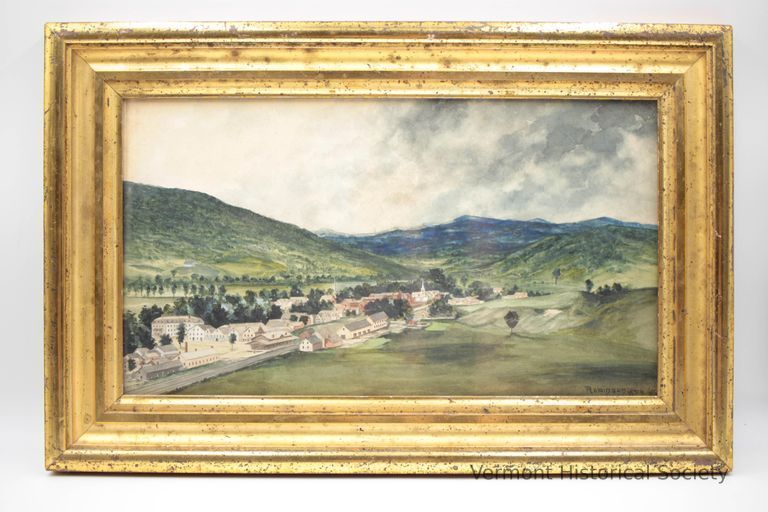
A Storm Coming
Name/Title
A Storm Coming
Type of Painting
Lexicon
Description
Watercolor painting showing a town in a valley. The town (Waterbury, Vermont) is situated to the left of a straight railroad track running from the lower left corner of the painting to the center horizon. The buildings are carefully drafted, with pencil marks visible through the paint. Green hills rise up behind and to either side of the town, with blue mountains in the far distance. Grey clouds darken the sky at the upper right. The painting is in a gilded frame, and the backboard is cut away in sections on the reverse to reveal the handwritten title.
Acquisition
Accession
2021.30
Artwork Details
Medium
Watercolor
Made/Created
Artist Information
Elmer, Rachel Robinson (1878-1919)
Artist
Date made
1893
Entry/Object ID
2021.30.2
Context
Painted by Rachael Robinson in Waterbury, Vermont
Web Links and URLs

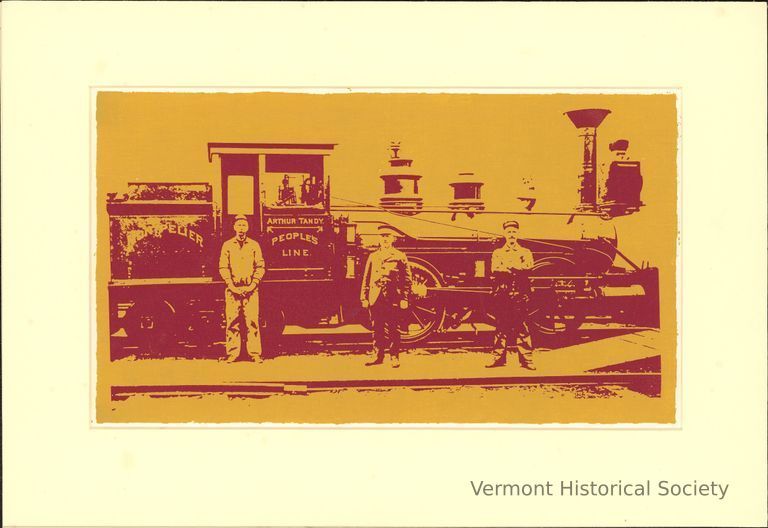
Arthur Tandy
Name/Title
Arthur Tandy
Lexicon
Description
Orange and maroon screen print of a photograph showing three men standing in front of a locomotive engine. The side of the train is labeled, "ARTHUR TANDY / PEOPLE'S LINE", and the coal car is labeled, "MONTPELIER".
Acquisition
Accession
1972.63
Relationships
Related Person or Organization
Montpelier & Wells River Railroad
Person or Organization
Related Places
Place
Montpelier
City
Washington County
County
Vermont
State/Province
United States of America
Country
North America
Made/Created
Artist Information
Beals, A. L.
Artist
Dimensions
Entry/Object ID
1972.63.1


Baseball
Interpretative Labels
Label
Very little survives from Vermont's earliest baseball teams except for their colorful names, such as the Essex Junction Edmonds, the Cambridge Lone Stars, the Jericho Muffs, and the Ridley Sunflowers.
This baseball's just barely legible written label reads- "July 4, 1867/score 75-52/…. Champlains vs. …sp BBC." Vergennes fielded both the First Champlains and Second Champlains in the late 1860s. The other team name isn't clear enough to decipher. Does BBC indicate a Burlington Baseball Club? High scoring games like this one, often with over fifty runs, reflected earlier playing styles such as underhanded pitching and barehanded fielding. Connections by railroads and trolleys between towns and on Lake Champlain by ferries made it possible for the players and a growing number of spectators to enjoy what would become a favorite summer pastime, especially on the Fourth of July.
Name/Title
Baseball
Lexicon
Description
Leather baseball with a pasted-on paper label that reads, "July 14th 1867 score 75-52 / [illeg] Champlain vs [illeg] BBC". The outermost layer of the ball is formed from three wedge-shaped pieces of dark leather stitched together with a whipstitch. A split in one of the seams reveals undyed canvas and red and blue yarn on the interior.
Acquisition
Accession
1967.33
Made/Created
Date made
1867
Materials
Material
Leather
Entry/Object ID
1967.33
Context
Used during an unidentified baseball game in Vergennes, Vermont, in 1867.
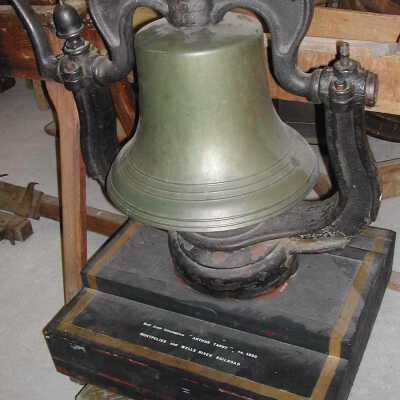
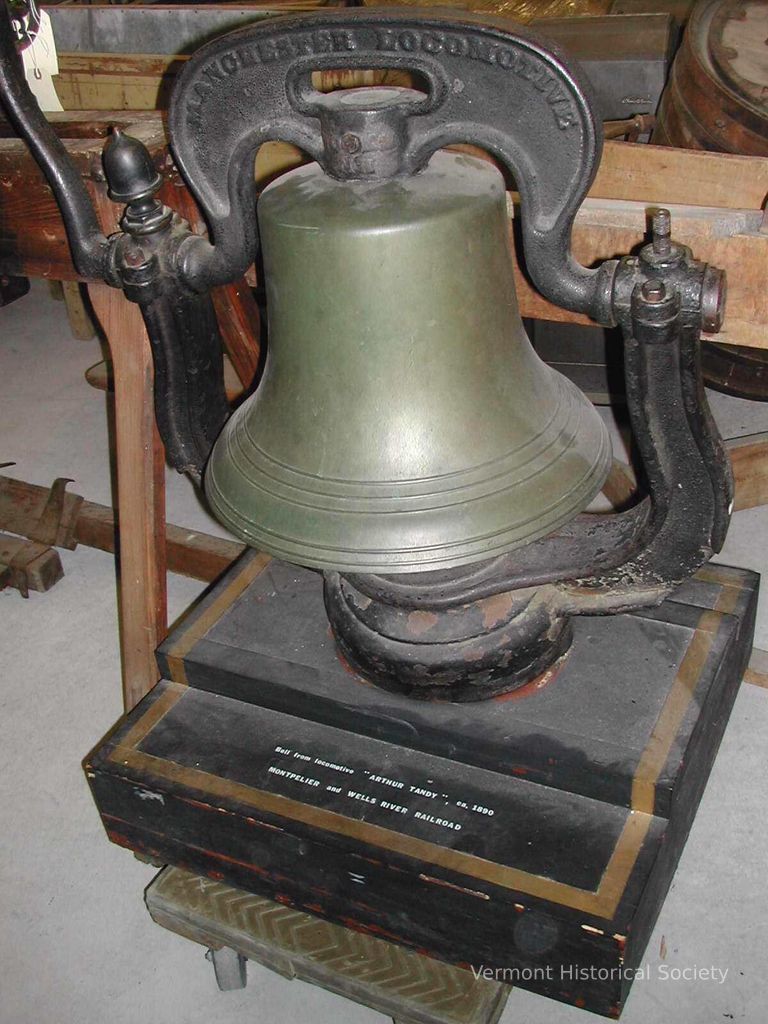
Bell
Name/Title
Bell
Lexicon
Description
Large bell held in a cast iron frame. The upper portion of the frame sits in to vertical posts, allowing the bell to be swung by pulling the large handle on the left side. It is molded with the inscription, "Manchester Locomotive". The whole is attached to a square pedestal with the label, "Bell from locomotive "Arthur Tandy", ca. 1890 Montpelier and Wells River Railroad.
Acquisition
Accession
1965.27
Relationships
Related Person or Organization
Montpelier & Wells River Railroad
Person or Organization
Related Places
Place
Vermont
State/Province
United States of America
Country
North America
Made/Created
Date made
1890-1900
Dimensions
Entry/Object ID
1965.27
Context
From a train on the Montpelier and Wells River Railroad in Vermont.

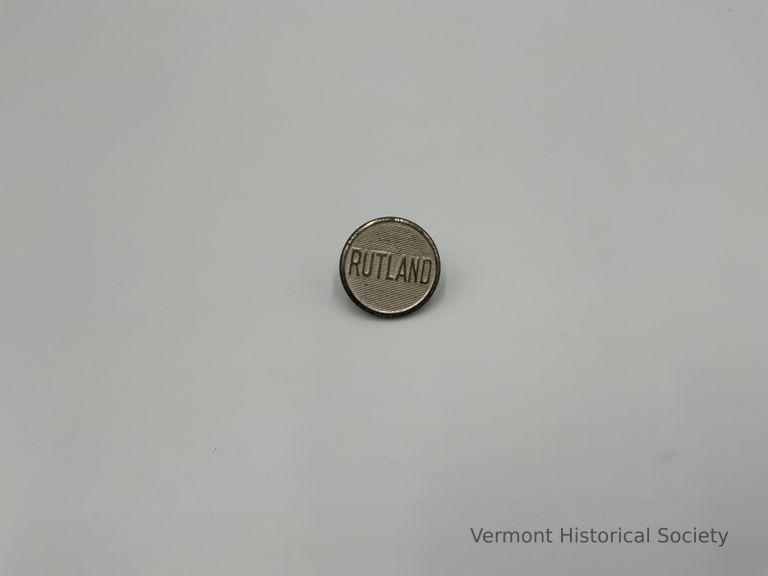
Button
Name/Title
Button
Lexicon
Description
Silver post-backed button with the molded inscription, "RUTLAND", on a striped textured ground.
Acquisition
Accession
2021.5
Relationships
Related Person or Organization
Rutland Railroad
Person or Organization
Materials
Material
Metal
Entry/Object ID
2021.5.30
Context
Worn by an employee of the Rutland Railroad
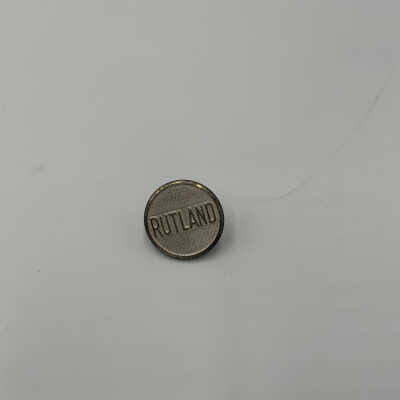
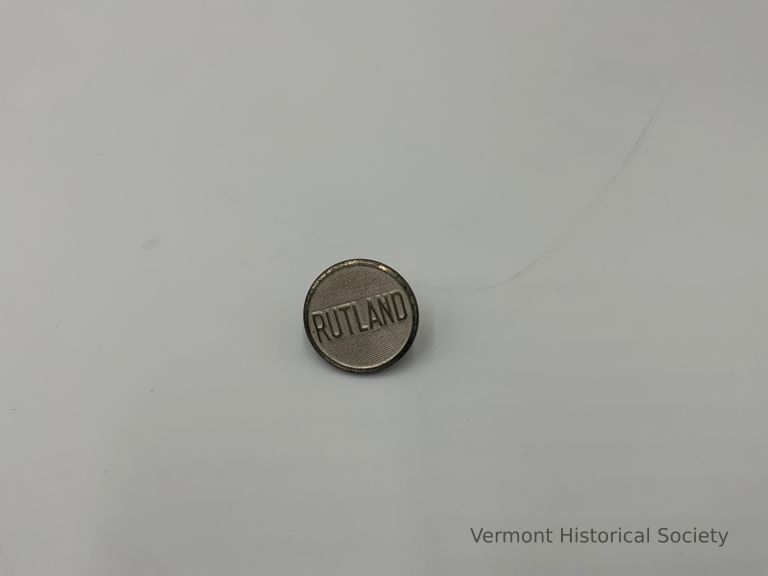
Button
Name/Title
Button
Lexicon
Description
Silver-toned post-backed button with the molded inscription, "RUTLAND" on a striped textured ground.
Acquisition
Accession
2021.5
Made/Created
Manufacturer
Scovell Manufacturing Company
Materials
Material
Metal
Entry/Object ID
2021.5.31
Context
Worn by an employee of the Rutland Railroad


Cane
Name/Title
Cane
Lexicon
Description
Walking stick or cane with brass knob handle. There is a bullet imbedded in the cane. The knob screws off, and the metal tip at the base has a small spike at the center.
Acquisition
Accession
1951.24
Relationships
Related Events
Civil War
Event
Related Person or Organization
Maxim, Hiram, Webster, Theron
Related Places
Place
St. Albans City
City
Franklin County
County
Vermont
State/Province
United States of America
Country
North America
Made/Created
Date made
1861
Dimensions
Dimension Description
Overall
Materials
Material
Bronze, Metal, Wood
Entry/Object ID
1951.24
Context
The knob of the case is a locomotive bell-tongue, case in the St. Albans, Vermont, railroad machine shop around 1861 by Hiram Maxim for Theron Webster. The bullet was embedded into the cane during the St. Albans Raid during the Civil War.

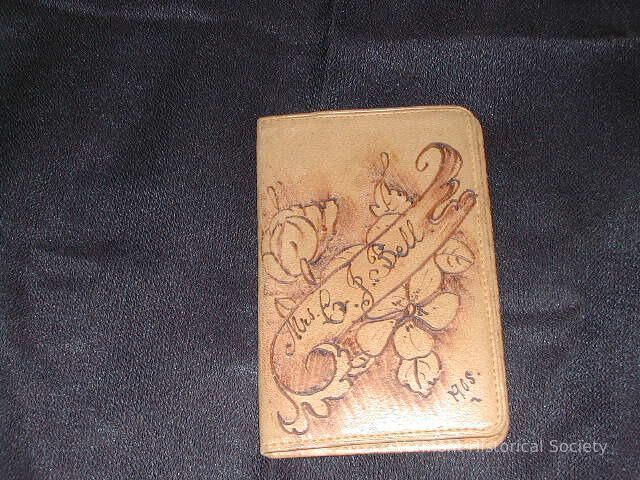
Card Case
Name/Title
Card Case
Lexicon
Description
Leather card case decorated on the front with flowers and a banner that reads, "Mrs. C. J. Bell". The year 1905 is written in the lower right corner. A clear pocket shows a blue paper pass for the Boston & Maine Railroad, giving Hon. C. J. Bell and family complimentary use of the railroad within Vermont for the year of 1906. There is also a calling card that reads, "Mrs. Charles James Bell".
Acquisition
Accession
1960.44
Relationships
Related Person or Organization
Bell, Mary Louise Perry (1849-1918), Bell, Charles J. (1845-1909), Boston & Maine Railroad
Related Places
Place
Walden
Town
Caledonia County
County
Vermont
State/Province
United States of America
Country
North America
Made/Created
Date made
1905
Dimensions
Dimension Description
Overall
Materials
Material
Leather, Paper
Entry/Object ID
1960.44.3
Context
Owned by Mary Louise Bell of Walden, Vermont


Commemorative Medal
Name/Title
Commemorative Medal
Lexicon
Description
Commemorative medal with an image of a small steam-powered wagon labeled "PETER COOPER'S "TOM THUMB"" on one side. The inscription, "THE BALTIMORE AND OHIO RAILROAD COMPANY 1827 1927", rings the edge. The other side shows a steam-powered passenger train with a naked man flying beside it, reaching out to ring the train's bell. The inscription, "ONE HUNDRED YEARS / SAFETY STRENGTH SPEED" rings the edge.
Acquisition
Accession
1945.21
Relationships
Related Person or Organization
Willard, Daniel, Baltimore & Ohio Railroad
Related Places
Place
Hartland
Town
Windsor County
County
Vermont
State/Province
United States of America
Country
North America
Made/Created
Date made
1927
Manufacturer
Medallic Art Co.
Dimensions
Dimension Description
Box
Materials
Material
Bronze
Entry/Object ID
1945.21
Context
Presented by the president of the Baltimore and Ohio Railroad, Daniel Willard of North Hartland, Vermont, to the Vermont Department of Libraries in 1927.
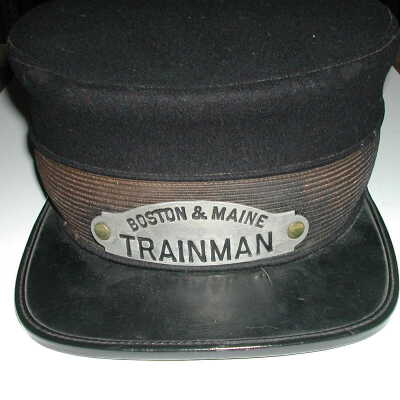
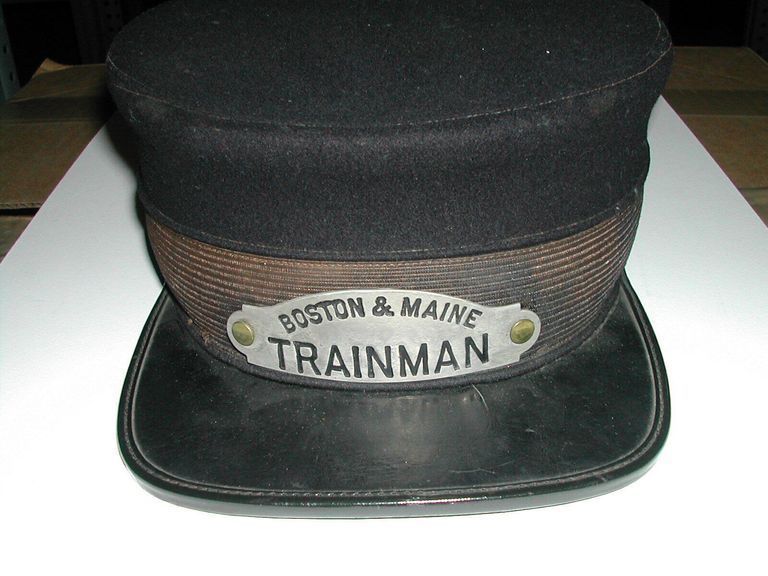
Conductor Hat
Name/Title
Conductor Hat
Lexicon
Description
Wool, flat-topped train conductor's hat with square, leather-covered brim. At the center front is a metal plate with the stamped inscription, "BOSTON & MAINE / TRAINMAN".
Acquisition
Accession
1972.61
Relationships
Related Person or Organization
Boston & Maine Railroad
Person or Organization
Dimensions
Dimension Description
Overall
Entry/Object ID
1972.61.3
Context
Worn by an employee of the Boston & Maine Railroad.
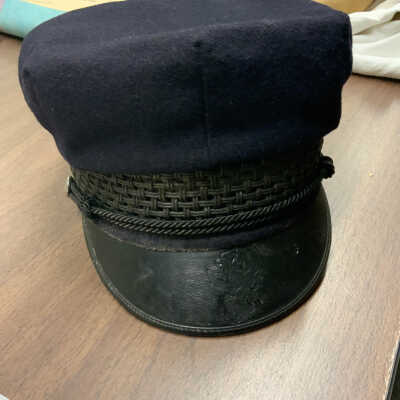
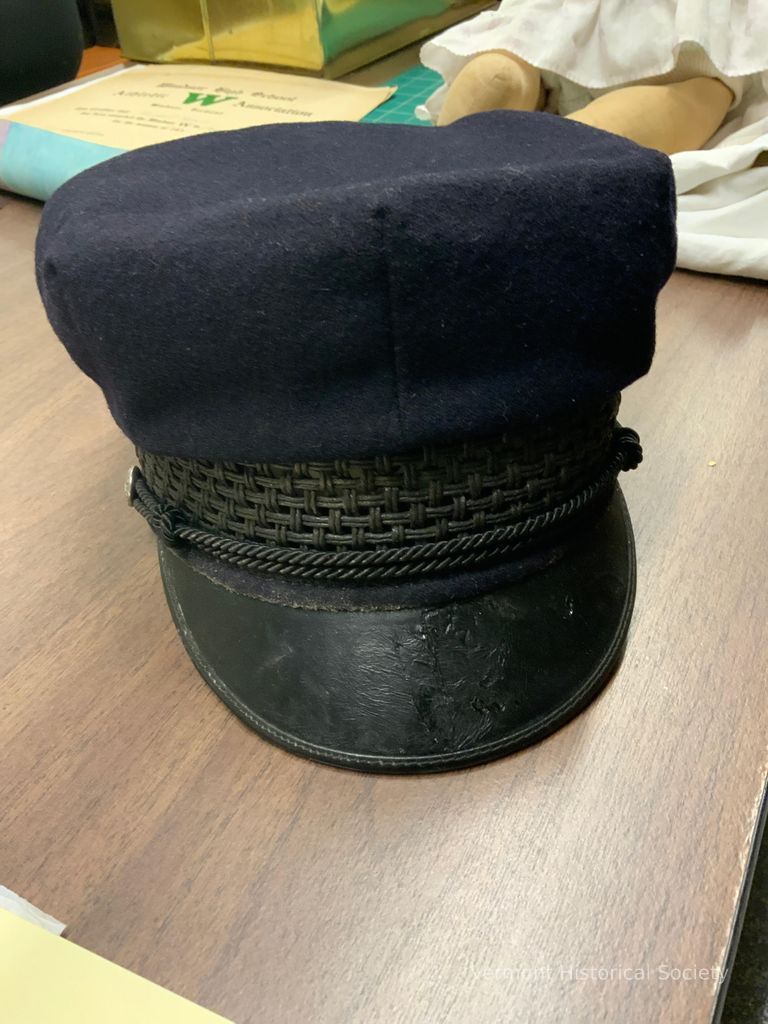
Conductor Hat
Name/Title
Conductor Hat
Lexicon
Clothing/Dress/Costume Details
Article of Clothing/Dress/Costume
Hat
Textile Details
Blue
Color
Wool
Material
Clothing Sex
Male
Description
Train conductor's hat with silver buttons on either side bearing the initials of the Canadian National Railroad. The crown of the hat is formed of navy-blue felted wool. It has a wide band of black, basket-woven cords, and twisted cords of black or navy silk cross the front of the band, looping around the two silver side buttons. The hat has a round front brim covered and edged in thin leather.
Acquisition
Accession
2021.5
Relationships
Related Person or Organization
Canadian National Railway, Central Vermont Railway
Entry/Object ID
2021.5.1
Context
Worn by an employee of the Canadian National Express, which at one time operated within Vermont.
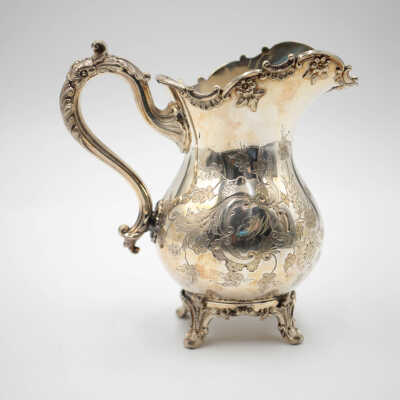

Cream Pitcher
Name/Title
Cream Pitcher
Lexicon
Description
Ornate silver cream pitcher. The pitcher is extensively decorated with applied molded flowers at the base, handle, and rim. The body is engraved with rococo-style scrollwork featuring oak leaves on the front and flowers on the back. A cartouche at the center front is engraved with the initials, "JW".
Acquisition
Accession
1972.58
Relationships
Related Person or Organization
Wilder, Jonas (1812-1906)
Person or Organization
Made/Created
Date made
1858
Manufacturer
Rogers & Bro.
Dimensions
Dimension Description
Overall
Materials
Material
Silver
Entry/Object ID
1972.58.1e
Context
Given as a retirement gift to Jonas Wilder, who invented the first refrigerated railroad car for transporting butter from Vermont to Boston.
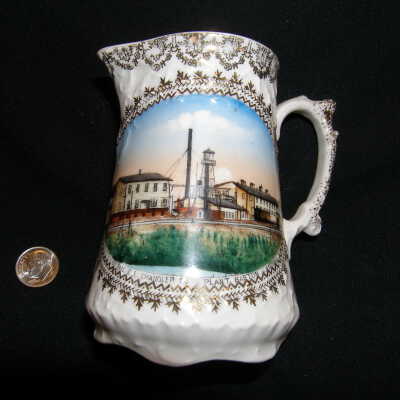

Cream Pitcher
Name/Title
Cream Pitcher
Lexicon
Description
Small white porcelain cream pitcher. The pitcher is printed with a full color illustration of an industrial area consisting of multiple factory buildings, a tall chimney tower, and a water tower, with a railroad and a green space separating the area from water. The image is labeled, "A Section of the E. L. Chandler Co's Plant, Barton Landing, Vt." The images is surrounded with a decorative gilded frame in an oak leaf pattern and the top edge of the pitcher is similarly gilded. The bottom is marked, "Wheelock Vienna Austria" and "Made in Austria for Whipple, French & Co., Barton Landing, Vt. Vienna".
Acquisition
Accession
2005.21
Relationships
Related Person or Organization
Cleveland, Eugene R. (1911-2005), Whipple, French & Co., E. L. Chandler Company
Related Places
Place
Barton
Town
Orleans County
County
Vermont
State/Province
United States of America
Country
North America
Made/Created
Date made
1890-1928
Dimensions
Dimension Description
Overall
Materials
Material
Porcelain
Entry/Object ID
2005.21.11
Context
Sold by Whipple, French, & Co. in Barton Landing, Vermont

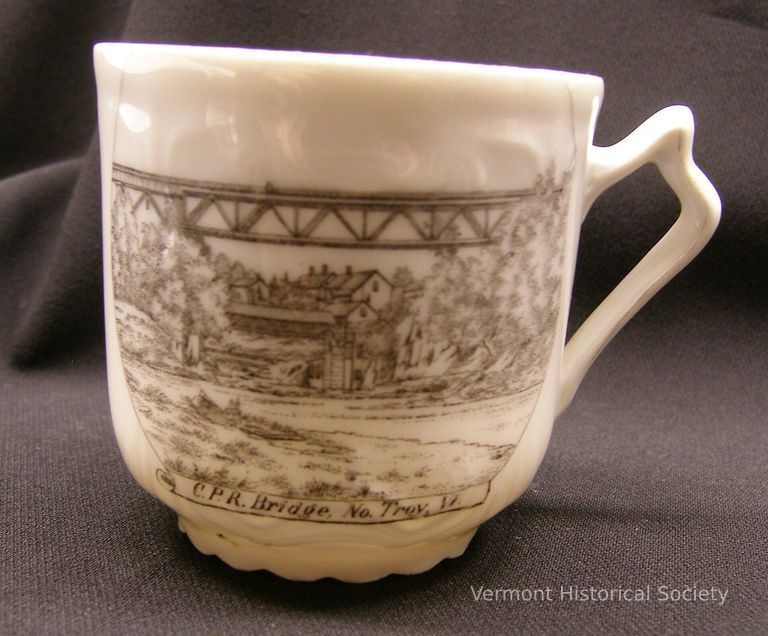
Demitasse Cup
Name/Title
Demitasse Cup
Lexicon
Description
Small white porcelain cup printed with a landscape image showing a metal railroad bridge spanning a river gorge. There are multiple buildings, including a mill, in the background. The image is labeled, "C.P.R. Bridge, No. Troy, Vt." The bottom of the cup is marked, "Made in Germany for A. A. Seaver, No. Troy, Vt."
Acquisition
Accession
2012.36
Relationships
Related Person or Organization
A. A. Seaver
Person or Organization
Related Places
Place
North Troy
Village
Troy
Town
Orleans County
County
Vermont
State/Province
United States of America
Country
North America
Made/Created
Date made
1905-1910
Dimensions
Dimension Description
Overall
Materials
Material
Porcelain
Entry/Object ID
2012.36.5
Context
Sold by A. A. Seaver in North Troy, Vermont

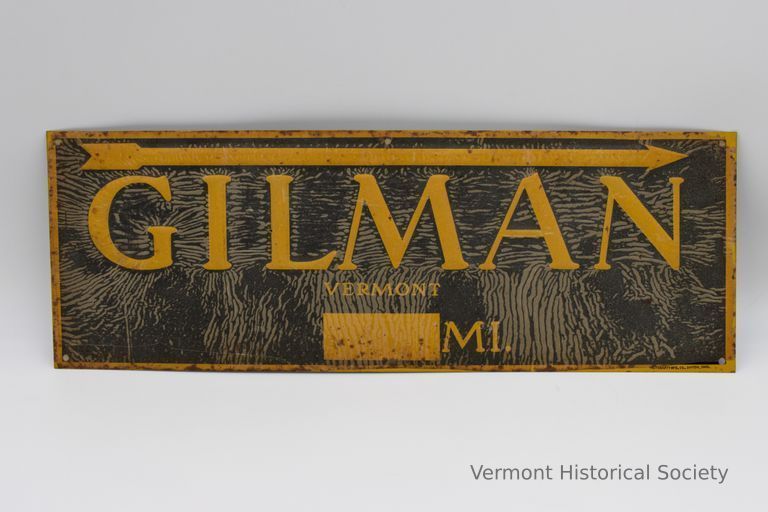
Directional Sign
Name/Title
Directional Sign
Lexicon
Description
Rectangular metal road sign. The side is printed with yellow lettering on a black ground that reads, "GILMAN / VERMONT" beneath a right-pointing arrow. There is a yellow rectangle for writing the distance followed by "MI". Protective tissue paper applied by the manufacturer is still attached to the face of the sign, indicating it was never hung.
Acquisition
Accession
2022.70
Relationships
Related Places
Place
Gilman
Village
Lunenberg
Town
Essex County
County
Vermont
State/Province
United States of America
Country
North America
Materials
Material
Metal, Paper
Entry/Object ID
2022.70.7
Context
Likely produced for use at a railroad station.
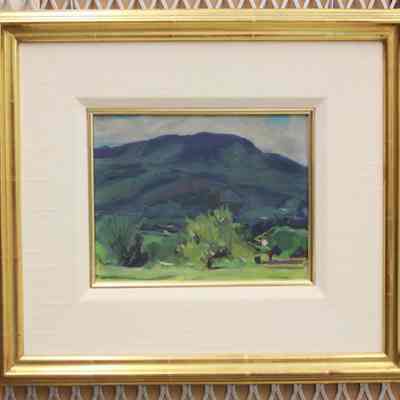
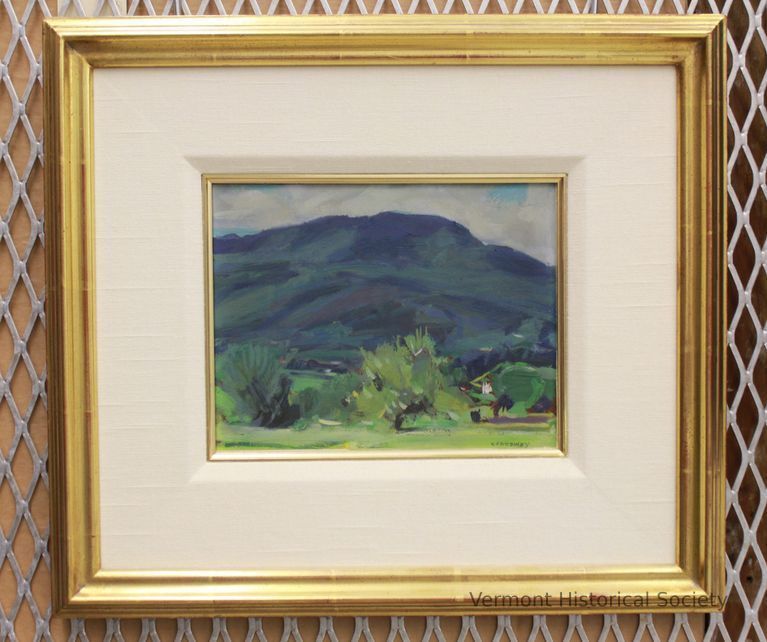
Dorset Mountains
Name/Title
Dorset Mountains
Lexicon
Description
Vibrant green and blue landscape dominated by a large mountain in the background with a small strip of clouded sky. The foreground depicts a lush, green valley with hints of structures and light green tree in the center. Modern label on the back indicates the title as, "Dorset Mountains."
Acquisition
Accession
2017.12
Artwork Details
Medium
Oil
Made/Created
Artist Information
Connaway, Jay Hall (1893-1970)
Artist
Date made
1965-1969
Entry/Object ID
2017.12.3
Context
Jay Connaway was born in Liberty, Indiana, November 27, 1893, the son of Cass Connaway, a lawyer and collector of Chinese art, and his wife May. Jay Connaway graduated from Emmerich Manual High School and undertook his first art training from William Forsyth, known for coastal Oregon views, at John Herron School of Art in Indianapolis in 1910 and 1911. Connaway left home to tour the California and Oregon coasts, working his way across the country and then back to the East Coast as a stoker on engines for the Atchison, Topeka, and Santa Fe Railroad.
In New York, Connaway enrolled at the National Academy of Design school in 1912. From 1912 to 1914 he attended the Art Student's League at New York City, where he studied with George Bridgman and with William Merritt Chase. Another influence was Robert Henri, a New York Social Realist and leader of the Ashcan School, whom Connaway had met while attending night classes at the National Academy.
In 1917 he enlisted and shipped out to Contrexeville, France. After suffering a shoulder wound, he worked as a cartographer. Then he was assigned to what he called "the most wonderful work of my life"—making detailed watercolor drawings of lesions caused by mustard gas. This brought him to the attention of Lafayette Page, a physician who was so impressed with Connaway's draftsmanship that, at the close of the war, he sponsored his studies at the Académie Julian (1919–20) under Jean Paul Laurens and at the École des Beaux-Arts (1921) in Paris.
With backing from collectors and gallery owners, Connaway, "seeking to paint the lonely sea" found his way to uninhabited Head Harbor Island off the coast of Jonesport, Maine where he lived as an artistic hermit. He later worked dories with a Grand Banks fishing fleet, was also a cook for a lumber camp in Maine, and he enlisted in the Coast Guard.
In 1928 Connaway married Louise Boehle. During the depression, Connaway moved to Monhegan Island to paint and start the Connaway Art School.
The Connaways remained on Monhegan until 1947, when they moved to Vermont, residing in Dorset until 1953, then North Rupert. Connaway painted rural landscapes of the Vermont countryside and operated a summer art school, until 1966.
In 1962, Connaway merged his school with the Southern Vermont Arts Center and became the school's first director. During the 1960s, in addition to managing the art school Connaway painted in Portugal, Spain, California, and Arizona. In the last year of his life, troubled with poor eyesight and failing health, Connaway was no longer able to paint.
In New York, Connaway enrolled at the National Academy of Design school in 1912. From 1912 to 1914 he attended the Art Student's League at New York City, where he studied with George Bridgman and with William Merritt Chase. Another influence was Robert Henri, a New York Social Realist and leader of the Ashcan School, whom Connaway had met while attending night classes at the National Academy.
In 1917 he enlisted and shipped out to Contrexeville, France. After suffering a shoulder wound, he worked as a cartographer. Then he was assigned to what he called "the most wonderful work of my life"—making detailed watercolor drawings of lesions caused by mustard gas. This brought him to the attention of Lafayette Page, a physician who was so impressed with Connaway's draftsmanship that, at the close of the war, he sponsored his studies at the Académie Julian (1919–20) under Jean Paul Laurens and at the École des Beaux-Arts (1921) in Paris.
With backing from collectors and gallery owners, Connaway, "seeking to paint the lonely sea" found his way to uninhabited Head Harbor Island off the coast of Jonesport, Maine where he lived as an artistic hermit. He later worked dories with a Grand Banks fishing fleet, was also a cook for a lumber camp in Maine, and he enlisted in the Coast Guard.
In 1928 Connaway married Louise Boehle. During the depression, Connaway moved to Monhegan Island to paint and start the Connaway Art School.
The Connaways remained on Monhegan until 1947, when they moved to Vermont, residing in Dorset until 1953, then North Rupert. Connaway painted rural landscapes of the Vermont countryside and operated a summer art school, until 1966.
In 1962, Connaway merged his school with the Southern Vermont Arts Center and became the school's first director. During the 1960s, in addition to managing the art school Connaway painted in Portugal, Spain, California, and Arizona. In the last year of his life, troubled with poor eyesight and failing health, Connaway was no longer able to paint.

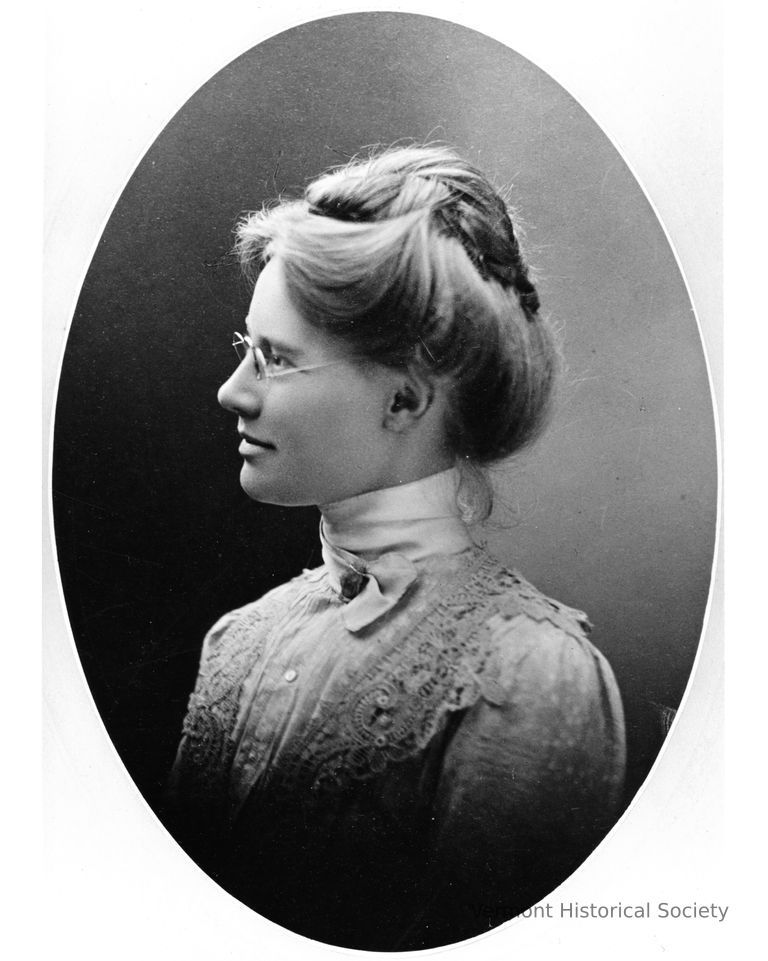
Elmer, Rachael Robinson (1878-1919)
Name/Title
Elmer, Rachael Robinson (1878-1919)
Description
Born: January 28, 1878 in Ferrisburgh, Vermont
Died: February 12, 1919 in New York, New York
Primary Residence: Ferrisburgh
Noted artist and book illustrator. Member of the Robinson family, the Quaker family that lived at Rokeby (now a museum and National Historic Landmark in Ferrisburgh, Vermont).
Died: February 12, 1919 in New York, New York
Primary Residence: Ferrisburgh
Noted artist and book illustrator. Member of the Robinson family, the Quaker family that lived at Rokeby (now a museum and National Historic Landmark in Ferrisburgh, Vermont).
Relationships
Related Person or Organization
Elmer, Rachel Robinson (1878-1919)
Person or Organization
Biographical Information
Education
Goddard Seminary
Art Students League, NYC
Biography
Descended from English Quaker immigrants established in Rhode Island, Rachael Robinson Elmer was the daughter of skilled artist and writer, Rowland Evans Robinson and accomplished artist, Anna Stevens Robinson. She was raised on the family farm, Rokeby, in Ferrisburgh, Vermont within sight of Lake Champlain and the Adirondack Mountains. Contrary to the usual upbringing of a young girl at the time, Elmer, although quite knowledgeable and capable when it came to "women's work," was not bound by household duties and the usual laborious tasks expected of females on a working farm in the 1900s. Throughout her childhood, her parents recognized and encouraged their oldest child to develop her artistic abilities by spending hours exploring and sketching the flora, fauna, animals and birds on the many acres surrounding the family farm.
As a Quaker, hard work, family and community were at the core of Elmer's life. The Robinson family, along with the Quaker community in general, helped many black fugitives along the underground railroad en route to Canada and refused to use foodstuffs and other merchandise grown and/or produced with slave labor.
At the age of twelve, Elmer was recognized as a child prodigy for her artistic ability. While attending the Chautauqua Art League, she was invited by the director to study drawing in New York City. For three years, she spent a month in New York. When she was sixteen, she left her family home to study at Goddard Seminary boarding school in Barre, Vermont. She graduated at eighteen, and began teaching art students at home and in Burlington. For three winters, she studied at the Art Students' League in New York under such notable teachers as Childe Hassam, Robert Henri and William Merritt Chase.
Elmer's father, Rowland Robinson, was an author of several books portraying 19th century country life. He illustrated his books until he became blind. At this time, Rachael began to illustrate for her father. Her illustrations appear in "Hunting Without a Gun", which was published after her father's death.
Throughout her career as an artist, Elmer lived in New York City where she necessarily adhered to society's requirements and standards for young ladies living and working away from home and family - she located acceptable boarding establishments and wrote almost daily to her mother with assurances of safe room and board and financial accountability. Elmer continued her classes at the Art Students League, began working for a firm called Decorative Designers and eventually became associated with Harper & Brothers, the American Book Company and P. F. Volland & Co. Elmer designed book covers, as well as illustrations for magazines and books and also undertook commissioned portraitures. She "signed" her covers and illustrations with two "R's" placed back to back.
Elmer established a thriving career through her determination and abilities. Even after meeting and marrying Robert F. Elmer, a New York Businessman and widower with two grown children, in October 17, 1911, she successfully combined married life with her artistic endeavors.
Rachael Robinson Elmer later illustrated for "John Bunyan's Dream Story", "Dutch Fairy Tales", historical readers put out by the American Book Company, and a series of poems by Caroline Hofman called the, "Wee Winkles" series. She also designed postcards of New York City tourist attractions, and mastered the craft of linoleum block printing. These cards were issued in 1916, and received wide publicity.
Elmer became very involved with the war effort during the First World War. Both she and her husband opened their home to entertain servicemen. She visited the sick and wounded in area hospitals and added some much-needed cheerfulness by drawing life size posters on the servicemen's canteen walls.
Elmer's life was cut short when she contracted influenza while volunteering at the Red Cross during the 1918-1919 influenza epidemic that killed hundreds of thousands around the world. Today, Rokeby is a museum and National Historic Landmark honoring the Robinsons, "a remarkable family of Quakers, farmers, abolitionists, authors, and artists."
Occupation
Artist
Writer
Entry/Object ID
1.1.32
Web Links and URLs

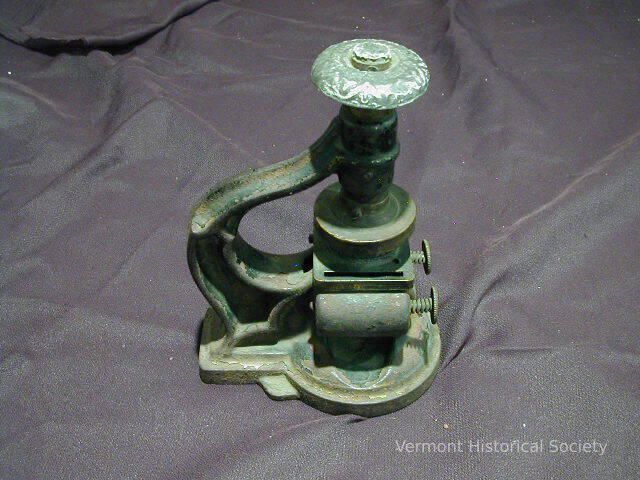
Embossing Press
Name/Title
Embossing Press
Lexicon
Description
Iron embossing stamp. The stamp consists of an ear-shaped metal arm spanning between a square base pedestal and a round stamp head. The top press button is stamped into a decorative floral pattern.
Use
Used to stamp the dates into railroad tickets.
Acquisition
Accession
1972.61
Relationships
Related Person or Organization
Woodstock Railway
Person or Organization
Related Places
Place
Woodstock
Town
Windsor County
County
Vermont
State/Province
United States of America
Country
North America
Made/Created
Time Period
19th Century
Dimensions
Dimension Description
Overall
Materials
Material
Iron
Entry/Object ID
1972.61.2
Context
Used on the Woodstock Railway
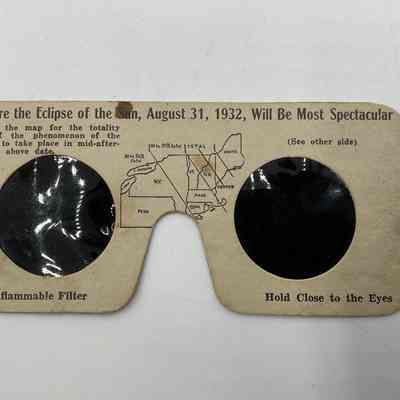

Eyeglasses
Name/Title
Eyeglasses
Lexicon
Description
Cardboard viewer to safely view the 1932 eclipse. Patented by Derick Studio in Orleans, Vt.
One side has a map showing where in New England and New York the best views will be, with the total eclipse forecast for the Northeastern corner of Vermont. The other side explains why an eclipse takes place and notes the safety of the filter for viewing the sun for extended periods without damage to the eyes.
One side has a map showing where in New England and New York the best views will be, with the total eclipse forecast for the Northeastern corner of Vermont. The other side explains why an eclipse takes place and notes the safety of the filter for viewing the sun for extended periods without damage to the eyes.
Use
For use to look at an eclipse.
Acquisition
Accession
2019.22
Relationships
Related Places
Place
Northeast Kingdom
Made/Created
Date made
1932
Manufacturer
Derick Studio
Dimensions
Materials
Material
Cardboard, Plastic
Entry/Object ID
2019.22.1
Context
Here is a 2017 write-up about the eclipse of 1932. The path of totality ran across the Northeast.
From: https://streetsofsalem.com/2017/08/20/the-great-new-england-eclipse-of-1932/
"This eclipse cut a diagonal swath through New England from Montreal to Provincetown, and people converged in the White Mountains, Cape Ann and Cape Cod for viewing: there were special eclipse “packages” and special eclipse trains, and more than one observer pointed out that the frenzy was serving as a distraction from the Depression. In Salem, the shops closed at 1:00 in the afternoon on the 31st (which was a Wednesday), as everyone departed for Gloucester–apparently not content to be in the 99% zone! The headlines leading up to the 1932 eclipse were not too different than those today: watch out for your eyes, watch out for your chickens (perhaps there was more emphasis on chickens then), the best viewing places, why the scientists are so excited. I do think there was more “eclipse ephemera” produced then, but it was a period of paper.
The viewing experience seems to have been uneven across New England on August 31, 1932: clouds and rain prevailed in some places, inspiring my favorite September 1 headlines: Long Awaited Eclipse is Partially Eclipsed (or some variation thereof). I have no doubt that people had fun on the New Haven Railroad’s special Eclipse Train, however, on which they could see night-time when it’s day in New England as you play. Strange things were reported for days afterwards: chickens (very sensitive to eclipses, apparently) laid eggs that bore an imprint of the corona, which appeared on several glass windows around the region as well. In my hometown of York Harbor, Maine, the artist Henry Russell Butler, who had traveled across the country in order to capture the previous three eclipses on canvas, was thrilled to see one appear in his backyard. Photography had long been able to capture eclipses, but paint still worked too."
From: https://streetsofsalem.com/2017/08/20/the-great-new-england-eclipse-of-1932/
"This eclipse cut a diagonal swath through New England from Montreal to Provincetown, and people converged in the White Mountains, Cape Ann and Cape Cod for viewing: there were special eclipse “packages” and special eclipse trains, and more than one observer pointed out that the frenzy was serving as a distraction from the Depression. In Salem, the shops closed at 1:00 in the afternoon on the 31st (which was a Wednesday), as everyone departed for Gloucester–apparently not content to be in the 99% zone! The headlines leading up to the 1932 eclipse were not too different than those today: watch out for your eyes, watch out for your chickens (perhaps there was more emphasis on chickens then), the best viewing places, why the scientists are so excited. I do think there was more “eclipse ephemera” produced then, but it was a period of paper.
The viewing experience seems to have been uneven across New England on August 31, 1932: clouds and rain prevailed in some places, inspiring my favorite September 1 headlines: Long Awaited Eclipse is Partially Eclipsed (or some variation thereof). I have no doubt that people had fun on the New Haven Railroad’s special Eclipse Train, however, on which they could see night-time when it’s day in New England as you play. Strange things were reported for days afterwards: chickens (very sensitive to eclipses, apparently) laid eggs that bore an imprint of the corona, which appeared on several glass windows around the region as well. In my hometown of York Harbor, Maine, the artist Henry Russell Butler, who had traveled across the country in order to capture the previous three eclipses on canvas, was thrilled to see one appear in his backyard. Photography had long been able to capture eclipses, but paint still worked too."

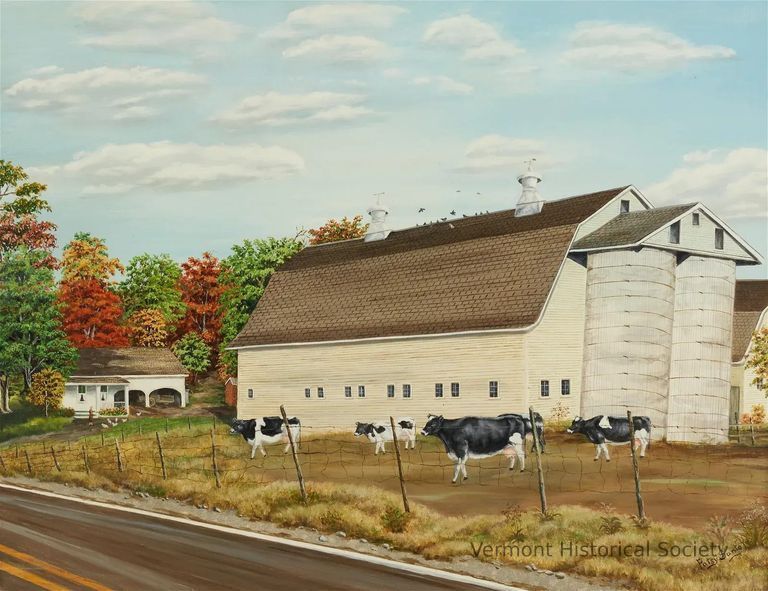
Farm Route 67 with Cows, Autumn
Name/Title
Farm Route 67 with Cows, Autumn
Type of Painting
Lexicon
Description
Oil painting of a farm on Vermont Route 67 with cows in autumn by Patsy Santo. The painting features a paved road with a double yellow center line in the closest foreground and a slightly golden-tinged fenced-in pasture with black and white cattle just behind it. The pale yellow barn has a brown shingle roof and white silos on the near side, and a white farmhouse peeks out of the fall-tinged trees on the left middle ground. The blue sky above has scattered puffy clouds. The painting is signed "Patsy Santo in the lower right corner and resides in a painted and gilt wooden frame.
Acquisition
Accession
2024.10
Relationships
Related Person or Organization
Santo, Pasquale "Patsy" (1893-1975)
Person or Organization
Artwork Details
Medium
Oil on Canvas
Subject
Dairy farm; Route 67
Made/Created
Artist Information
Santo, Pasquale "Patsy" (1893-1975)
Artist
Date made
1960-1970
Dimensions
Entry/Object ID
2024.10.1
Context
Patsy Santo pursued a number of professional activities after emigrating to this country from Italy in 1913. He worked for the railroad and as a housepainter. His first artistic effort was an outgrowth of one of his house painting jobs; his second was undertaken at the request of a friend. He did not follow up on these sporadic endeavors until many years later, however, when one of his paintings took first prize at the 1937 state fair in Rutland, Vermont. This brought Santo his first patron and inspired him to start painting in earnest. Other exhibitions followed. His introduction to the New York art world was about as auspicious as any folk painter could hope for. He debuted, with Grandma Moses, Morris Hirshfield, and a number of others, in a 1939 members-only showing at the Museum of Modern Art. His first one-man show at the Marie Harriman Gallery the following year was a virtual sell-out. His paintings were acquired by the Whitney Museum and the Museum of Modern Art. Sidney Janis included him in his book, "They Taught Themselves," observing that Santo, unlike most self-taught painters, evidenced continuing stylistic development.
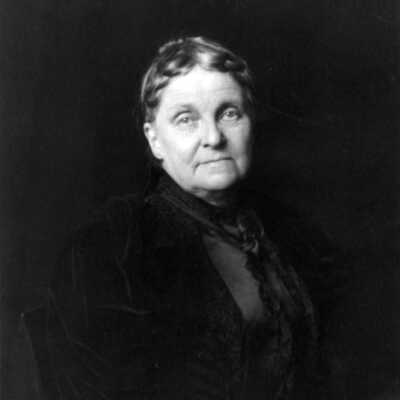
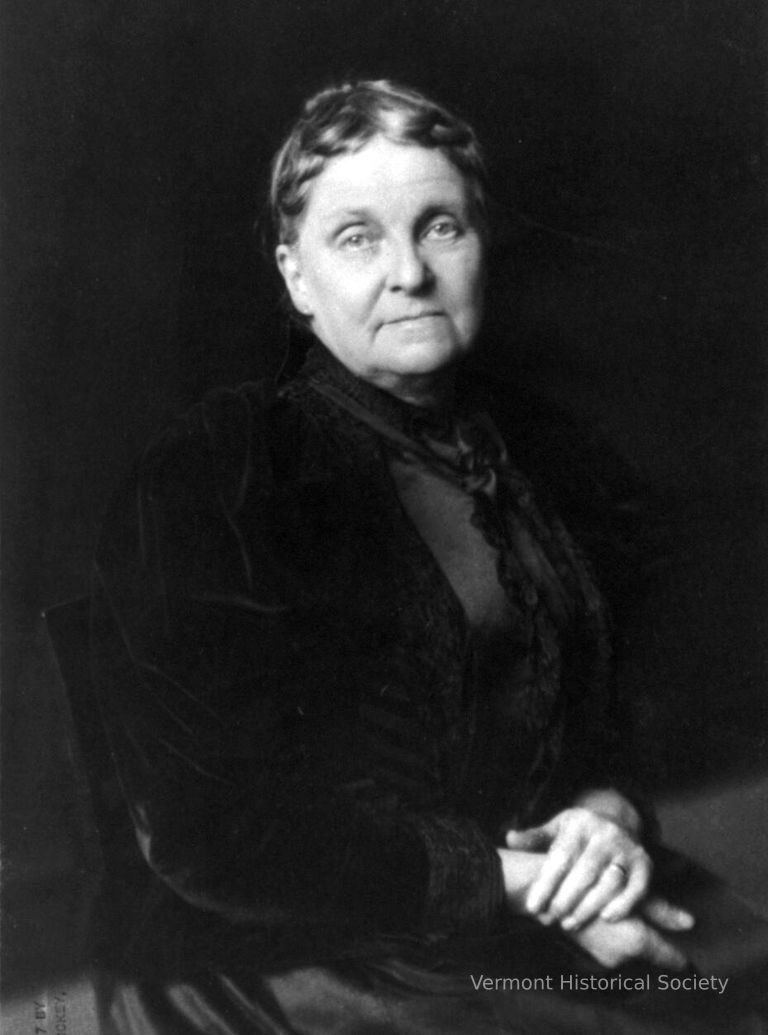
Green, Henrietta Howland Robinson (1834-1916)
Name/Title
Green, Henrietta Howland Robinson (1834-1916)
Also Known As
Hetty Green
Description
Born: November 21, 1834 in New Bedford, Massachusetts
Died: July 3, 1916 in New York, New York
Primary Residence: Bellows Falls
Astute businesswoman and investor. Reportedly the wealthiest woman in the world at the time of her death in 1916. Nicknamed ""The Witch of Wall Street"" because of her extreme frugality and its effects on her family.
Died: July 3, 1916 in New York, New York
Primary Residence: Bellows Falls
Astute businesswoman and investor. Reportedly the wealthiest woman in the world at the time of her death in 1916. Nicknamed ""The Witch of Wall Street"" because of her extreme frugality and its effects on her family.
Biographical Information
Biography
Henrietta "Hetty" Green was born in New Bedford, Massachusetts, in 1834 and had a Quaker upbringing. She was the daughter of Edward Robinson, who controlled the Isaac Howland Jr. Company, a wealthy whaling firm. Green grew up around business and learned about money, investments and the stock market at a young age. Her father died in 1865 and left her as the sole heiress of $1,000,000 in cash and $4,500,000 in real estate. Two weeks later, her aunt Sylvia died, whom Green had lived with as a teenager. Green received a portion of her aunt's estate, but she contested the will with a document confirming that she was sole inheritor. When the case was brought to court, Green was accused of forging signatures, but eventually the case was dropped.
Green married her financial advisor, Edward Green of Bellows Falls, Vermont, and initially the couple moved to London. Although Green denied it, they may have left the country to escape forgery charges stemming from the failed lawsuit. When they returned to the United States in 1875, the couple and their two children, Ned and Sylvia, lived with Edward Green's mother in Bellows Falls. Green invested in railroads, real estate, and goverment bonds while continuing to be extremely frugal with her money.
Stories about Green's frugality abounded, including that she paid her laundress less than others by ordering her to wash only the section of her dresses that trailed on the ground. While she dressed her children in patched, oversize clothing, her income was between five and ten thousand dollars a day. Her frugality may have had damaging effects on her son Ned's health. When he was fourteen, he dislocated his knee and Green sought free medical help. When she was asked to pay, she refused treatment for him. Five years later, he had another accident with the same knee and his leg had to be amputated. The doctor reported that had Ned received proper medical care with his first injury, the amputation would not have been necessary. When the media learned of this incident, she was dubbed "The Witch of Wall Street" for her cruelty.
Edward Green was a wealthy man, but he had fallen into debt. Hetty Green wanted to transfer her $25,000,000 in securities from the John J. Cisco and Son Banking House to the Chemical National Bank, but her request was refused because of her husband's debts. She eventually paid the $422,143.22 he owed, but separated from him because she could not tolerate his poor business investments. Green continued to build her fortune through railroad stocks and mortgages. She purchased large quantities of real estate, including two square miles in the west side of Chicago, owned docks in San Francisco, and held mortgages on numerous buildings. By 1900, she had a yearly income of $7,000,000 and by 1908 she was worth $158,000,000. With age, Green grew increasingly paranoid that people would kill her for her money. She moved frequently and stayed in cheap boarding houses or hotels. However, when her husband grew ill, she nursed him until his death in 1902. Green died in 1916 and left her $150 million estate to her son and daughter. At that time, she was considered the wealthiest woman in the world.
Occupation
Businesswoman
Investor
Entry/Object ID
1.1.40
Web Links and URLs
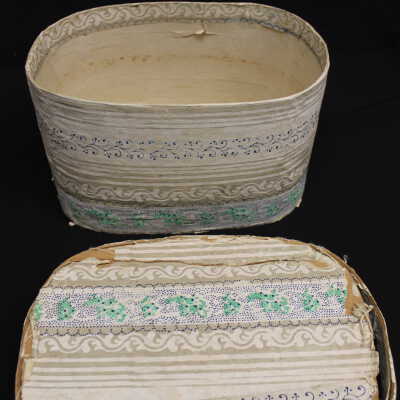

Hatbox
Name/Title
Hatbox
Lexicon
Description
Oval bandbox and lid covered in wallpaper. The wallpaper has a striped design in grey, beige, white, blue, and green. The stripes have different floral patterns, some resembling lace. The lid interior and base of the box are lined with sheets of newspaper that mention Lyndon, Passumpsic Railroad, the Bank of Orleans, Greensboro, Cabot, Lunenburg, Danville, and Wheelock."
Acquisition
Accession
1993.14
Made/Created
Date made
1850-1860
Dimensions
Materials
Material
Cardboard, Paper, Wood, String
Entry/Object ID
1993.14.3a-b


Henry Bridge
Name/Title
Henry Bridge
Type of Painting
Description
A framed painting of a landscape with a red covered bridge spanning a flowing river, flanked by lush green trees on either side, while a grassy riverbank stretches into the foreground. A low dam with flowing water can be seen under the bridge. A man stands with a horse at the river's edge.
Painting is identified as the Henry Covered Bridge in North Bennington by Pasquale Santo. Signed "Patsy Santo" in yellow lower right.
Painting is identified as the Henry Covered Bridge in North Bennington by Pasquale Santo. Signed "Patsy Santo" in yellow lower right.
Acquisition
Accession
2024.25
Artwork Details
Medium
Oil
Subject
Henry Covered Bridge
Made/Created
Artist Information
Santo, Pasquale "Patsy" (1893-1975)
Artist
Date made
1946
Entry/Object ID
2024.25.1
Context
Patsy Santo pursued a number of professional activities after emigrating to this country from Italy in 1913. He worked for the railroad and as a housepainter. His first artistic effort was an outgrowth of one of his house painting jobs; his second was undertaken at the request of a friend. He did not follow up on these sporadic endeavors until many years later, however, when one of his paintings took first prize at the 1937 state fair in Rutland, Vermont. This brought Santo his first patron and inspired him to start painting in earnest. Other exhibitions followed. His introduction to the New York art world was about as auspicious as any folk painter could hope for. He debuted, with Grandma Moses, Morris Hirshfield, and a number of others, in a 1939 members-only showing at the Museum of Modern Art. His first one-man show at the Marie Harriman Gallery the following year was a virtual sell-out. His paintings were acquired by the Whitney Museum and the Museum of Modern Art. Sidney Janis included him in his book, "They Taught Themselves," observing that Santo, unlike most self-taught painters, evidenced continuing stylistic development.
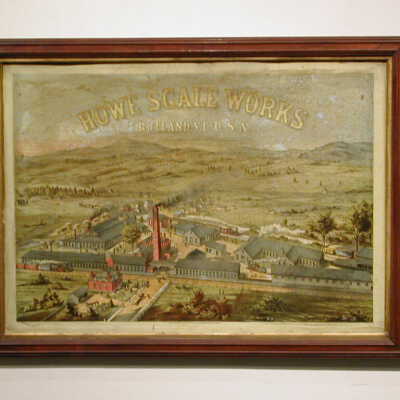

Howe Scale Works
Name/Title
Howe Scale Works
Lexicon
Description
Print on tin showing a bird's eye view of a factory complex. The complex is set within a triangular block and consists of several blue or grey warehouses and a red factory with a tall chimney. The complex is bordered on two sides by railroad tracks, and there is an additional track inside the complex. There is a residential building in the foreground, a small village in the middleground, and grassy hills in the background. The words "HOWE SCALE WORKS / RUTLAND, V.T. U.S.A." are in the sky.
Acquisition
Accession
1984.7
Relationships
Related Person or Organization
Howe Scale, Co. (1857-1982)
Person or Organization
Artwork Details
Medium
Ink, Metal
Subject
Howe Scale Company
Made/Created
Date made
1880-1890
Manufacturer
Kellogg & Bulkeley Company
Dimensions
Entry/Object ID
1984.7.1
Context
The history of the Howe Scale Company begins with Frank M. Strong of Vergennes and Thomas Ross designing and patenting a ball bearing scale for the Sampson Scale Company of Vergennes. Prior to this invention, the sharp pivot on which the platform of the scale rests would become worn down with repeated use, thus causing the scale to lose accuracy over time. The ball-bearing design provided a shock absorber for the pivot to reduce stress on the scale and improve its accuracy. This was the first major scale improvement in America and the first major innovation by Strong and Ross, the second being the building in 1857 of a gigantic scale for weighing canal boats, a feat that experts said was impossible.
In Spring 1857 John Howe Jr. of Brandon took over Strong and Ross's patents and began to manufacture their designs under the name Howe Scale Company. The Howe Scale Company became world-renowned, earning several awards at fairs and exhibitions, including the the gold, silver, and bronze medals at the 1867 Paris Exhibition against competitors from all over the world.
In 1873 the plant was moved to Rutland, with John A. Mead of Rutland becoming president in 1886, followed by Carl B. Hinsman and Frank G. Riehl. The Howe Scale Company went on to manufacture the weightograph, a device which produces weight readings on a ground glass screen that can be read in the dark from some distance away. It also produced the longest railroad track scale in the world, scales for weighing airplane propellors, and lightweight, aluminum scales that were easily transportable on airplanes. It also began producing trucks and tailers for cargo, and this became an important part of the company's product line. The Howe Scale Company continued to be a leader in the manufactuer of high-accuracy weighing instruments into the twentieth century.
In Spring 1857 John Howe Jr. of Brandon took over Strong and Ross's patents and began to manufacture their designs under the name Howe Scale Company. The Howe Scale Company became world-renowned, earning several awards at fairs and exhibitions, including the the gold, silver, and bronze medals at the 1867 Paris Exhibition against competitors from all over the world.
In 1873 the plant was moved to Rutland, with John A. Mead of Rutland becoming president in 1886, followed by Carl B. Hinsman and Frank G. Riehl. The Howe Scale Company went on to manufacture the weightograph, a device which produces weight readings on a ground glass screen that can be read in the dark from some distance away. It also produced the longest railroad track scale in the world, scales for weighing airplane propellors, and lightweight, aluminum scales that were easily transportable on airplanes. It also began producing trucks and tailers for cargo, and this became an important part of the company's product line. The Howe Scale Company continued to be a leader in the manufactuer of high-accuracy weighing instruments into the twentieth century.
Web Links and URLs
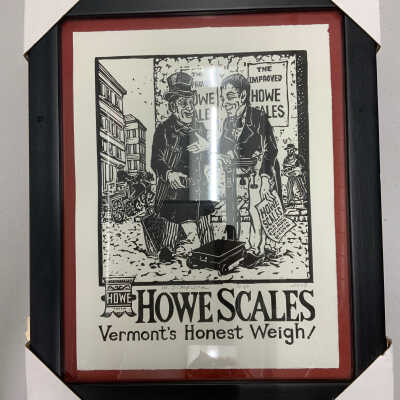
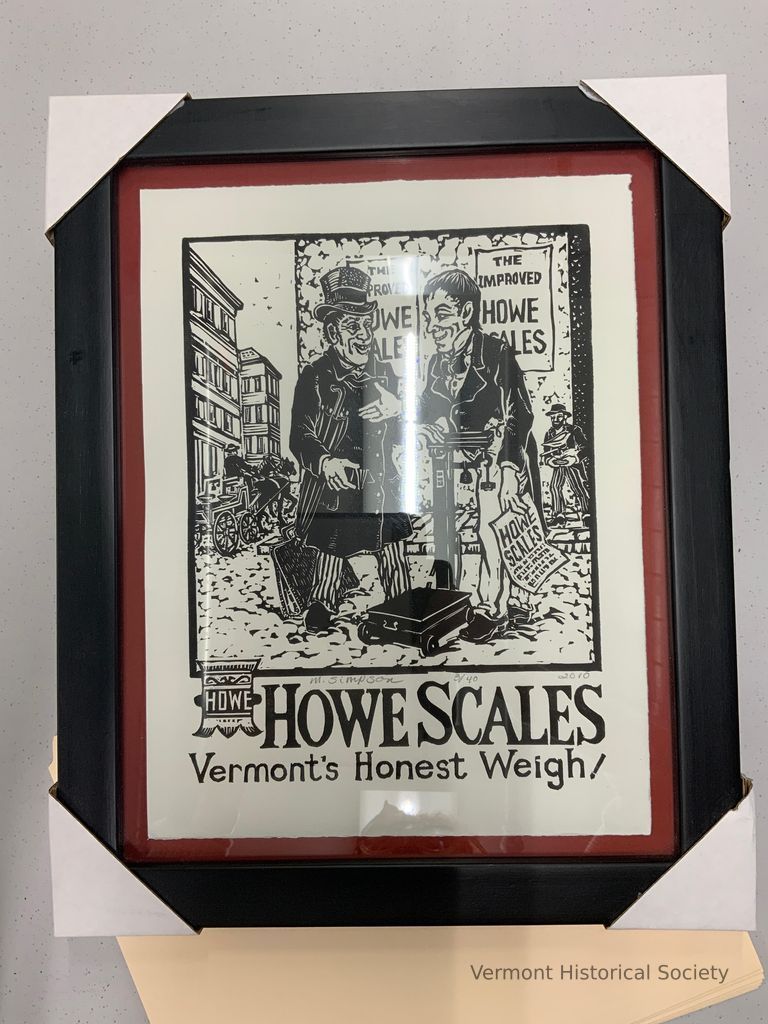
Howe Scales
Name/Title
Howe Scales
Lexicon
Description
Wood block print in black ink on white paper showing a man demonstrating a platform scale on a city street. The salesman is wearing a tailcoat and holding a poster that reads, “HOWE SCALES”. He is gesturing to a man in a top hat who is holding a wallet in one hand and touching the scale with the other. He is standing in striped pants in front of a leaning briefcase on his leg. There are posters for Howe Scales with inscriptions, "THE/IMPROVED/HOWE/SCALES," a man holding a tabletop scale, and a cart toting scales in the background. The bottom of the image is labeled, “HOWE SCALES / Vermont’s Honest Weigh!” with a Howe logo. It is signed in pencil above the label, “M. Simpson 3/40 2010”. The print is top mounted onto dark red mat board and framed behind glass in a black wooden frame.
Acquisition
Accession
2022.21
Relationships
Related Events
Vermont History Expo
Event
Related Person or Organization
Howe Scale, Co. (1857-1982)
Person or Organization
Artwork Details
Medium
Ink
Subject
Howe Scale Company
Made/Created
Artist Information
Simpson, Mary Gorham (b.1945)
Artist
Date made
2010
Dimensions
Dimension Description
Overall
Entry/Object ID
2022.21.7
Context
The history of the Howe Scale Company begins with Frank M. Strong of Vergennes and Thomas Ross designing and patenting a ball bearing scale for the Sampson Scale Company of Vergennes. Prior to this invention, the sharp pivot on which the platform of the scale rests would become worn down with repeated use, thus causing the scale to lose accuracy over time. The ball-bearing design provided a shock absorber for the pivot to reduce stress on the scale and improve its accuracy. This was the first major scale improvement in America and the first major innovation by Strong and Ross, the second being the building in 1857 of a gigantic scale for weighing canal boats, a feat that experts said was impossible.
In Spring 1857 John Howe Jr. of Brandon took over Strong and Ross's patents and began to manufacture their designs under the name Howe Scale Company. The Howe Scale Company became world-renowned, earning several awards at fairs and exhibitions, including the the gold, silver, and bronze medals at the 1867 Paris Exhibition against competitors from all over the world.
In 1873 the plant was moved to Rutland, with John A. Mead of Rutland becoming president in 1886, followed by Carl B. Hinsman and Frank G. Riehl. The Howe Scale Company went on to manufacture the weightograph, a device which produces weight readings on a ground glass screen that can be read in the dark from some distance away. It also produced the longest railroad track scale in the world, scales for weighing airplane propellors, and lightweight, aluminum scales that were easily transportable on airplanes. It also began producing trucks and tailers for cargo, and this became an important part of the company's product line. The Howe Scale Company continued to be a leader in the manufactuer of high-accuracy weighing instruments into the twentieth century.
Currently residing in Lyndonville, Mary Gorham Simpson was born in northern Vermont and raised on a working dairy farm in Burke. After graduating from Lyndon State College, she and her husband, Wilder Simpson, taught school in the area for several years, then moved west. They lived for seven years in Wyoming and 14 years in Alaska, returning to Vermont in 1992.
While raising her three children, Simpson took art classes and worked on her own in various media - drawing, calligraphy, and painting. In Alaska, she worked as a graphic artist for the Imaginarium Science Center in Anchorage and as a scenic artist for the Alaska Festival Theater and Anchorage Civic Opera. She did scrimshaw for two shops and exhibit calligraphy for three years for the Anchorage Museum of History and Art.
Now back in Vermont, she mostly works as a printmaker with subjects reflecting memories of Vermont agriculture.
In Spring 1857 John Howe Jr. of Brandon took over Strong and Ross's patents and began to manufacture their designs under the name Howe Scale Company. The Howe Scale Company became world-renowned, earning several awards at fairs and exhibitions, including the the gold, silver, and bronze medals at the 1867 Paris Exhibition against competitors from all over the world.
In 1873 the plant was moved to Rutland, with John A. Mead of Rutland becoming president in 1886, followed by Carl B. Hinsman and Frank G. Riehl. The Howe Scale Company went on to manufacture the weightograph, a device which produces weight readings on a ground glass screen that can be read in the dark from some distance away. It also produced the longest railroad track scale in the world, scales for weighing airplane propellors, and lightweight, aluminum scales that were easily transportable on airplanes. It also began producing trucks and tailers for cargo, and this became an important part of the company's product line. The Howe Scale Company continued to be a leader in the manufactuer of high-accuracy weighing instruments into the twentieth century.
Currently residing in Lyndonville, Mary Gorham Simpson was born in northern Vermont and raised on a working dairy farm in Burke. After graduating from Lyndon State College, she and her husband, Wilder Simpson, taught school in the area for several years, then moved west. They lived for seven years in Wyoming and 14 years in Alaska, returning to Vermont in 1992.
While raising her three children, Simpson took art classes and worked on her own in various media - drawing, calligraphy, and painting. In Alaska, she worked as a graphic artist for the Imaginarium Science Center in Anchorage and as a scenic artist for the Alaska Festival Theater and Anchorage Civic Opera. She did scrimshaw for two shops and exhibit calligraphy for three years for the Anchorage Museum of History and Art.
Now back in Vermont, she mostly works as a printmaker with subjects reflecting memories of Vermont agriculture.
Web Links and URLs


Jewelry Box
Name/Title
Jewelry Box
Lexicon
Description
A metal case in the shape of cross-cut section of a railroad track rail with a red velvet interior. The silver top says, "SOUVENIR 28th NATL. ENCAMPMENT. G.A.R." Four pictures are also etched on the metal top. The top one looks like a factory and has the words “Glass House” and perhaps another word underneath. The top center image shows a cannon and a row of tents. The lower center image is of some kind of tower. The bottom image is of mills and the word steel is visible on the left side.
Acquisition
Accession
1953.52
Relationships
Related Person or Organization
Grand Army of the Republic
Person or Organization
Related Places
Place
Pittsburgh
City
Pennsylvania
State/Province
United States of America
Country
North America
Made/Created
Date made
1894
Manufacturer
Grand Army of the Republic
Dimensions
Dimension Description
Overall
Materials
Material
Steel, Silk
Entry/Object ID
1953.52.21
Context
The Grand Army of the Republic (GAR) was a fraternal organization for veterans of the Union Army in the Civil War.
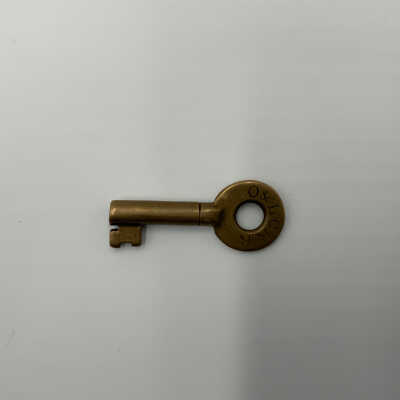

Key
Name/Title
Key
Lexicon
Description
Key with round head. The head is labeled "O & L C R R" on one side. The side opposite the head has a small portion that sticks outward with two prongs.
Acquisition
Accession
2021.5
Relationships
Related Person or Organization
Ogdensburg and Lake Champlain Railroad
Person or Organization
Materials
Material
Bronze
Entry/Object ID
2021.5.24
Context
Labeled for the Ogdensburg and Lake Champlain Railroad

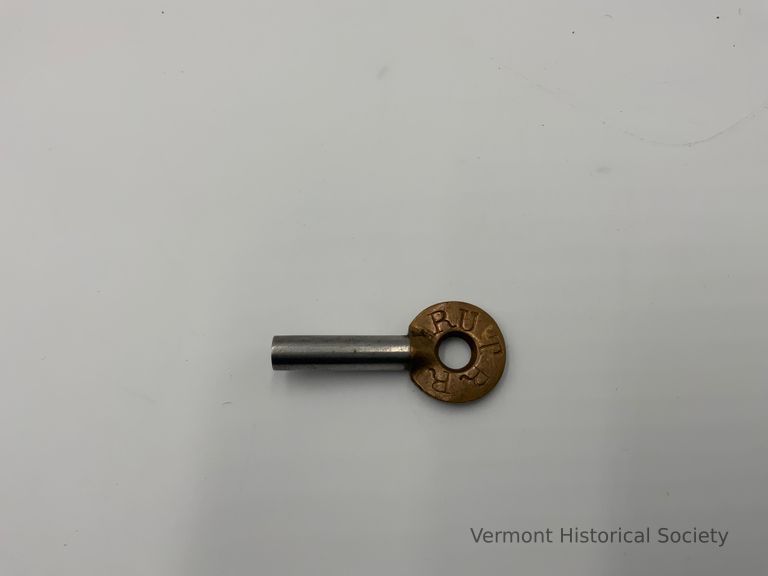
Key
Name/Title
Key
Lexicon
Description
Key with round head. The head is stamped with the label "RUT R R" on one side and "48" on the other side. The end opposite the head has a rectangular hole where the key would be. The shaft is hollow.
Acquisition
Accession
2021.5
Relationships
Related Person or Organization
Rutland Railroad
Person or Organization
Materials
Material
Metal
Entry/Object ID
2021.5.26
Context
Labeled for the Rutland Railroad
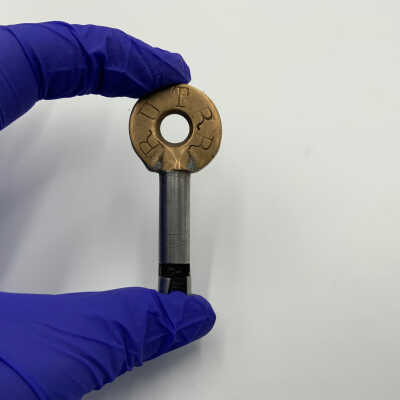
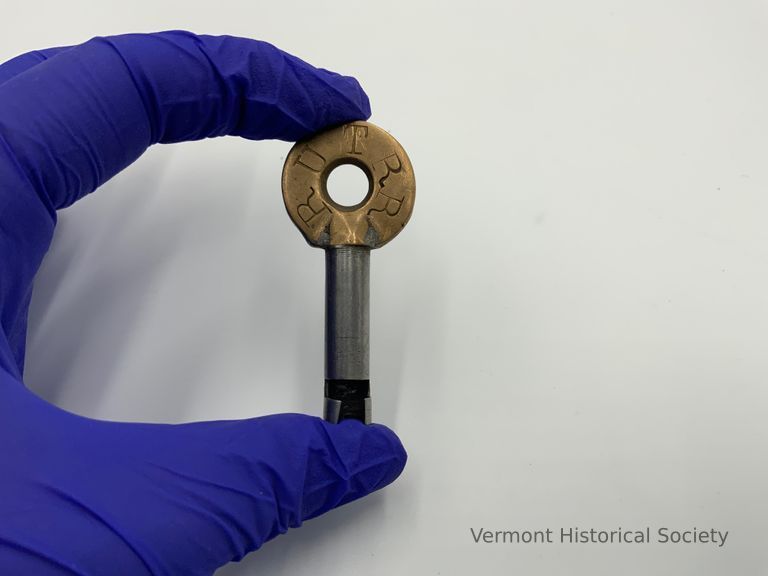
Key
Name/Title
Key
Description
Key with round head. The head is stamped with the label "RUT R R" on one side and "26" on the other side. The end opposite the head has a rectangular hole where the key would be. The shaft is hollow.
Acquisition
Accession
2021.5
Relationships
Related Person or Organization
Rutland Railroad
Person or Organization
Materials
Material
Bronze, Iron
Entry/Object ID
2021.5.25
Context
Labeled for the Rutland Railroad
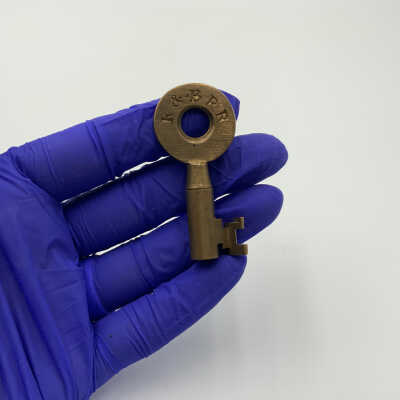
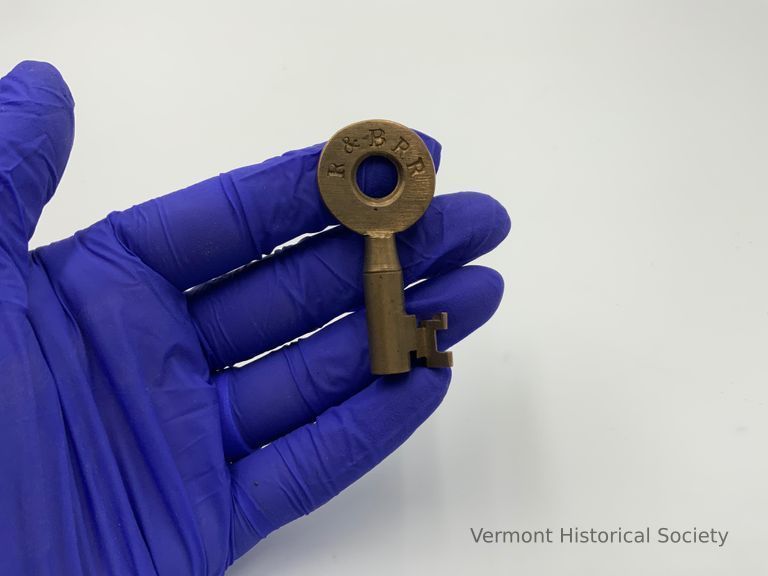
Key
Name/Title
Key
Description
Key with round head. The head is stamped with the label "R & B R R" on one side and "WILLIAMS & PAGE" on the other side. The end opposite the head has a protruding bit with two widely set wards.
Acquisition
Accession
2021.5
Relationships
Related Person or Organization
Rutland and Burlington Railroad
Person or Organization
Materials
Material
Bronze
Entry/Object ID
2021.5.27
Context
Labeled for Rutland and Bennington Railroad
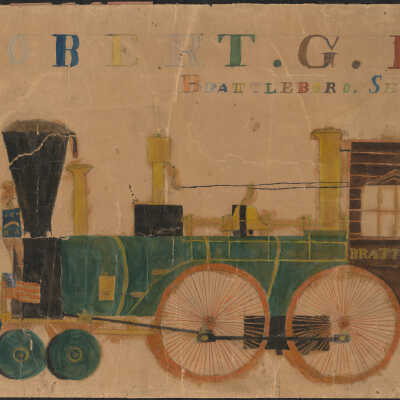

Locomotive Brattleboro
Name/Title
Locomotive Brattleboro
Type of Painting
Lexicon
Description
Naive watercolor painting showing a train engine and tender from the side. The engine is painted green with a large front chimney, high orange wheels, and a black cabin labeled, "BRATTLEBORO". The tender is green with an orange top, red wheels, and the yellow label, "V. &. M. R. R." There are two small United States flags at the front of the engine. The top of the image is labeled "ROBERT. G. HARDIE. Jr. / Brattleboro. Sept. 30. 1863." Each letter and number is painted in a different color.
Acquisition
Accession
1958.1
Relationships
Related Person or Organization
Vermont and Massachusetts Railroad
Person or Organization
Artwork Details
Medium
Watercolor
Made/Created
Artist Information
Hardie, Robert Gordon (1854-1904)
Artist
Date made
1863
Dimensions
Dimension Description
Overall
Entry/Object ID
1958.1.1632
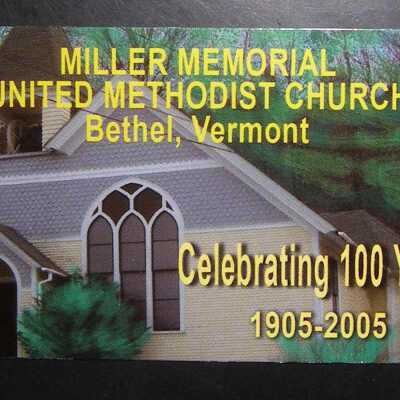

Magnet
Name/Title
Magnet
Lexicon
Description
Rectangular magnet with "MILLER MEMORIAL/ UNITED METHODIST CHURCH / Bethel, Vermont / Celebrating 100 Years / 1905 - 2005" The yellow writing is superimposed over a photograph of the church.
Acquisition
Accession
2005.44
Relationships
Related Places
Place
Bethel
Town
Windsor County
County
Vermont
State/Province
United States of America
Country
North America
Made/Created
Date made
2005-2005
Manufacturer
Miller Memorial United Methodist Church
Dimensions
Materials
Material
Plastic, Magnet
Entry/Object ID
2005.44
Context
This church was built in 1905. Here is a bit of Bethel history that notes the construction of new churches.
(Source: https://townofbethelvt.com/index.asp?SEC=521041EA-7D21-4547-B4DE-F502747A9E43)
"Bethel Village sustained its "Golden Age" from the late 1880’s until the early 1920’s and developed an industrial character. The three largest industries of the era—the shoe shop, the tannery and the white granite quarry and cutting sheds—flourished because of the ease of railroad transportation, the availability of local workers and the influx of European immigrants skilled in granite extraction, cutting and sculpting. During this period Bethel proudly enhanced its community with major cultural and civic improvements including the town hall, the first high school and library, electric lighting, new churches, and civic and business organizations. Main street businesses thrived as they supported the many needs of the community. By 1910, the town population grew to 1,953 with nearly 50% of the citizens residing in the Village."
(Source: https://townofbethelvt.com/index.asp?SEC=521041EA-7D21-4547-B4DE-F502747A9E43)
"Bethel Village sustained its "Golden Age" from the late 1880’s until the early 1920’s and developed an industrial character. The three largest industries of the era—the shoe shop, the tannery and the white granite quarry and cutting sheds—flourished because of the ease of railroad transportation, the availability of local workers and the influx of European immigrants skilled in granite extraction, cutting and sculpting. During this period Bethel proudly enhanced its community with major cultural and civic improvements including the town hall, the first high school and library, electric lighting, new churches, and civic and business organizations. Main street businesses thrived as they supported the many needs of the community. By 1910, the town population grew to 1,953 with nearly 50% of the citizens residing in the Village."
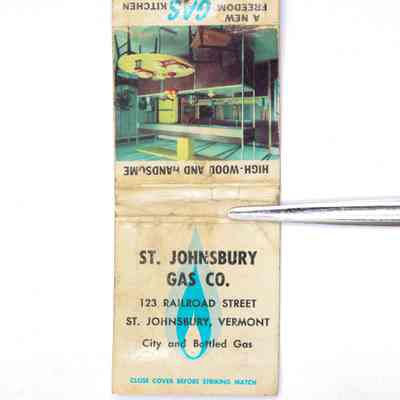

Matchbook
Name/Title
Matchbook
Lexicon
Description
White cardboard bifold matchbook. The front flap is printed with the inscription, "ST. JOHNSBURY GAS CO. 123 RAILROAD STREET ST. JOHNSBURY, VERMONT City and Bottled Gas".
The back is printed with the inscription, "HIGH-WOOD AND HANDSOME / A NEW FREEDOM GAS KITCHEN", with a full-color photograph of a midcentury kitchen.
The interior is printed with the inscription, "Another Example Of The Modernity Of GAS and GAS Appliances Featured In McCall's Cabinets by MUTSCHLER Designed by PAUL McCOBB Go Modern - Go GAS".
The back is printed with the inscription, "HIGH-WOOD AND HANDSOME / A NEW FREEDOM GAS KITCHEN", with a full-color photograph of a midcentury kitchen.
The interior is printed with the inscription, "Another Example Of The Modernity Of GAS and GAS Appliances Featured In McCall's Cabinets by MUTSCHLER Designed by PAUL McCOBB Go Modern - Go GAS".
Acquisition
Accession
1999.59
Relationships
Related Person or Organization
St. Johnsbury Gas Company
Person or Organization
Related Places
Place
St. Johnsbury
Town
Caledonia County
County
Vermont
State/Province
United States of America
Country
North America
Materials
Material
Cardboard
Entry/Object ID
1999.59.25
Context
Produced as an advertisement for St. Johnsbury Gas Company in St. Johnsbury, Vermont.

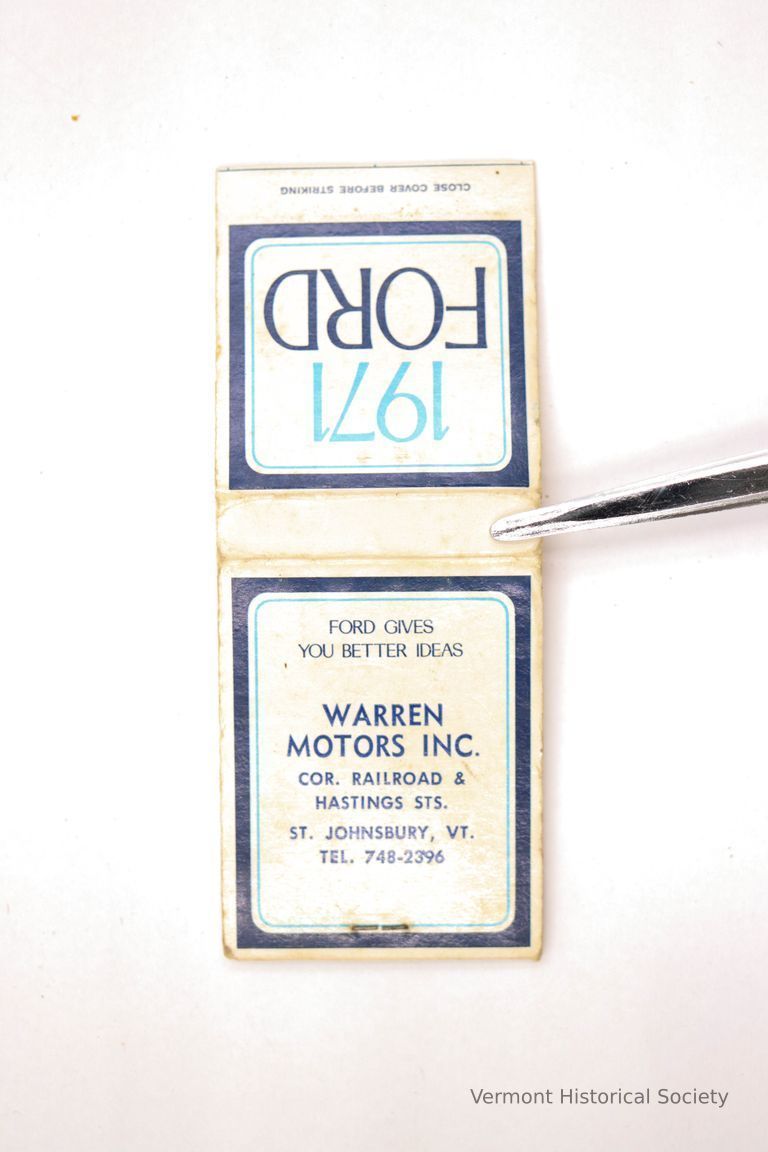
Matchbook
Name/Title
Matchbook
Lexicon
Description
White cardboard bifold matchbook. The front flap is printed with the inscription, "1971 FORD."
The back is printed with the inscription, "FORD GIVES YOU BETTER IDEAS / WARREN MOTORS INC. COR. RAILROAD & HASTINGS STS. ST. JOHNSBURY, VT. TEL. 748-2396."
The back is printed with the inscription, "FORD GIVES YOU BETTER IDEAS / WARREN MOTORS INC. COR. RAILROAD & HASTINGS STS. ST. JOHNSBURY, VT. TEL. 748-2396."
Acquisition
Accession
1999.59
Relationships
Related Person or Organization
Warren Motors, Inc.
Person or Organization
Related Places
Place
St. Johnsbury
Town
Caledonia County
County
Vermont
State/Province
United States of America
Country
North America
Materials
Material
Cardboard
Entry/Object ID
1999.59.61
Context
Produced as an advertisement for Warren Motors Inc. in Saint Johnsbury, Vermont.


Matchbook
Name/Title
Matchbook
Lexicon
Description
Narrow, white cardboard bifold matchbook. The front flap is printed with the inscription, "IMPEY INSURANCE AGENCY 107 Railroad St. St. Johnsbury Vt."
The back is printed with the inscription, "INSURANCE OF ALL KINDS Protection IS ALWAYS WORTH THE COST."
The back is printed with the inscription, "INSURANCE OF ALL KINDS Protection IS ALWAYS WORTH THE COST."
Acquisition
Accession
1999.59
Materials
Material
Cardboard
Entry/Object ID
1999.59.62
Context
Produced as an advertisement for Impey Insurance Agency in Saint Johnsbury, Vermont.

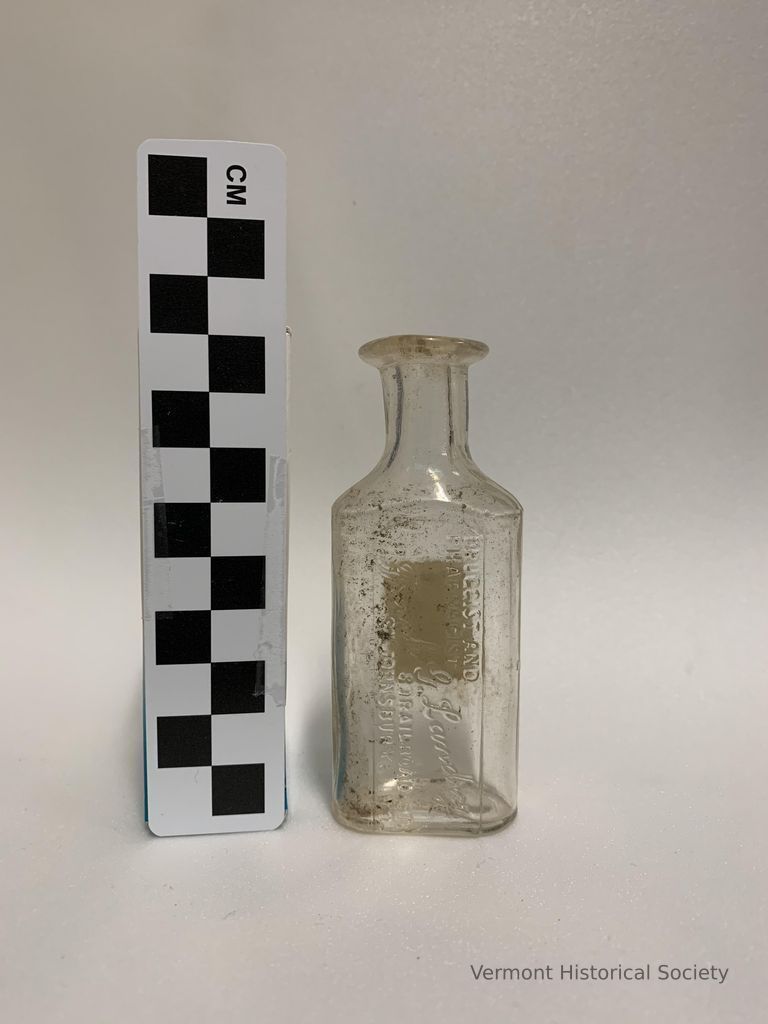
Medicine Bottle
Name/Title
Medicine Bottle
Lexicon
Description
Small, clear, molded glass bottle with the molded inscription "DRUGGIST AND/PHARMACIST/Frank G. Landry/83 RAILROAD ST./ST. JOHNSBURY, VT." Frank G. Landry is in cursive. Two paper stickers are on the reverse, one on top of the other, the top bearing the inked inscription, "6/20/72 / Srocker". The base bears a molded inscription that is largely illegible, but appears to read, "A-21".
Acquisition
Accession
2004.78
Made/Created
Manufacturer
Frank G. Landry
Dimensions
Dimension Description
Overall
Entry/Object ID
2004.78.14
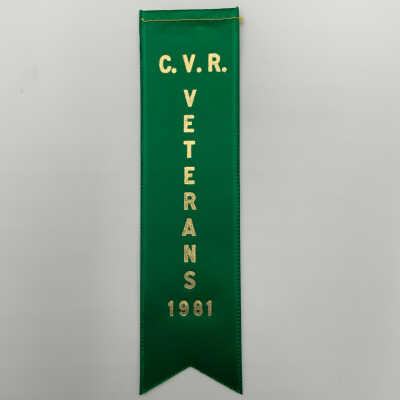
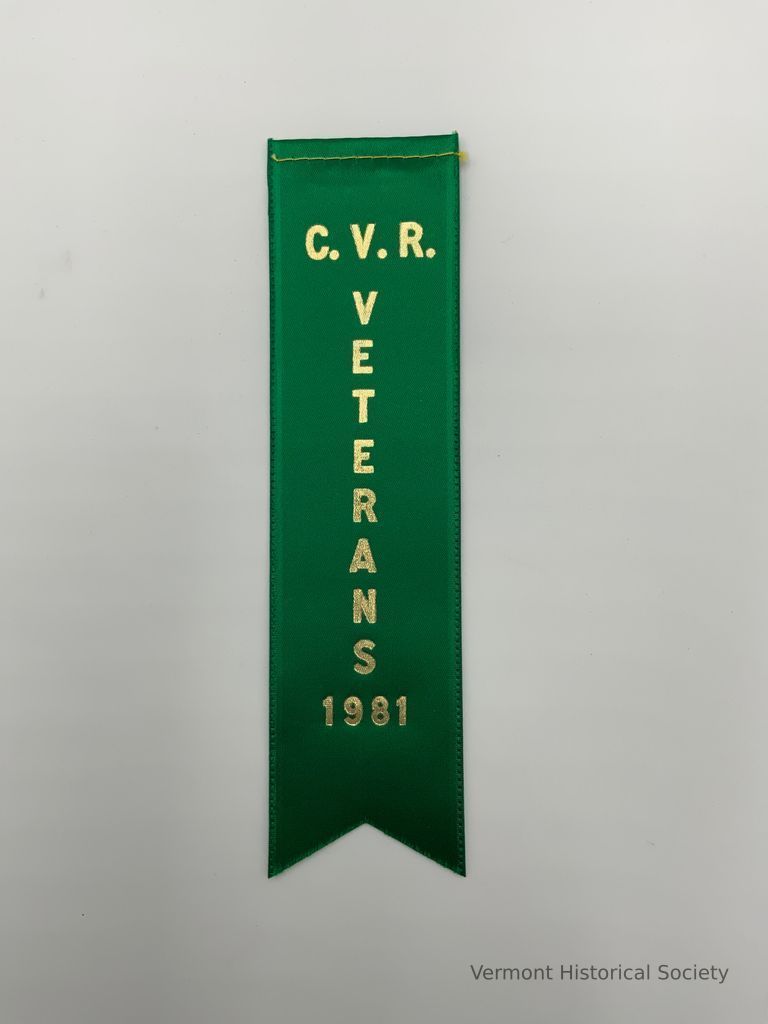
Membership Ribbon
Name/Title
Membership Ribbon
Lexicon
Description
Green satin-woven ribbon with the stamped inscription, "C. V. R. VETERANS 1981". The bottom is cut into two points, and there is a safety pin attached to the top back.
Acquisition
Accession
2021.5
Relationships
Related Person or Organization
LeCompte, Conrad Armand (1907-2003), Central Vermont Railway
Woven Textile Details
Weave Type
Satin Weave
Made/Created
Date made
1981
Entry/Object ID
2021.5.10
Context
Central Vermont Railroad ribbon given to Conrad LeCompte
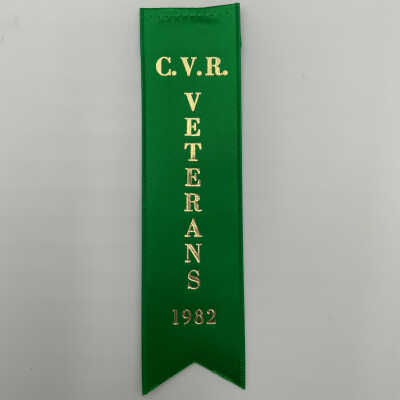
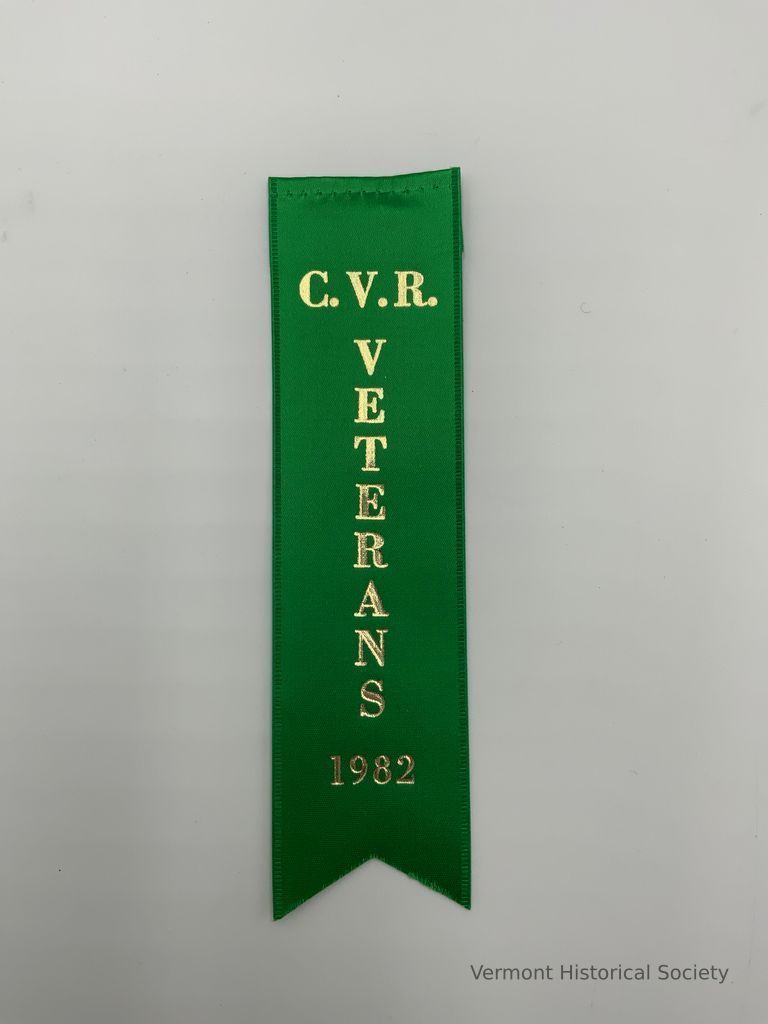
Membership Ribbon
Name/Title
Membership Ribbon
Lexicon
Description
Green satin-woven ribbon with the stamped inscription, "C. V. R. VETERANS 1982". The bottom is cut into two points, and there is a safety pin attached to the top back.
Acquisition
Accession
2021.5
Relationships
Related Person or Organization
LeCompte, Conrad Armand (1907-2003), Central Vermont Railway
Woven Textile Details
Weave Type
Satin Weave
Made/Created
Date made
1982
Entry/Object ID
2021.5.11
Context
Central Vermont Railroad ribbon given to Conrad LeCompte

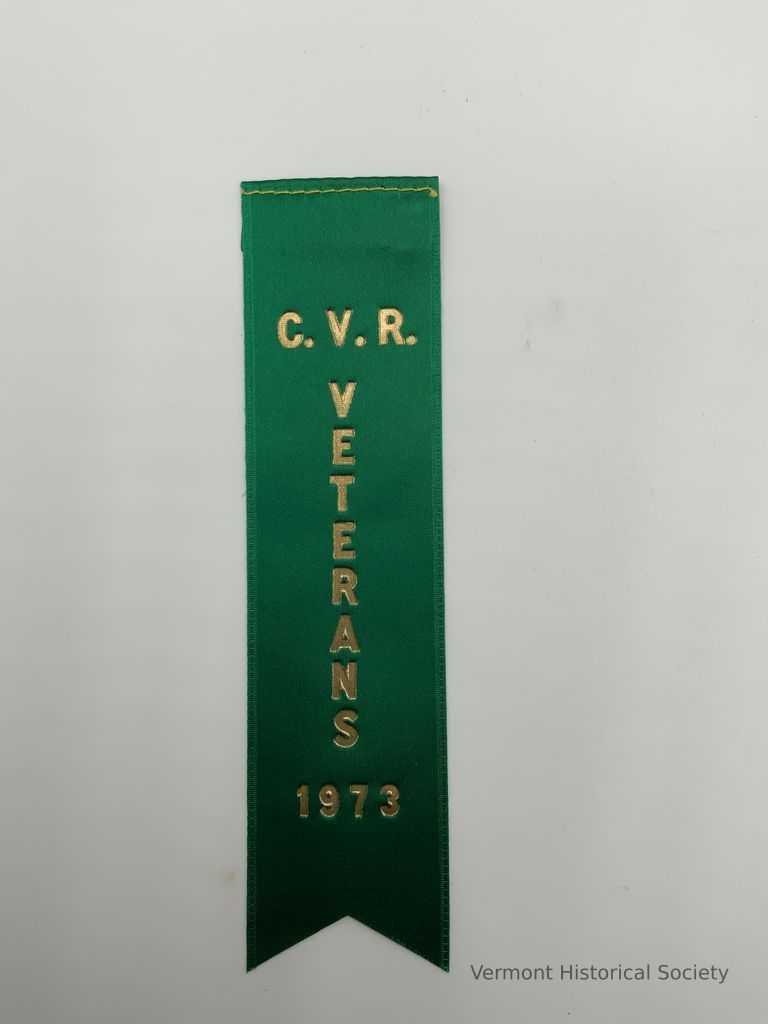
Membership Ribbon
Name/Title
Membership Ribbon
Lexicon
Description
Green satin-woven ribbon with the stamped inscription, "C. V. R. VETERANS 1973". The bottom is cut into two points, and there is a safety pin attached to the top back.
Acquisition
Accession
2021.5
Relationships
Related Person or Organization
Central Vermont Railway, LeCompte, Conrad Armand (1907-2003)
Woven Textile Details
Warp
Green
Warp Colors
Weave Type
Satin Weave
Made/Created
Date made
1973
Entry/Object ID
2021.5.3
Context
Central Vermont Railroad ribbon given to Conrad LeCompte.
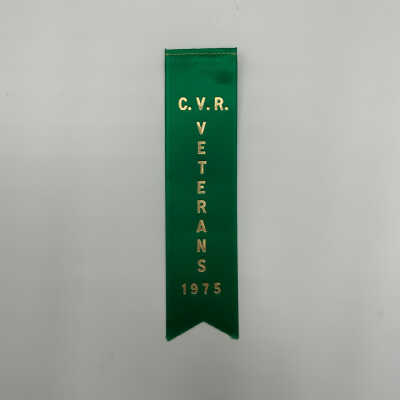
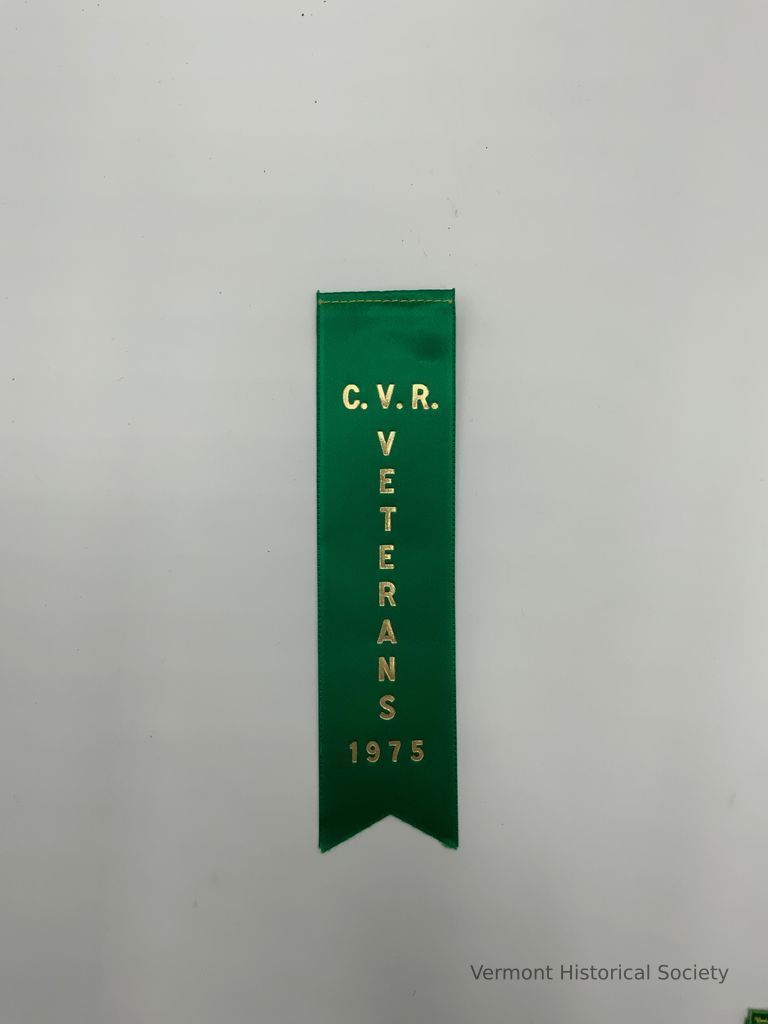
Membership Ribbon
Name/Title
Membership Ribbon
Lexicon
Description
Green satin-woven ribbon with the stamped inscription, "C. V. R. VETERANS 1975". The bottom is cut into two points, and there is a safety pin attached to the top back.
Acquisition
Accession
2021.5
Relationships
Related Person or Organization
LeCompte, Conrad Armand (1907-2003), Central Vermont Railway
Woven Textile Details
Weave Type
Satin Weave
Made/Created
Date made
1975
Entry/Object ID
2021.5.4
Context
Central Vermont Railroad ribbon given to Conrad LeCompte
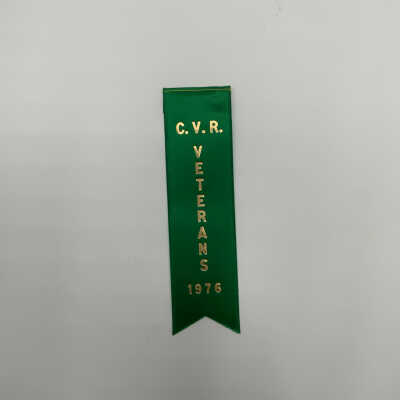

Membership Ribbon
Name/Title
Membership Ribbon
Lexicon
Description
Green satin-woven ribbon with the stamped inscription, "C. V. R. VETERANS 1976". The bottom is cut into two points, and there is a safety pin attached to the top back.
Acquisition
Accession
2021.5
Relationships
Related Person or Organization
LeCompte, Conrad Armand (1907-2003), Central Vermont Railway
Woven Textile Details
Weave Type
Satin Weave
Made/Created
Date made
1976
Entry/Object ID
2021.5.5
Context
Central Vermont Railroad ribbon given to Conrad LeCompte

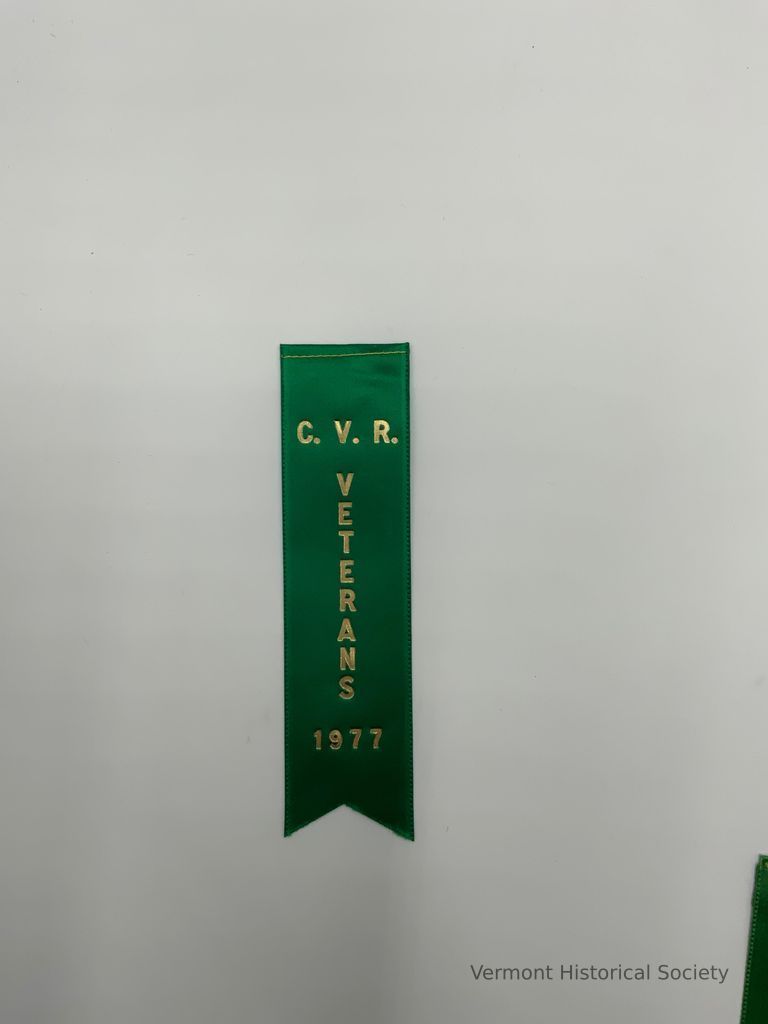
Membership Ribbon
Name/Title
Membership Ribbon
Lexicon
Description
Green satin-woven ribbon with the stamped inscription, "C. V. R. VETERANS 1977". The bottom is cut into two points, and there is a safety pin attached to the top back.
Acquisition
Accession
2021.5
Relationships
Related Person or Organization
LeCompte, Conrad Armand (1907-2003), Central Vermont Railway
Woven Textile Details
Weave Type
Satin Weave
Made/Created
Date made
1977
Entry/Object ID
2021.5.6
Context
Central Vermont Railroad ribbon given to Conrad LeCompte
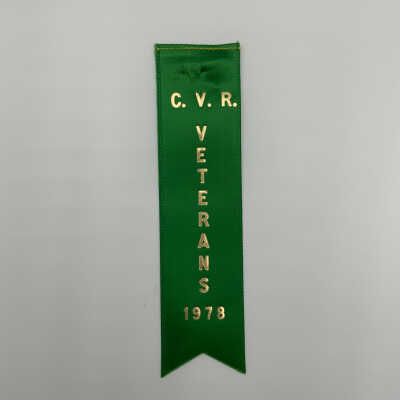
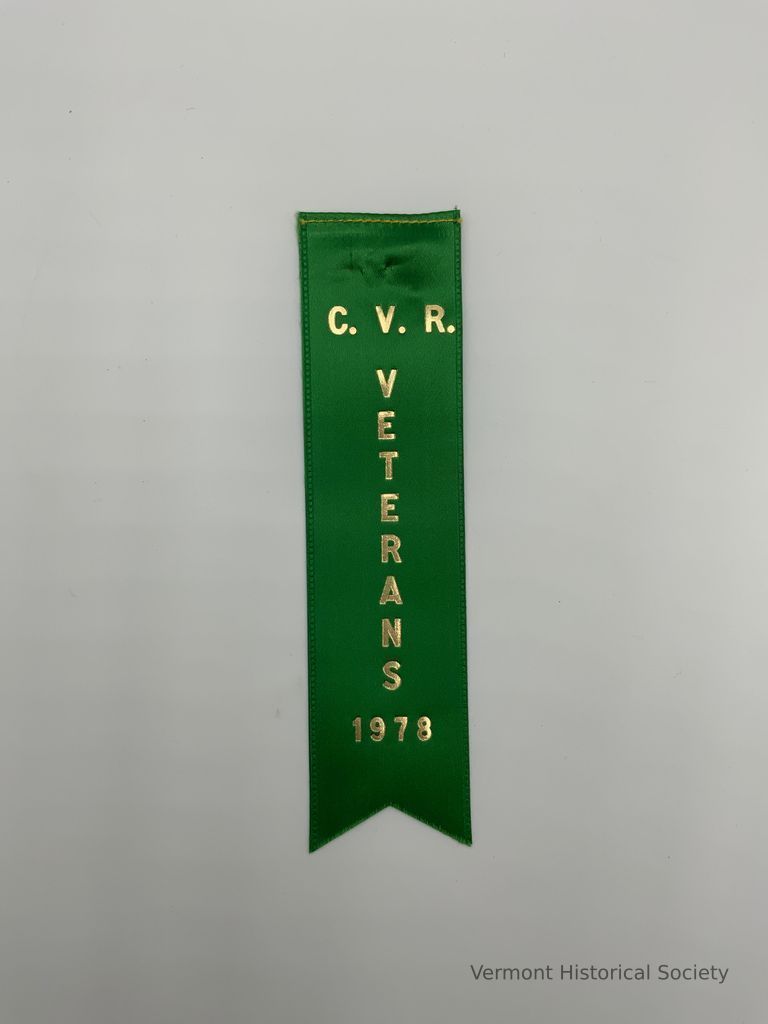
Membership Ribbon
Name/Title
Membership Ribbon
Lexicon
Description
Green satin-woven ribbon with the stamped inscription, "C. V. R. VETERANS 1978". The bottom is cut into two points, and there is a safety pin attached to the top back.
Acquisition
Accession
2021.5
Relationships
Related Person or Organization
LeCompte, Conrad Armand (1907-2003), Central Vermont Railway
Woven Textile Details
Weave Type
Satin Weave
Made/Created
Date made
1978
Entry/Object ID
2021.5.7
Context
Central Vermont Railroad ribbon given to Conrad LeCompte
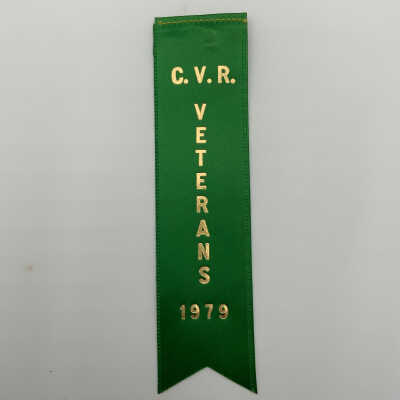
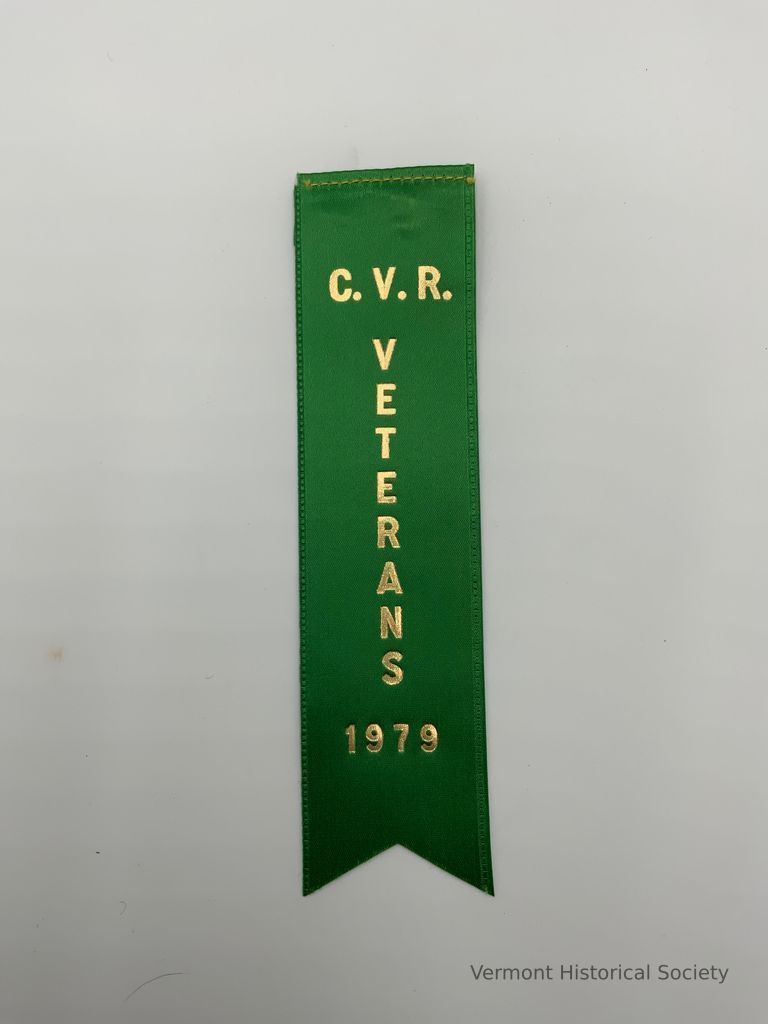
Membership Ribbon
Name/Title
Membership Ribbon
Lexicon
Description
Green satin-woven ribbon with the stamped inscription, "C. V. R. VETERANS 1979". The bottom is cut into two points, and there is a safety pin attached to the top back.
Acquisition
Accession
2021.5
Relationships
Related Person or Organization
LeCompte, Conrad Armand (1907-2003), Central Vermont Railway
Woven Textile Details
Weave Type
Satin Weave
Made/Created
Date made
1979
Entry/Object ID
2021.5.8
Context
Central Vermont Railroad ribbon given to Conrad LeCompte

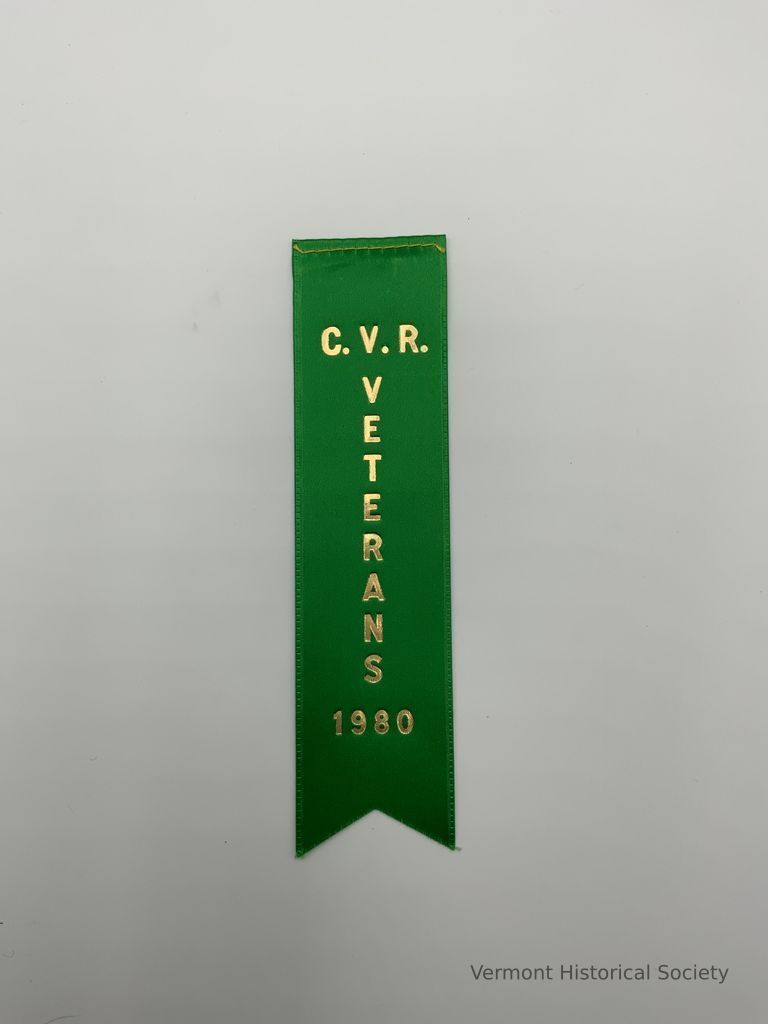
Membership Ribbon
Name/Title
Membership Ribbon
Lexicon
Description
Green satin-woven ribbon with the stamped inscription, "C. V. R. VETERANS 1980". The bottom is cut into two points, and there is a safety pin attached to the top back.
Acquisition
Accession
2021.5
Relationships
Related Person or Organization
LeCompte, Conrad Armand (1907-2003), Central Vermont Railway
Woven Textile Details
Weave Type
Satin Weave
Made/Created
Date made
1980
Entry/Object ID
2021.5.9
Context
Central Vermont Railroad ribbon given to Conrad LeCompte


Model Train
Name/Title
Model Train
Lexicon
Description
Miniature train engine and tender (coal car). The model is made from painted wood and sits on a base of railroad tracks. The engine and tender are black with black and silver wheels. A red stripe runs the length of the engine and tender. On the engine, the stripe has the blue label, "AMERICAN FREEDOM TRAIN" on each side. On the tender, the stripe has 13 5-pointed stars on each side. The model is inside a glass case with a wooden frame. A small photograph of original train is at the center top of the front pane, attached with a pin hinge. A paper tag is inserted into the frame of the case indicating that the model won first premium at a fair.
Acquisition
Accession
2022.72
Relationships
Related Events
US Bicentennial Celebration, Champlain Valley Fair
Made/Created
Artist Information
Brice, Frederick Joseph, Sr. (1917-1988)
Artist
Date made
1977
Materials
Material
Wood, Paint, Glass
Entry/Object ID
2022.72.1
Context
Shows Bicentennial "American Freedom Train". Made by Frederick A. Brice Sr. of Burlington, Vermont
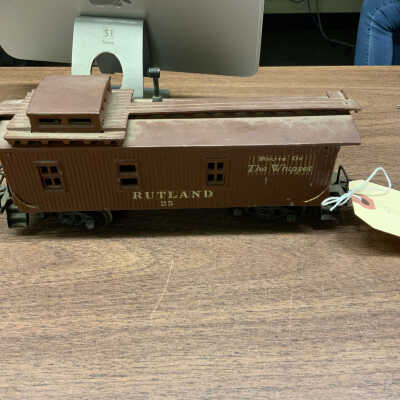
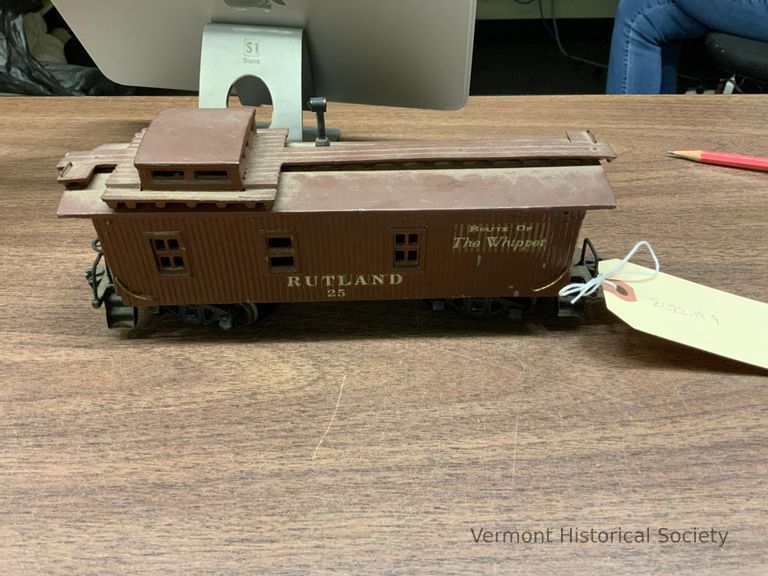
Model Train
Name/Title
Model Train
Lexicon
Description
Route of The Whippet. Rutland 25
Acquisition
Accession
2022.10
Entry/Object ID
2022.10.8
Context
Rutland railroad model train car
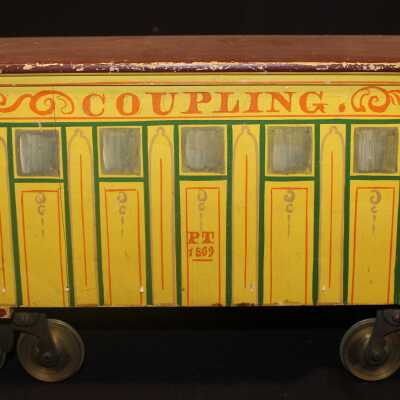
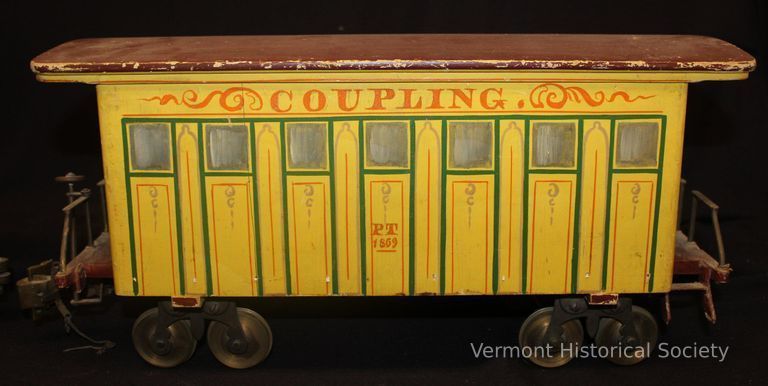
Model Train Car
Name/Title
Model Train Car
Lexicon
Description
Railroad car, painted mustard yellow with maroon roof. Lettering in orange "COUPLING" on the side with "PT / 1869" painted in the lower center of each side. Flourishes are at each end of the word COUPLING. Vertical dividers on the sides with 7 sections and a small 1x1 gray "window" at the top and orange pinstriping and green and gray lines too. Ends have painted doors. 8 brass wheels on the bottom with one pair attached to the hardware on the end that attaches the cars.
Acquisition
Accession
2014.23
Relationships
Related Person or Organization
Braley, Andrew Jackson (1828-1878)
Person or Organization
Made/Created
Manufacturer
Braley, Andrew Jackson (1828-1878)
Dimensions
Materials
Material
Brass, Wood
Entry/Object ID
2014.23.1.2

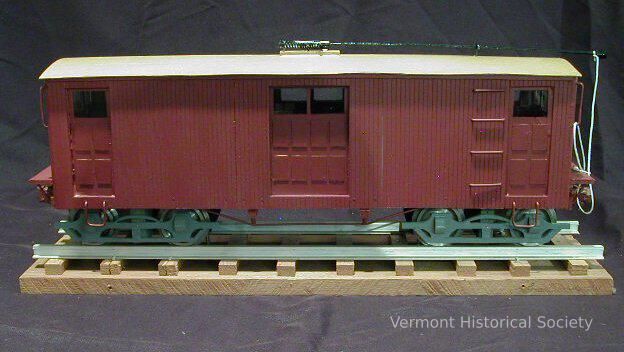
Model Train Car
Name/Title
Model Train Car
Lexicon
Description
1/2" scale model of Mansfield First Freight Motor 1898 on the Mount Mansfield Electric Railroad during the years 1898 - 1933.
Acquisition
Accession
1993.7
Made/Created
Date made
1990-1995
Dimensions
Materials
Material
Wood, Metal
Entry/Object ID
1993.7.1
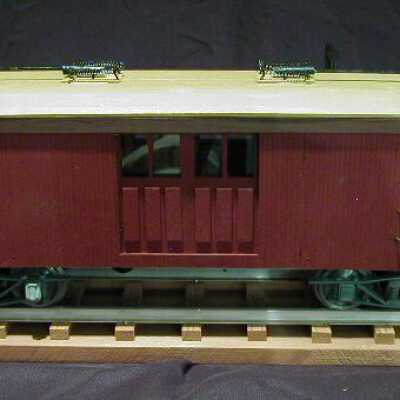
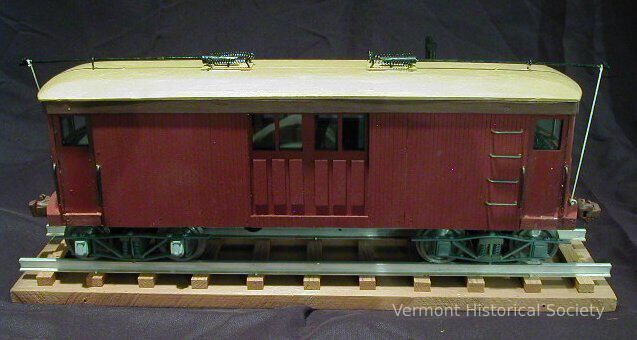
Model Train Car
Name/Title
Model Train Car
Lexicon
Description
"Mansfield's Second Freight Motor-1915" on the Mount Mansfield Electric Railroad during the years 1898 - 1933. This is built to 1/2" scale.
Acquisition
Accession
1993.7
Made/Created
Date made
1990-1995
Dimensions
Materials
Material
Wood, Metal
Entry/Object ID
1993.7.2

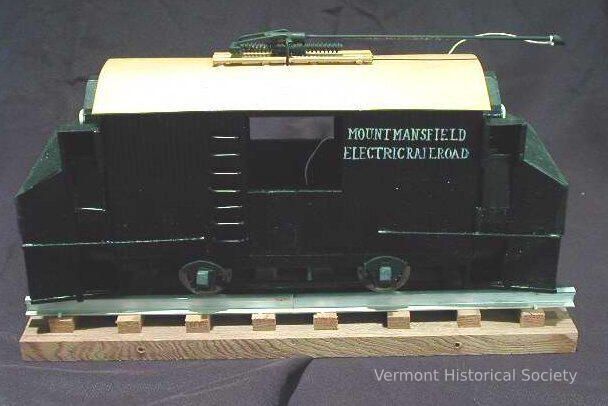
Model Train Car
Name/Title
Model Train Car
Lexicon
Description
"Mansfield's Rotary Plow-A Failure-1898" on the Mount Mansfield Electric Railroad during the years 1898 - 1933. This is built to 1/2" scale.
Acquisition
Accession
1993.7
Made/Created
Date made
1990-1995
Dimensions
Materials
Material
Wood, Metal
Entry/Object ID
1993.7.4

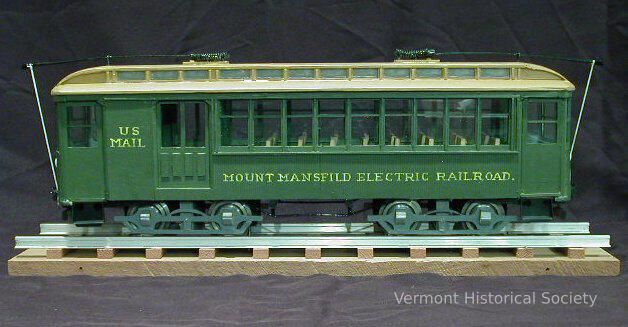
Model Train Car
Name/Title
Model Train Car
Lexicon
Description
"Waterbury-Stowe Interurban 1898-1932" on the Mount Mansfield Electric Railroad during the years 1898 - 1933. This is built to 1/2" scale.
Acquisition
Accession
1993.7
Made/Created
Date made
1990-1995
Dimensions
Materials
Material
Wood, Metal, String
Entry/Object ID
1993.7.5

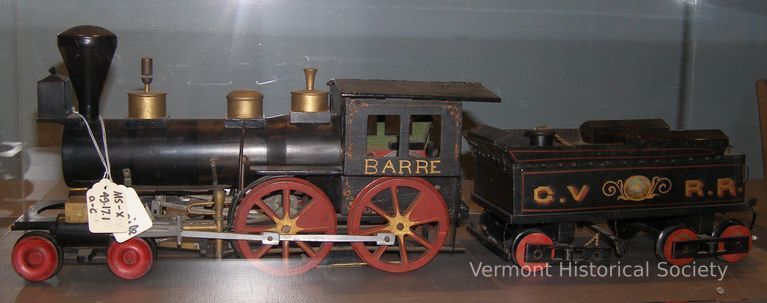
Model Train Engine
Name/Title
Model Train Engine
Lexicon
Description
Model train engine, coal car (tender), and track. The engine and tender are black with red wheels and gold-painted accents. The word "BARRE" is on the engine, and "C. V R. R." is on the tender. In the engine, the door to the firebox opens, and there is a lever underneath to let out ashes. The tender has working brakes, and the sand box rod is moveable. The front of the engine has a removable cow catcher. The track is made of wood.
Acquisition
Accession
1949.17
Relationships
Related Person or Organization
Central Vermont Railway
Person or Organization
Related Places
Place
Montpelier
City
Washington County
County
Vermont
State/Province
United States of America
Country
North America
Made/Created
Artist Information
Watson, William Arthur (1865-1950)
Artist
Date made
1879
Dimensions
Materials
Material
Wood
Entry/Object ID
1949.17.1a-c
Context
Model of the first engine to run between Barre and Montpelier Junction made by William Arthur Watson at age 14 (1879). The model was made from boxes and the tops of flour barrels, with a piece of railroad track used as an anvil during the construction process.

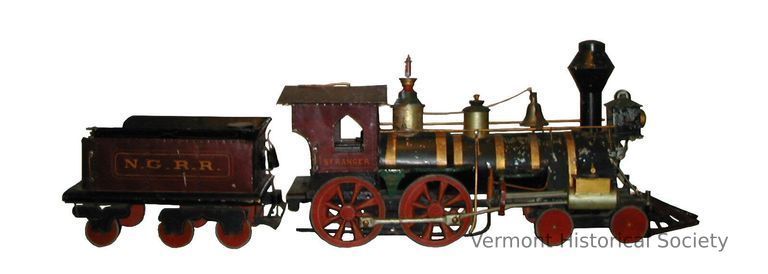
Model Train Engine
Interpretative Labels
Label
Train Model, 1877
Alfred Edward Butterfly (1848-1891)
Montpelier, Vermont
Painted metal
Gift of Alfred Emmanuel Butterfly, #1945.27
The locomotive "Stranger" started operations on the Vermont Central Railroad in 1852 and may have served the stone industry, transporting unfinished stone to the finishing sheds in Barre and Montpelier. Alfred Butterfly, the son of Canadian immigrants, worked as a polisher in the stone sheds of Montpelier. He died at the age of 43 in 1891 of silicosis, a disease of the lungs caused by granite dust.
Name/Title
Model Train Engine
Lexicon
Description
Model train consisting of an engine car and fuel car. The engine has a chimney, a large bell, and whistle along the top. The front has a pilot grate and a lantern. The wheels are painted red and there is a small red cab at the back printed on the sides with "STRANGER". A small car is attached to the back of the engine with three sides. (The back is left open.) The sides are printed with "N.G.R.R."
Acquisition
Accession
1945.27
Made/Created
Artist Information
Butterfly, Alfred E. (1848-1891)
Artist
Date made
1877-1877
Dimensions
Entry/Object ID
1945.27ab
Context
The model is of the locomotive, "Stranger", which operated for the Vermont Central Railroad starting in 1852. This model was made by Alfred E. Butterfly in 1877.

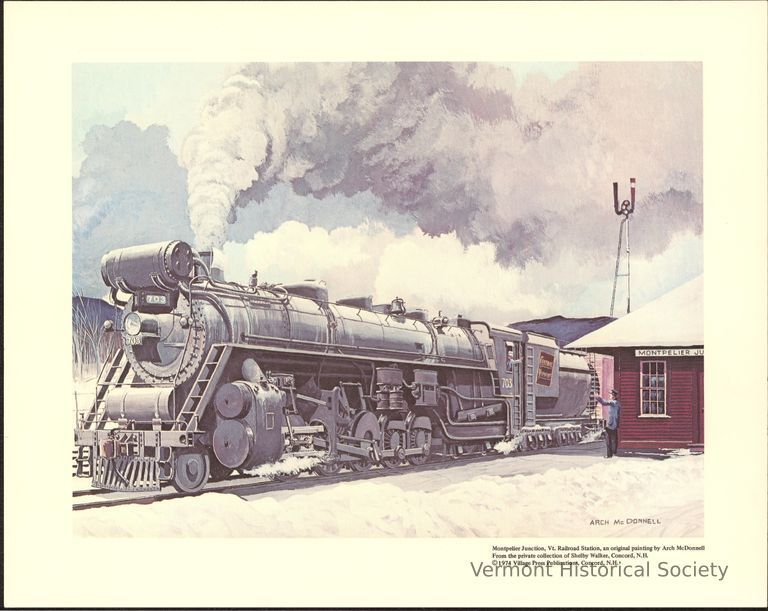
Montpelier Junction, Vt. Railroad Station
Name/Title
Montpelier Junction, Vt. Railroad Station
Lexicon
Description
Full-color print of a painting showing a train next to a building. The visible portion of the train consists of a long, grey engine, a grey coal car, and a red box car. There is a short chimney at the front of the engine emanating white smoke. The engine is labeled 703 beneath an opening through which the conductor is waving. The coal car is labeled "CENTRAL VERMONT" within a rectangle. The building has wood siding and is painted red. There is a sign hanging from the roofline that reads, "MONTPELIER JU[nction]". There is a tall structure in the background consisting of a tall pole, a ladder connected to the top of the pole and reaching down until it is out of sight, a curved piece at the center top with circles in red, yellow, and blue, and two upwardly pointed arms, one black and one red with a white stripe. There is a mountain in the background forming the horizon. The artwork is signed, "ARCH McDONNELL", and the print is marked, "Montpelier Junction, Vt. Railroad Station, an original painting by Arch McDonnell / From the private collection of Shelby Walker, Concord, N.H. / (c) 1974 Village Press Publications, Concord, N.H."
Acquisition
Accession
1990.25
Relationships
Related Person or Organization
Central Vermont Railway
Person or Organization
Artwork Details
Made/Created
Artist Information
McDonnell, Arch (1909-1978)
Artist
Date made
1974
Manufacturer
Village Press Publications
Dimensions
Dimension Description
Overall
Entry/Object ID
1990.25.2
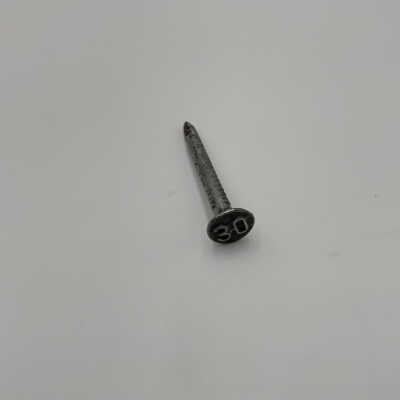
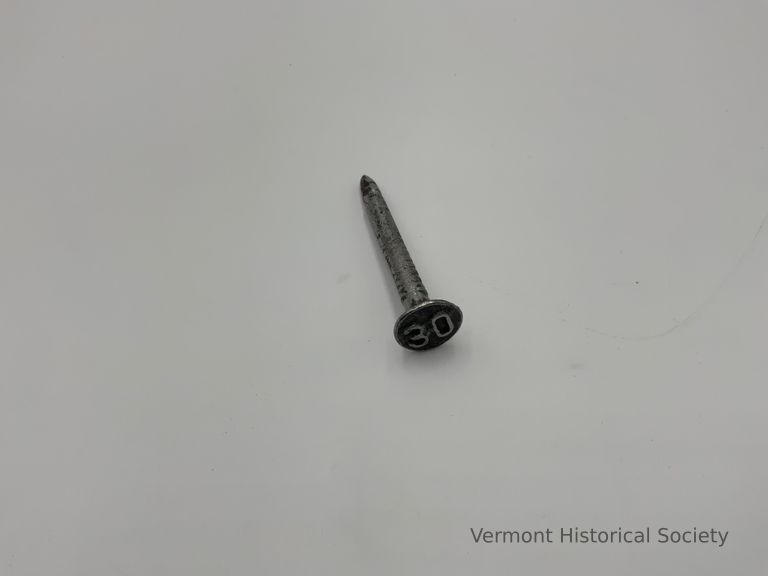
Nail
Name/Title
Nail
Lexicon
Description
Large nail with the number 30 molded into the head.
Use
Used to record the date of repairs of railroad tracks.
Acquisition
Accession
2021.5
Made/Created
Date made
1930
Materials
Material
Metal
Entry/Object ID
2021.5.18

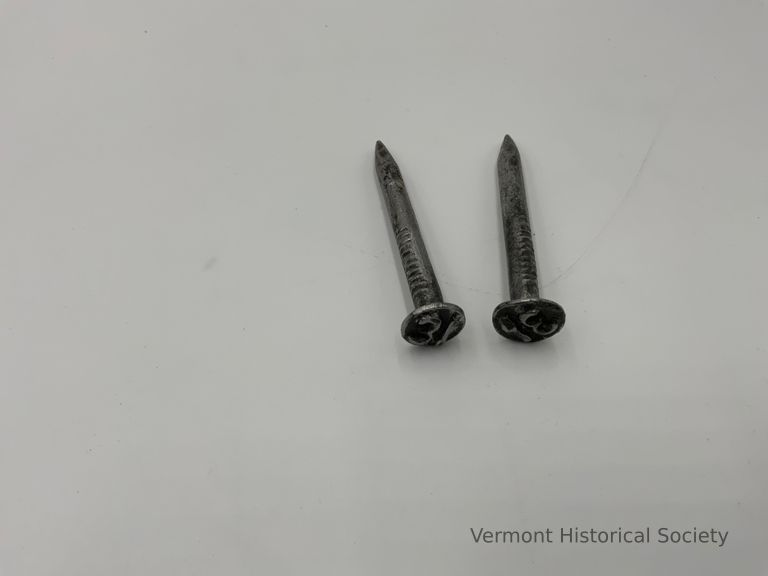
Nail
Name/Title
Nail
Lexicon
Description
Large nail with the number 31 molded into its head.
Use
Used to record the date of repairs of railroad tracks.
Acquisition
Accession
2021.5
Made/Created
Date made
1931
Materials
Material
Metal
Entry/Object ID
2021.5.19
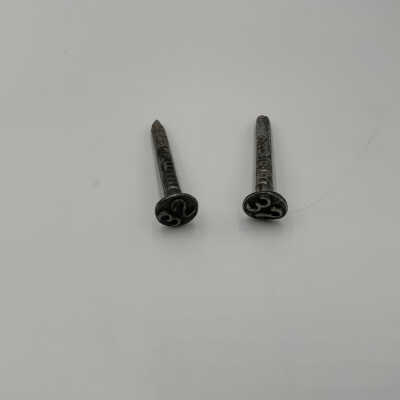

Nail
Name/Title
Nail
Lexicon
Description
Large nail with the number 32 molded into its head.
Use
Used to record the date of repairs of railroad tracks.
Acquisition
Accession
2021.5
Made/Created
Date made
1932
Materials
Material
Metal
Entry/Object ID
2021.5.21

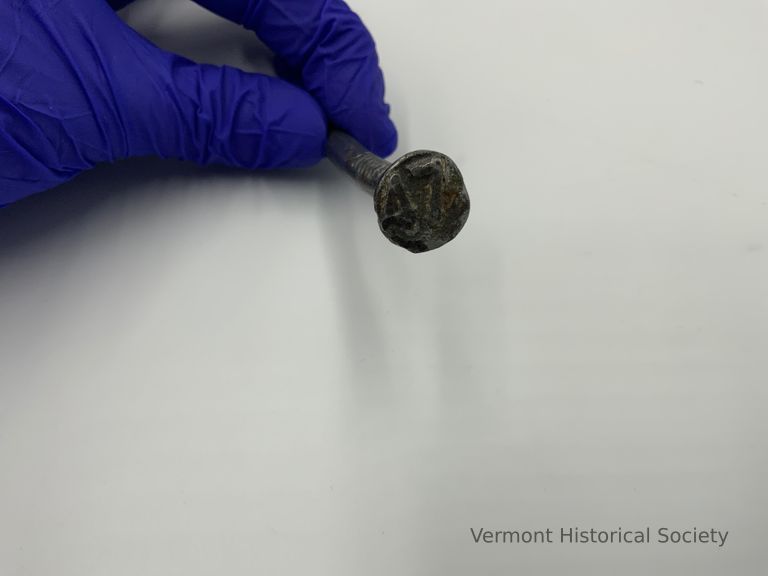
Nail
Name/Title
Nail
Lexicon
Description
Large nail with the number 47 molded into the head.
Use
Used to record the date of repairs of railroad tracks.
Acquisition
Accession
2021.5
Made/Created
Date made
1947
Materials
Material
Metal
Entry/Object ID
2021.5.23
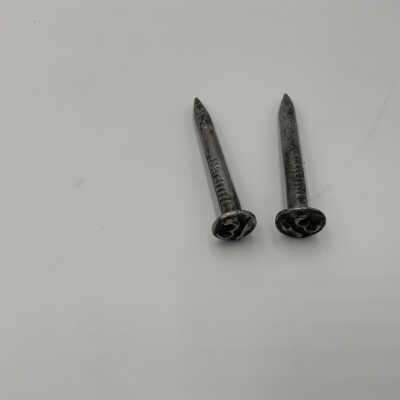

Nail
Name/Title
Nail
Lexicon
Description
Large nail with the number 31 molded into its head.
Use
Used to record the date of repairs of railroad tracks.
Acquisition
Accession
2021.5
Made/Created
Date made
1931
Materials
Material
Metal
Entry/Object ID
2021.5.20
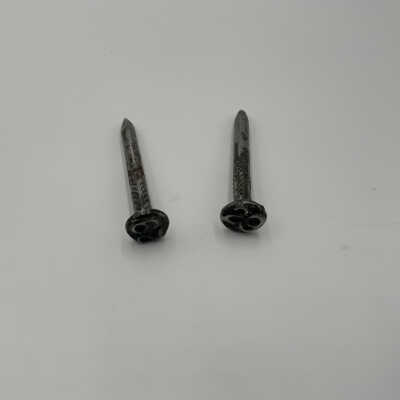
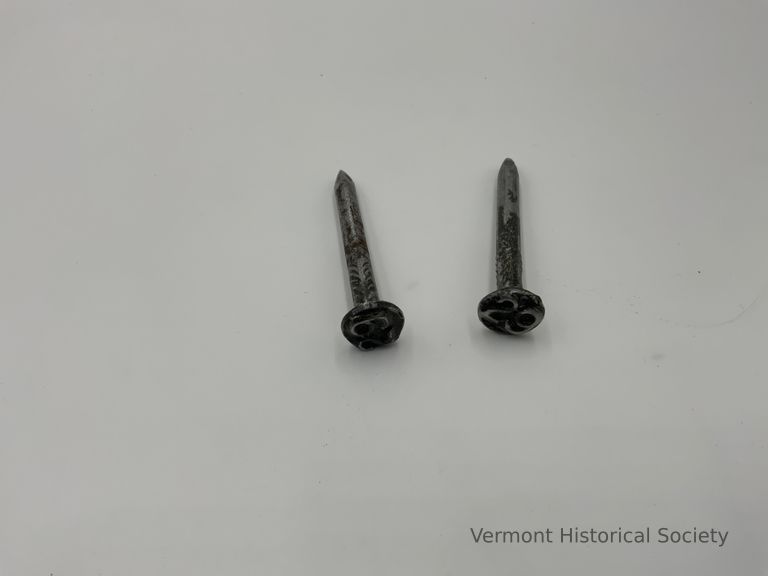
Nail
Name/Title
Nail
Lexicon
Description
Large nail with the number 29 molded into the head.
Use
Used to record the date of repairs of railroad tracks.
Acquisition
Accession
2021.5
Made/Created
Date made
1929
Materials
Material
Metal
Entry/Object ID
2021.5.17


Nail
Name/Title
Nail
Lexicon
Description
Large nail with the number 22 molded into the head.
Use
Used to record the date of repairs of railroad tracks.
Acquisition
Accession
2021.5
Made/Created
Date made
1922
Materials
Material
Metal
Entry/Object ID
2021.5.15


Nail
Name/Title
Nail
Lexicon
Description
Large nail with the number 32 molded into its head.
Use
Used to record the date of repairs of railroad tracks.
Acquisition
Accession
2021.5
Made/Created
Date made
1932
Materials
Material
Metal
Entry/Object ID
2021.5.22
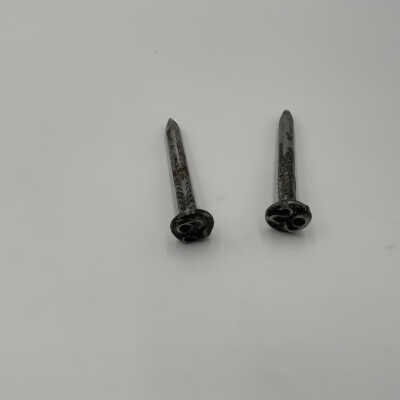

Nail
Name/Title
Nail
Lexicon
Description
Large nail with the number 29 molded into the head.
Use
Used to record the date of repairs of railroad tracks.
Acquisition
Accession
2021.5
Made/Created
Date made
1929
Materials
Material
Metal
Entry/Object ID
2021.5.16
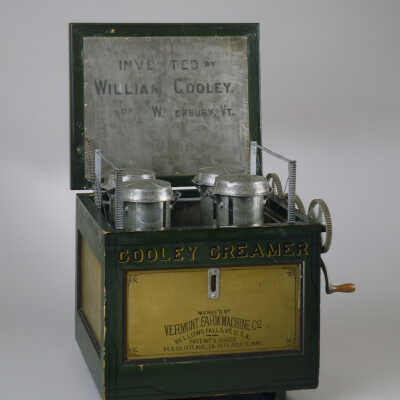
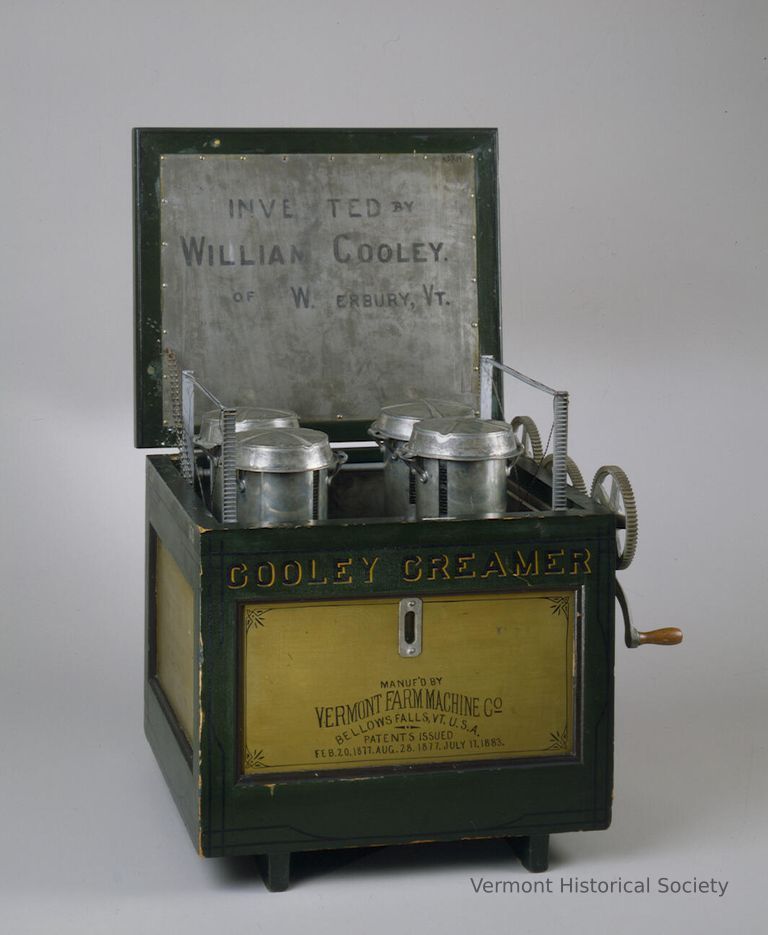
Product Model
Interpretative Labels
Label
Sales Sample, 1883
William Cooley
Vermont Farm Machinery Company
Wood, metal
Anonymous gift, 1957.19
Dairy has long been one of Vermont’s primary industries, and when refrigerated railroad cars provided easier, faster access to major markets in Montreal, New York, and Boston, production grew exponentially. Rather than cheese and other preserved products as the primary export, it became feasible for Vermonters to sell cream and milk out of the state.
William Cooley of Waterbury invented a number of things, including a variety of gasoline engines, granite industry tools, and other machine parts. This creamer was one of his earlier efforts, patented in the 1870s. The creamer was found to be more efficient at extracting cream from milk than other similar machines, and the Vermont Farm Machine Company purchased the patent from Cooley to manufacture and distribute his machine.
Within a few years, 8,000 dairies were using the creamer. Its more efficient process made the development of centralized creameries possible, streamlining production rather than the individual on-farm process that had dominated before. The design proved popular enough that the company spent time in court protecting its patent against infringement on a number of different occasions.
This creamer is a salesman’s model, intended to show the mechanics of the machine but not necessarily to actually produce cream. The smallest production model of Cooley’s Creamer was at least twice as large as this one.
Name/Title
Product Model
Lexicon
Description
Sales sample for a Cooley Creamer, manufactured by the Vermont Farm Machinery Company.
Wooden box painted green, gold, and black with a tin lined interior. On the outside of the box are elaborate painted decorations as well as the lettering “COOLEY CREAMER” at the top front in black letters shadowed with gold. On the front gold panels are the words “MANUF’D BY / VERMONT FARM MACHINE CO / BELLOWS FALLS, VT, U.S.A. / PATENTS ISSUED / FEB 10 1877, AUG 28 1877, JULY 17, 1883” There is also a metal slot on the top of the front panel above the words. The whole box is held off the ground by two pieces of wood on the bottom. On the right hand side is a crank connected to three gears as well as two additional levers.
On the underside of the lid, the words “INVENTED BY / WILLIAM COOLEY / OF WATERBURY, VT.” are painted in black. The lid is held open by two chains connecting diagonally to the box. Inside the box, four metal cylinders rest on a platform that raises or lowers with a system of gears. The cans have spigots and gauges and removable lids.
Wooden box painted green, gold, and black with a tin lined interior. On the outside of the box are elaborate painted decorations as well as the lettering “COOLEY CREAMER” at the top front in black letters shadowed with gold. On the front gold panels are the words “MANUF’D BY / VERMONT FARM MACHINE CO / BELLOWS FALLS, VT, U.S.A. / PATENTS ISSUED / FEB 10 1877, AUG 28 1877, JULY 17, 1883” There is also a metal slot on the top of the front panel above the words. The whole box is held off the ground by two pieces of wood on the bottom. On the right hand side is a crank connected to three gears as well as two additional levers.
On the underside of the lid, the words “INVENTED BY / WILLIAM COOLEY / OF WATERBURY, VT.” are painted in black. The lid is held open by two chains connecting diagonally to the box. Inside the box, four metal cylinders rest on a platform that raises or lowers with a system of gears. The cans have spigots and gauges and removable lids.
Acquisition
Accession
1957.19
Relationships
Related Places
Place
Waterbury
Town
Washington County
County
Vermont
State/Province
United States of America
Country
North America
Made/Created
Artist Information
Cooley, William
Artist
Date made
1883
Manufacturer
Vermont Farm Machinery Company (1871-1921)
Dimensions
Dimension Description
Overall
Materials
Material
Wood, Metal
Entry/Object ID
1957.19
Context
William Cooley of Waterbury patented this creamer in the 1870s as the dairy industry began booming, and it was sold and distributed nationally by the Vermont Farm Manufacturing Company of Bellows Falls.
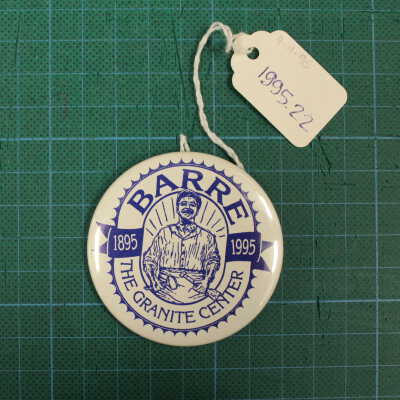
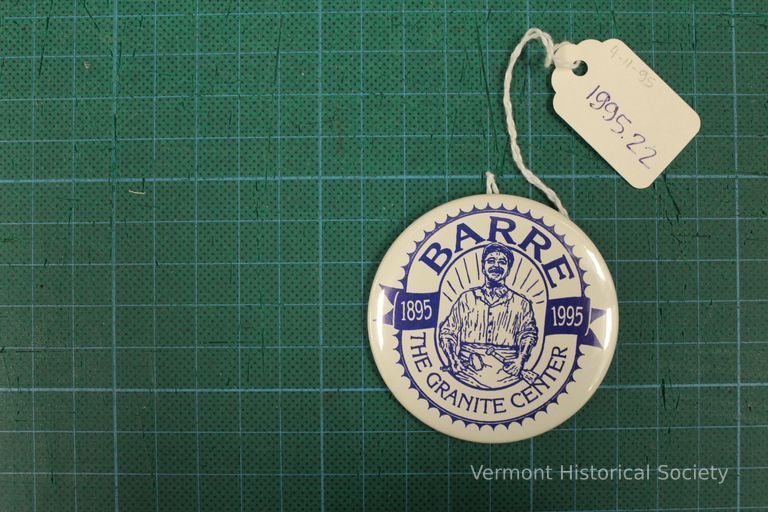
Promotional Button
Name/Title
Promotional Button
Lexicon
Description
Barre/ The Granite Center 1895-1995 pin. White pin with blue graphics of a male granite cutter with tools in hand central. Around him is an oval of text "1895 BARRE 1995 THE GRANITE CENTER" With a safety clasp pin back.
Acquisition
Accession
1995.22
Relationships
Related Places
Place
Barre City
City
Washington County
County
Vermont
State/Province
United States of America
Country
North America
Made/Created
Date made
1995
Dimensions
Materials
Material
Plastic, Metal
Entry/Object ID
1995.22
Context
Here is some history to explain the tag "The Granite Center" associated with Barre, Vermont, provided by the Barre Granite Association. (http://barregranite.org/BGAmobile/index.php/pid/5)
" Barre Gray Granite was used extensively in the early 1800’s for millstones, paving stones and home and building construction. It was at that time that Robert Parker became Barre’s first professional quarryman and the first granite manufacturer. Slowly, but steadily the granite industry grew, causing Barre’s population to expand to 2,012 by the year 1830. A few years later the industry would get a tremendous boost with the contract for a new Vermont Statehouse to be built of Barre Gray granite in Montpelier, VT. It was the first major building project to use Barre granite. Then, in 1875, the railroad came to town, giving Barre access to the markets of the world.
In the 1880’s, Barre experienced a technological boom. Emery L. Smith, who later became the first mayor of Barre City, pioneered new quarrying technology, including a permanent derrick, electrically detonated explosives, the steam drill and the pneumatic plug drill. Electricity came to the region in 1885, giving rise to power cutting, polishing, surfacing, carving and stone transferring with overhead cranes.
With rapid growth in the granite industry, immigrants began flooding into Barre, and by 1890 the population had more than to 6,790. The first workers to arrive were Scots, followed by Italians, Scandinavians, Spanish, English, Irish, Greeks, and French-Canadians. When an order for 10 million hand-cut paving stones for the city of Troy, New York, was received, this gave Barre’s granite industry a big boost in the 1890’s. At that time about 40 quarries were cutting granite, primarily for monuments and memorials, and by 1902 Barre became the Granite Center of the World, with 68 quarries producing granite valued at more than $1.5 million."
" Barre Gray Granite was used extensively in the early 1800’s for millstones, paving stones and home and building construction. It was at that time that Robert Parker became Barre’s first professional quarryman and the first granite manufacturer. Slowly, but steadily the granite industry grew, causing Barre’s population to expand to 2,012 by the year 1830. A few years later the industry would get a tremendous boost with the contract for a new Vermont Statehouse to be built of Barre Gray granite in Montpelier, VT. It was the first major building project to use Barre granite. Then, in 1875, the railroad came to town, giving Barre access to the markets of the world.
In the 1880’s, Barre experienced a technological boom. Emery L. Smith, who later became the first mayor of Barre City, pioneered new quarrying technology, including a permanent derrick, electrically detonated explosives, the steam drill and the pneumatic plug drill. Electricity came to the region in 1885, giving rise to power cutting, polishing, surfacing, carving and stone transferring with overhead cranes.
With rapid growth in the granite industry, immigrants began flooding into Barre, and by 1890 the population had more than to 6,790. The first workers to arrive were Scots, followed by Italians, Scandinavians, Spanish, English, Irish, Greeks, and French-Canadians. When an order for 10 million hand-cut paving stones for the city of Troy, New York, was received, this gave Barre’s granite industry a big boost in the 1890’s. At that time about 40 quarries were cutting granite, primarily for monuments and memorials, and by 1902 Barre became the Granite Center of the World, with 68 quarries producing granite valued at more than $1.5 million."
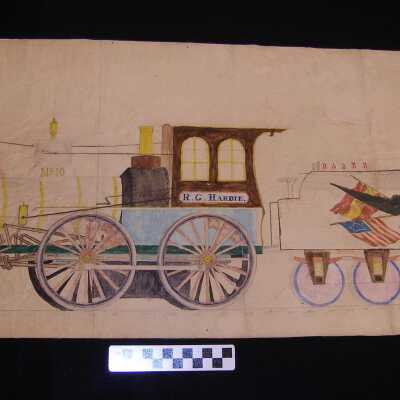

R. & B. R. R.
Name/Title
R. & B. R. R.
Lexicon
Description
Partially painted drawing of a train engine and tender (coal car). The engine has a large chimney at the front (black), and a cab at the back (brown over light blue). The small front wheels are red with blue edges, and the large back wheels are pink and blue. The tender is painted with an image of a flying eagle holding a scroll over four crossed flags: Spanish, French, German, and United States. The lantern at the front of the engine reads, "Drawn by Robert Hardie, Rutland Vermont, Feb 9th 1866 11 years of age."
Acquisition
Accession
1958.1
Relationships
Related Person or Organization
Rutland and Burlington Railroad
Person or Organization
Artwork Details
Medium
Watercolor, Pencil
Subject
Rutland and Burlington Railroad Engine No. 10
Made/Created
Artist Information
Hardie, Robert Gordon (1854-1904)
Artist
Date made
1866
Dimensions
Dimension Description
Overall
Entry/Object ID
1958.1.1601
Type of Drawing
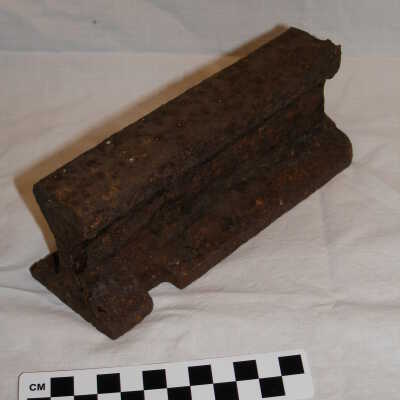
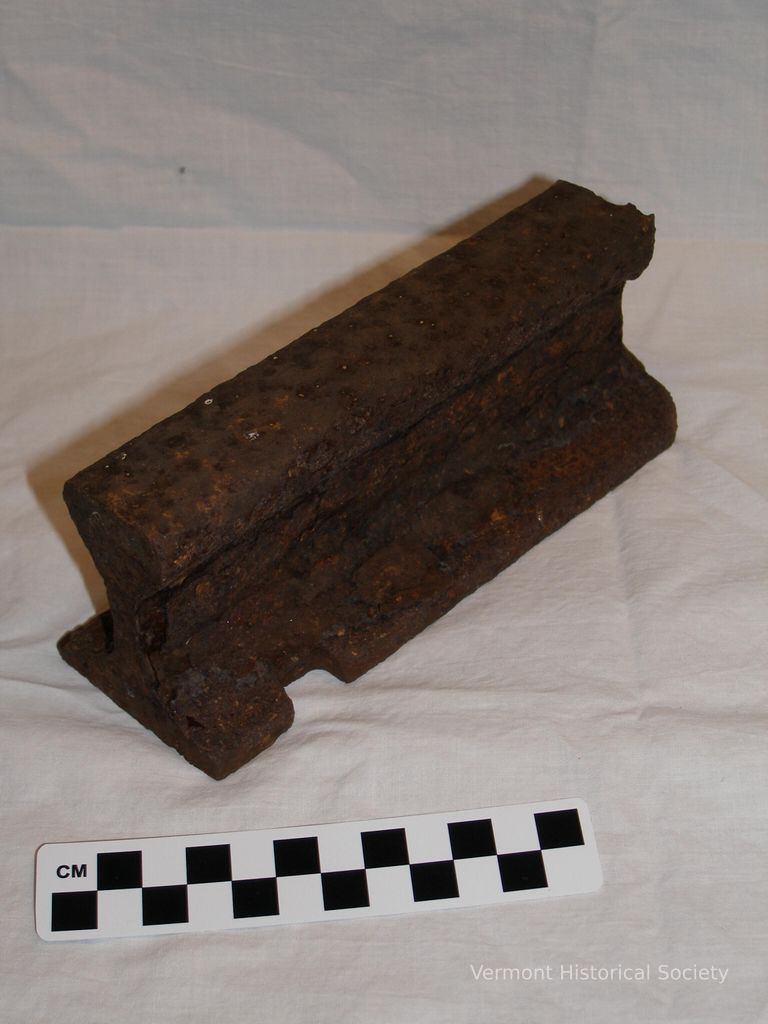
Rail
Name/Title
Rail
Lexicon
Description
Rusting cast iron railroad rail segment. The rail is cast in an "I" shape with a narrow center and flared top and bottom. The bottom flair is wider than the top. The broken end suggests that it may have been saved to use as a Dutchman, or splice.
Acquisition
Accession
1975.2
Relationships
Related Places
Place
Wells River
Village
Newbury
Town
Orange County
County
Vermont
State/Province
United States of America
Country
North America
Made/Created
Date made
1840-1850
Dimensions
Dimension Description
Overall
Materials
Material
Iron
Entry/Object ID
1975.2
Context
Found along the abandoned road bed of the Montpelier and Wells River Railroad near Wells River, Vermont. The rail segment is one of the earliest types of rail used in Vermont in the 1840s and 1850s.
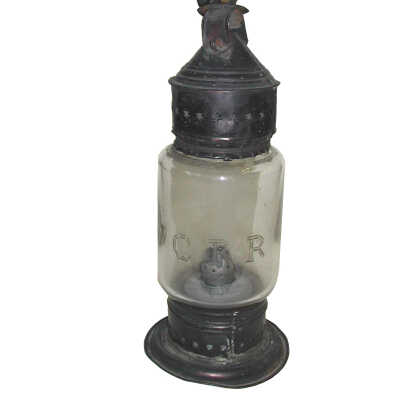
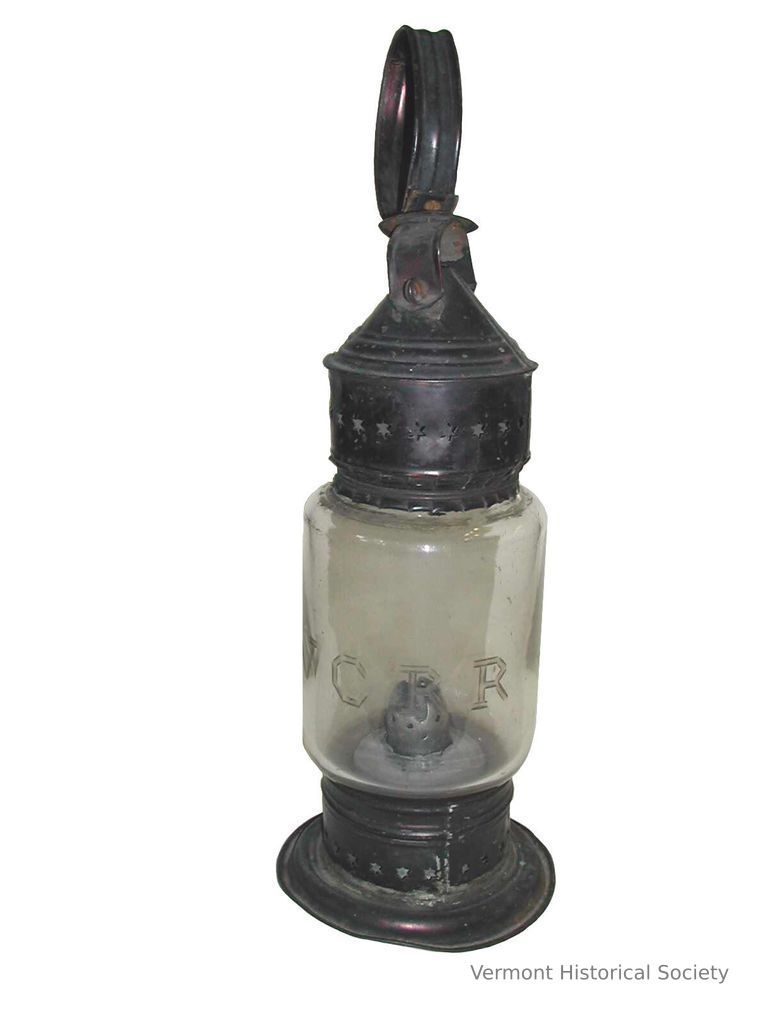
Railroad Lantern
Name/Title
Railroad Lantern
Lexicon
Description
Railroad lantern with metal base and ventilation cap and glass chimney. Both the cap and base are stamped with six-pointed stars. The glass is engraved with the initials, "V C R R" (Vermont Central Rail Road). The base contains a well for holding liquid fuel, and a central wick holder rises from the base into the center of the chimney. The lantern has a round metal handle at the top.
Acquisition
Accession
1960.190
Relationships
Related Person or Organization
Central Vermont Railway
Person or Organization
Made/Created
Time Period
19th Century
Dimensions
Dimension Description
Overall
Materials
Material
Tin, Glass
Entry/Object ID
1960.190
Context
Used on the Central Vermont Railway

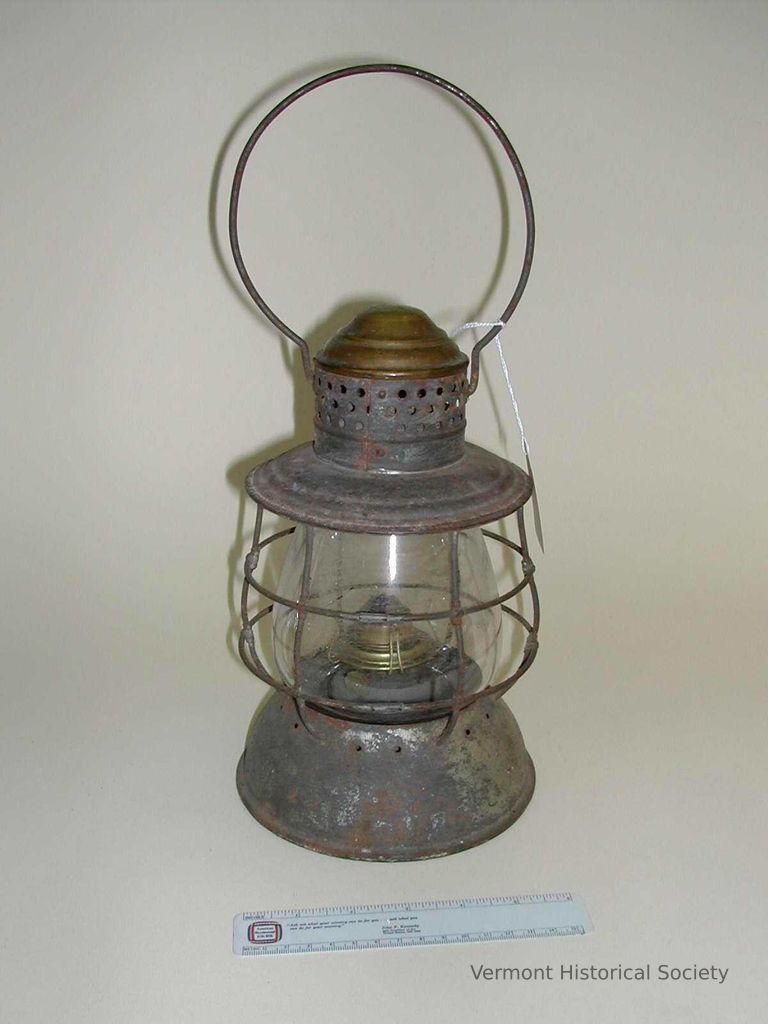
Railroad Lantern
Name/Title
Railroad Lantern
Lexicon
Description
Lantern with glass globe/chimney set into a metal cage mount. The oil reservoir sits in the base of the lantern, and the round wire handle is attached to the vent cap.
Acquisition
Accession
1988.14
Relationships
Related Places
,
Made/Created
Time Period
19th Century
Dimensions
Dimension Description
Overall
Materials
Material
Metal, Glass
Entry/Object ID
1988.14.1
Context
Used on the first train from White River Junction, Vermont, through Sharon, Vermont.
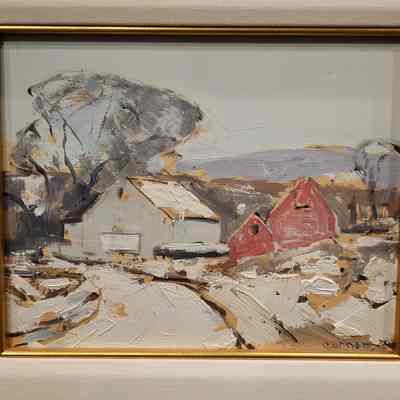

Road to Sunderland
Name/Title
Road to Sunderland
Lexicon
Description
Small oil painting of a winter farm scene. A road in the foreground leads to a grey barn with other red outbuildings. A large tree appears behind the barn and mountains can be seen in the background. The painting is mostly in shades of greys and browns except for the two red buildings. A label affixed to the back entitles the painting, "Road to Sunderland."
Acquisition
Accession
2017.12
Artwork Details
Made/Created
Artist Information
Connaway, Jay Hall (1893-1970)
Artist
Date made
1955-1969
Entry/Object ID
2017.12.2
Context
Jay Connaway was born in Liberty, Indiana, November 27, 1893, the son of Cass Connaway, a lawyer and collector of Chinese art, and his wife May. Jay Connaway graduated from Emmerich Manual High School and undertook his first art training from William Forsyth, known for coastal Oregon views, at John Herron School of Art in Indianapolis in 1910 and 1911. Connaway left home to tour the California and Oregon coasts, working his way across the country and then back to the East Coast as a stoker on engines for the Atchison, Topeka, and Santa Fe Railroad.
In New York, Connaway enrolled at the National Academy of Design school in 1912. From 1912 to 1914 he attended the Art Student's League at New York City, where he studied with George Bridgman and with William Merritt Chase. Another influence was Robert Henri, a New York Social Realist and leader of the Ashcan School, whom Connaway had met while attending night classes at the National Academy.
In 1917 he enlisted and shipped out to Contrexeville, France. After suffering a shoulder wound, he worked as a cartographer. Then he was assigned to what he called "the most wonderful work of my life"—making detailed watercolor drawings of lesions caused by mustard gas. This brought him to the attention of Lafayette Page, a physician who was so impressed with Connaway's draftsmanship that, at the close of the war, he sponsored his studies at the Académie Julian (1919–20) under Jean Paul Laurens and at the École des Beaux-Arts (1921) in Paris.
With backing from collectors and gallery owners, Connaway, "seeking to paint the lonely sea" found his way to uninhabited Head Harbor Island off the coast of Jonesport, Maine where he lived as an artistic hermit. He later worked dories with a Grand Banks fishing fleet, was also a cook for a lumber camp in Maine, and he enlisted in the Coast Guard.
In 1928 Connaway married Louise Boehle. During the depression, Connaway moved to Monhegan Island to paint and start the Connaway Art School.
The Connaways remained on Monhegan until 1947, when they moved to Vermont, residing in Dorset until 1953, then North Rupert. Connaway painted rural landscapes of the Vermont countryside and operated a summer art school, until 1966.
In 1962, Connaway merged his school with the Southern Vermont Arts Center and became the school's first director. During the 1960s, in addition to managing the art school Connaway painted in Portugal, Spain, California, and Arizona. In the last year of his life, troubled with poor eyesight and failing health, Connaway was no longer able to paint.
In New York, Connaway enrolled at the National Academy of Design school in 1912. From 1912 to 1914 he attended the Art Student's League at New York City, where he studied with George Bridgman and with William Merritt Chase. Another influence was Robert Henri, a New York Social Realist and leader of the Ashcan School, whom Connaway had met while attending night classes at the National Academy.
In 1917 he enlisted and shipped out to Contrexeville, France. After suffering a shoulder wound, he worked as a cartographer. Then he was assigned to what he called "the most wonderful work of my life"—making detailed watercolor drawings of lesions caused by mustard gas. This brought him to the attention of Lafayette Page, a physician who was so impressed with Connaway's draftsmanship that, at the close of the war, he sponsored his studies at the Académie Julian (1919–20) under Jean Paul Laurens and at the École des Beaux-Arts (1921) in Paris.
With backing from collectors and gallery owners, Connaway, "seeking to paint the lonely sea" found his way to uninhabited Head Harbor Island off the coast of Jonesport, Maine where he lived as an artistic hermit. He later worked dories with a Grand Banks fishing fleet, was also a cook for a lumber camp in Maine, and he enlisted in the Coast Guard.
In 1928 Connaway married Louise Boehle. During the depression, Connaway moved to Monhegan Island to paint and start the Connaway Art School.
The Connaways remained on Monhegan until 1947, when they moved to Vermont, residing in Dorset until 1953, then North Rupert. Connaway painted rural landscapes of the Vermont countryside and operated a summer art school, until 1966.
In 1962, Connaway merged his school with the Southern Vermont Arts Center and became the school's first director. During the 1960s, in addition to managing the art school Connaway painted in Portugal, Spain, California, and Arizona. In the last year of his life, troubled with poor eyesight and failing health, Connaway was no longer able to paint.

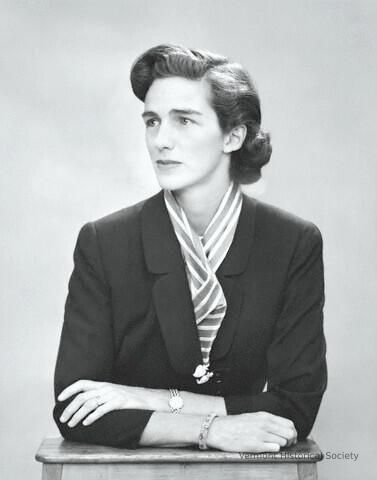
Rockefeller, Mary Billings French (1910-1997)
Name/Title
Rockefeller, Mary Billings French (1910-1997)
Description
Born: May 1, 1910 in New York, New York
Died: April 17, 1997 in Manhattan, New York
Primary Residence: Woodstock
Rockefeller donated her home and surrounding property in Woodstock, Vermont, for the state's first national park. She and her husband advised the Calvin Coolidge Memorial Foundation in Plymouth, Vermont, and were instrumental in funding a program to bury wires and telephone lines in the historic site.Through the YWCA, she was an advocate for women throughout the world.
Died: April 17, 1997 in Manhattan, New York
Primary Residence: Woodstock
Rockefeller donated her home and surrounding property in Woodstock, Vermont, for the state's first national park. She and her husband advised the Calvin Coolidge Memorial Foundation in Plymouth, Vermont, and were instrumental in funding a program to bury wires and telephone lines in the historic site.Through the YWCA, she was an advocate for women throughout the world.
Biographical Information
Education
BA, Vassar (1931)
Biography
Mary French Rockefeller is the granddaughter of Frederick Billings, a lawyer and president of the Northern Pacific Railroad (1879-1881) who was involved in the earliest efforts to create Yosemite and Yellowstone national parks. Mary grew up on the family estate in Woodstock, Vermont.
After attending Vassar College, in 1934, Mary French married Laurence Rockefeller, grandson of John D. Rockefeller, the founder of Standard Oil. Following in their grandfathers' footsteps, Mary French Rockefeller and her husband, Laurance Rockefeller, founded the Billings Farm & Museum at the Billings estate.
In 1992, Mr. and Mrs. Rockefeller donated her family home and surrounding property in Woodstock, Vermont, to the federal government for development as the state's first national park and protecting Mount Tom as well as preserving Woodstock's character.
Mary and Laurence Rockefeller's work lives on through the programs they have created. They worked on the Outdoor Recreation Resources Review Commission which contributed to the creation of the Bureau of Outdoor Recreation, the Land and Water Conservation Fund, the Wilderness Act and the National System of Scenic Rivers.
Mrs. Rockefeller was a dedicated supporter of the Young Women's Christian Association and traveled over the world to study the YWCA's activities. She was a trustee of Spelman College for 25 years, a trustee of the Whitney Museum of American Art, the Gordon-Conwell Theological Seminary, the Woodstock (Vermont) Historical Society, and the Calvin Coolidge Memorial Foundation of Plymouth, Vermont. In 1988, she wrote a new introduction to "Grace Coolidge and her Era: the Story of a President's Wife," by Isabel Ross. Mrs. Rockefeller wrote that the book "gives us new insight on those times, and it demonstrates how (Grace Coolidge's) grace, charm and good humor proved a steadying and supportive influence upon a heavily burdened President and upon all those around her."
Occupation
Philanthropist
Preservationist
Entry/Object ID
1.1.133
Web Links and URLs

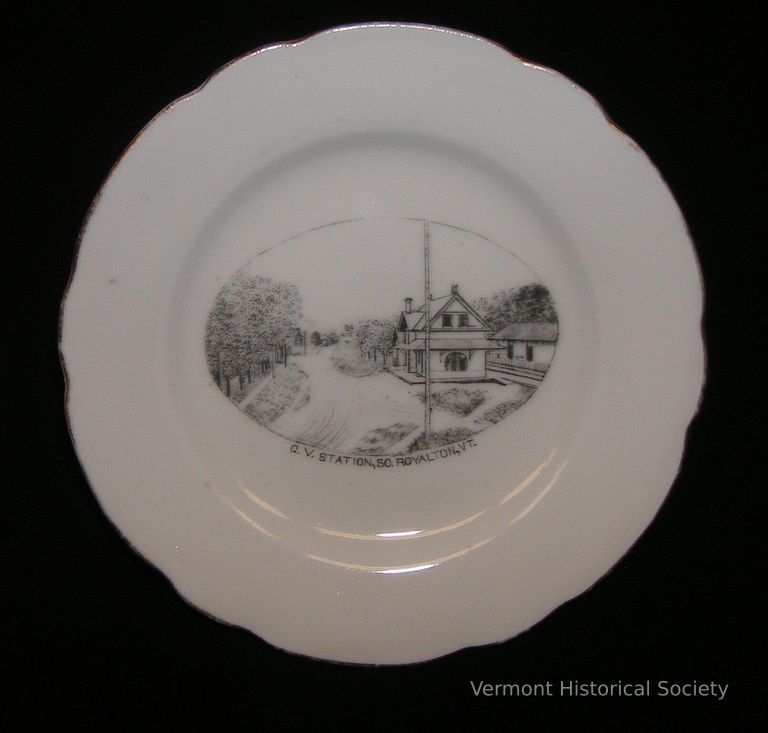
Saucer
Name/Title
Saucer
Lexicon
Description
White ceramic saucer printed in the center with an illustration of a small station alongside a railroad track with a dirt road and trees to the left. The image is labeled, "C. V. STATION, SO. ROYALTON, VT." The bottom is marked, "Made in Austria for E. F. MOODY, So. Royalton, Vt. Vienna".
Acquisition
Accession
2012.36
Relationships
Related Person or Organization
E. F. Moody
Person or Organization
Related Places
Place
South Royalton
Village
Royalton
Town
Windsor County
County
Vermont
State/Province
United States of America
Country
North America
Made/Created
Date made
1900-1920
Dimensions
Dimension Description
Overall
Materials
Material
Porcelain
Entry/Object ID
2012.36.14
Context
Sold by E. F. Moody in South Royalton, Vermont


Saucer
Name/Title
Saucer
Lexicon
Description
White ceramic saucer with full-color roses printed in around the rim. The center is printed with an illustration of several warehouse or factories along a railroad track. The image is labeled, "A Section of the E. L. Chandler Co. S Plant, Barton Landing, Vt." The back of the saucer is marked, "WHEELOCK VIENNA AUSTRIA Made in Austria for Whipple, French & Co., Barton Landing, Vt. Vienna."
Acquisition
Accession
2012.36
Relationships
Related Person or Organization
Whipple, French & Co., E. L. Chandler Company
Related Places
Place
Barton
Town
Orleans County
County
Vermont
State/Province
United States of America
Country
North America
Made/Created
Date made
1900-1920
Dimensions
Dimension Description
Overall
Materials
Material
Porcelain
Entry/Object ID
2012.36.30
Context
Sold by Whipple, French & Co. in Barton Landing, Vermont
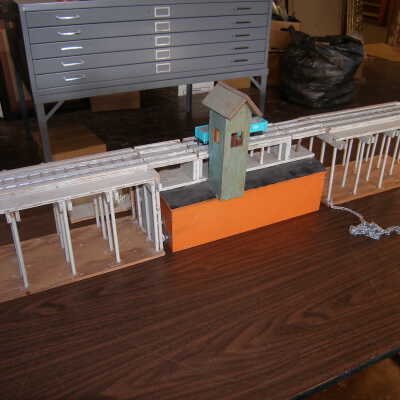
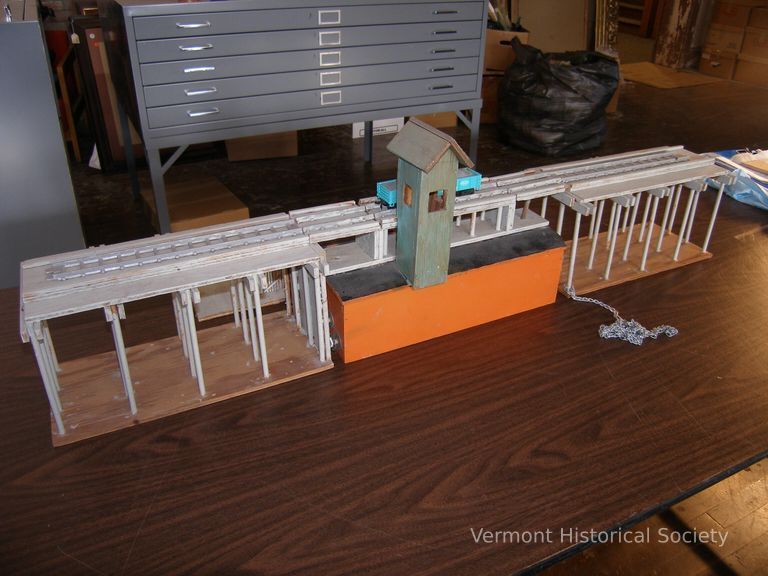
Scale Model
Name/Title
Scale Model
Lexicon
Description
Model of floating railroad bridge across Lake Champlain connecting Vermont and New York from Larrabee's Point to Ticonderoga. The bridge was composed of stationery piers from each shore joined by a floating barge hinged on one side. Powered by a steam engine. The barge would swing open for boats to pass through.
Acquisition
Accession
1970.11
Relationships
Related Places
Place
Lake Champlain
Lake
Burlington
City
Chittenden County
County
Vermont
State/Province
United States of America
Country
North America
Dimensions
Entry/Object ID
1970.11.1a-i
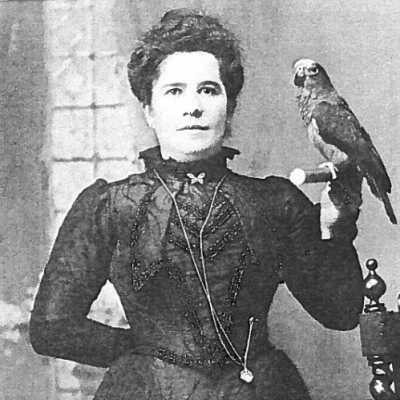

Shipley, Lillian Miner (1866-1941)
Name/Title
Shipley, Lillian Miner (1866-1941)
Also Known As
Queen Lill
Description
Born: July 10, 1866 in Richford, Vermont
Died: March 22, 1951 in St. Albans, Vermont
Primary Residence: Richford
Known locally as "Queen Lill," Shipley founded and ran a successful bar, hotel, and brothel on the Vermont/Canadian border. An entreprener in the prostitution and liquor business, she capitalized on illegal trade to amass considerable wealth.
Died: March 22, 1951 in St. Albans, Vermont
Primary Residence: Richford
Known locally as "Queen Lill," Shipley founded and ran a successful bar, hotel, and brothel on the Vermont/Canadian border. An entreprener in the prostitution and liquor business, she capitalized on illegal trade to amass considerable wealth.
Biographical Information
Biography
Lillian Minor Shipley operated a successful hotel, bar, and brothel on the Vermont/Canadian border in the early twentieth century. The daughter of William and Mary Minor, she was born in Stevens Mills, Richford in 1866. As a young woman, she left her family and married A. G. Shipley, a peddler of patent medicines and entertainer with a reputation for horse thieving and grave robbing. The couple traveled widely, staging a medicine show.
By the turn of the century, Lillian had become involved in prostitution and managed a brothel in Boston until 1910, when local authorities shut down much of the illegal business in the city. Returning to Vermont, she purchased and restored a three-story hotel straddling the Canadian border in Richford. From 1911 until the end of prohibition in 1933, she operated "Lill's Palace," a bar, hotel, and bordello which benefited from its stategic location on the Canadian-Pacific railroad line between Montreal and the cities of the Northeast. Known as "Queen Lil," she served clients from the local area as well as urban business travelers. To take advantage of the demand for illegal liquor, she piped supplies from Canada under the Missisquoi River and operated her own bottling plant, selling to New England bootleggers. Shipley was known for carrying a pistol and flaunting her hard-earned wealth in a fancy automobile. She largely evaded the law by bribing federal officials, but after an international raid in 1925 she was forced to plead guilty and was fined for violating the Mann Act against trafficking in prostitutes.
Shipley retired after the end of prohibition diminished her business. She bought several farms with her earnings, married farmer Levi Fleury, and lived with him and his two children until her death.
Occupation
Business Owner
Entry/Object ID
1.1.135
Web Links and URLs


Shirt
Name/Title
Shirt
Lexicon
Clothing/Dress/Costume Details
Article of Clothing/Dress/Costume
Shirt
Textile Details
Cotton
Polyester
Clothing Sex
Male
Size
16/35
Description
Red and white pinstriped shirt. The shirt has long sleeves and a pointed falling collar that buttons to the shirt at the points. The shirt opens down the center front and secures with 7 white plastic buttons. The hem is longer in the back than the front, and the cuffs are railroaded. A tag at the back neckline reads, "JCW J. W. Campion MONTPELIER, VT. enro".
Acquisition
Accession
1997.43
Relationships
Related Person or Organization
J. W. Campion, Rogstad, Syver P.
Related Places
Place
Montpelier
City
Washington County
County
Vermont
State/Province
United States of America
Country
North America
Made/Created
Date made
circa 1985
Manufacturer
Enro
Entry/Object ID
1997.43
Context
Sold by J. W. Campion of Montpelier, Vermont. Worn by Syver Rogstad of Calais, Vermont.


Sign
Interpretative Labels
Label
The Barre, Vermont Board of Trade commissioned this sign around the turn of the 20th century to promote the city. The Board was the forerunner of the Chamber of Commerce in the area. In the 1980s, workers found this sign along with nine other identical ones in a barn, still packed in its original railroad shipping crate. We don't know why the signs were never uncrated and used.
Name/Title
Sign
Lexicon
Description
Square wooden sign made from 6 pine planks nailed to three vertical boards. The front of the sign is painted white with a black border and the words, "TO BARRE VERMONT THE GRANITE CENTER OF THE WORLD GOOD HOTELS-GARAGES-STORES" with a right-pointing arrow. The back of the sign is painted black with the words, "Barre Board of Trade Barre, Vt." in white painted vertically.
Acquisition
Accession
2014.60
Made/Created
Date made
circa 1900
Dimensions
Dimension Description
Overall
Materials
Material
Wood, Metal
Entry/Object ID
2014.60.1245
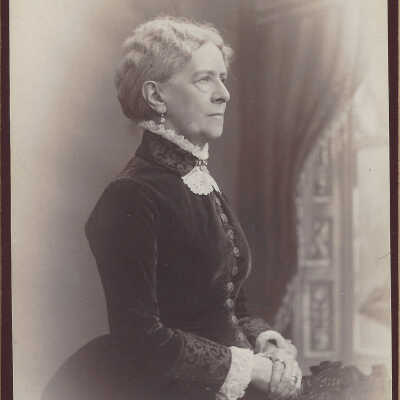
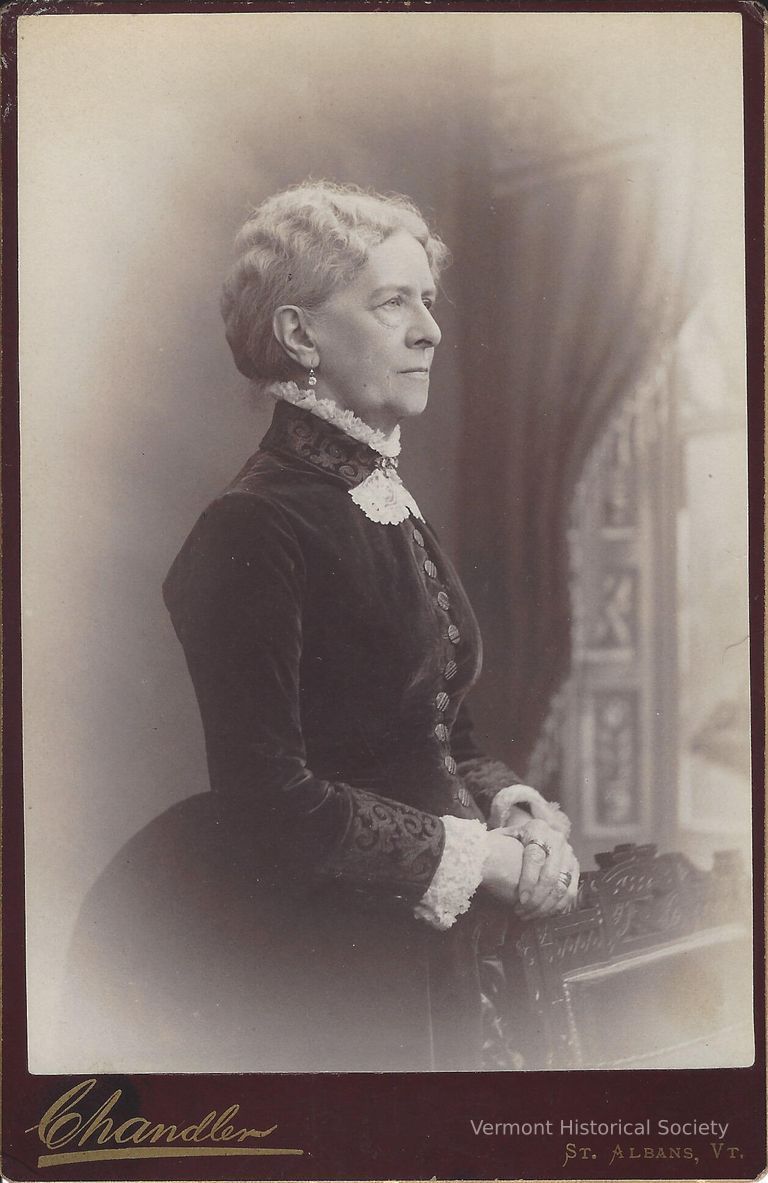
Smith, Anne Eliza Brainerd (1819-1905)
Name/Title
Smith, Anne Eliza Brainerd (1819-1905)
Description
Born: October 7, 1819 in St. Albans, Vermont
Died: January 6, 1905 in St. Albans, Vermont
Primary Residence: St. Albans
Prolific writer of essays, poems, and novels in the late nineteenth century. "Seola" (1878) was revised and republished in 1924 as "Angels and Women." Wife of J. Gregory Smith, railroad developer and governor of Vermont during the Civil War. Active in local charitable work. President of Managers of Vermont Women's Exhibit at Centennial Exposition in Philadelphia.
Died: January 6, 1905 in St. Albans, Vermont
Primary Residence: St. Albans
Prolific writer of essays, poems, and novels in the late nineteenth century. "Seola" (1878) was revised and republished in 1924 as "Angels and Women." Wife of J. Gregory Smith, railroad developer and governor of Vermont during the Civil War. Active in local charitable work. President of Managers of Vermont Women's Exhibit at Centennial Exposition in Philadelphia.
Biographical Information
Biography
Anne Eliza Brainerd Smith was a prolific writer. The eldest daughter of politician and abolitionist Lawrence Brainerd and Fidelia B. Gadcombe, she married John Gregory Smith. A prominent lawyer, politician, and railroad developer, John Gregory Smith served as governor of Vermont during the Civil War. The couple had six children; their son, Edward, served as governor during the Spanish-American War.
Under the name, Mrs. J. Gregory Smith, or anonymously, Smith wrote essays on religious topics, poems, and several important novels in the late nineteenth century. Her novel, "Seola" (1878), was revised and republished under the title "Angels and Women" in 1924.
Anne Smith became prominent in Vermont, both because of her husband's position and her own writings, which led to many speaking engagements. She became involved in local charitable work and served as president of the Warner Home for Little Wanderers. In 1876, she became president of the managers of the Vermont women's exhibit at the Centennial Exposition in Philadelphia. She traveled widely, both in the United States and abroad.
Smith's papers can be found at the St. Albans Museum. Correspondence with her husband is located at the Vermont Historical Society.
Occupation
Writer
Entry/Object ID
1.1.136
Web Links and URLs

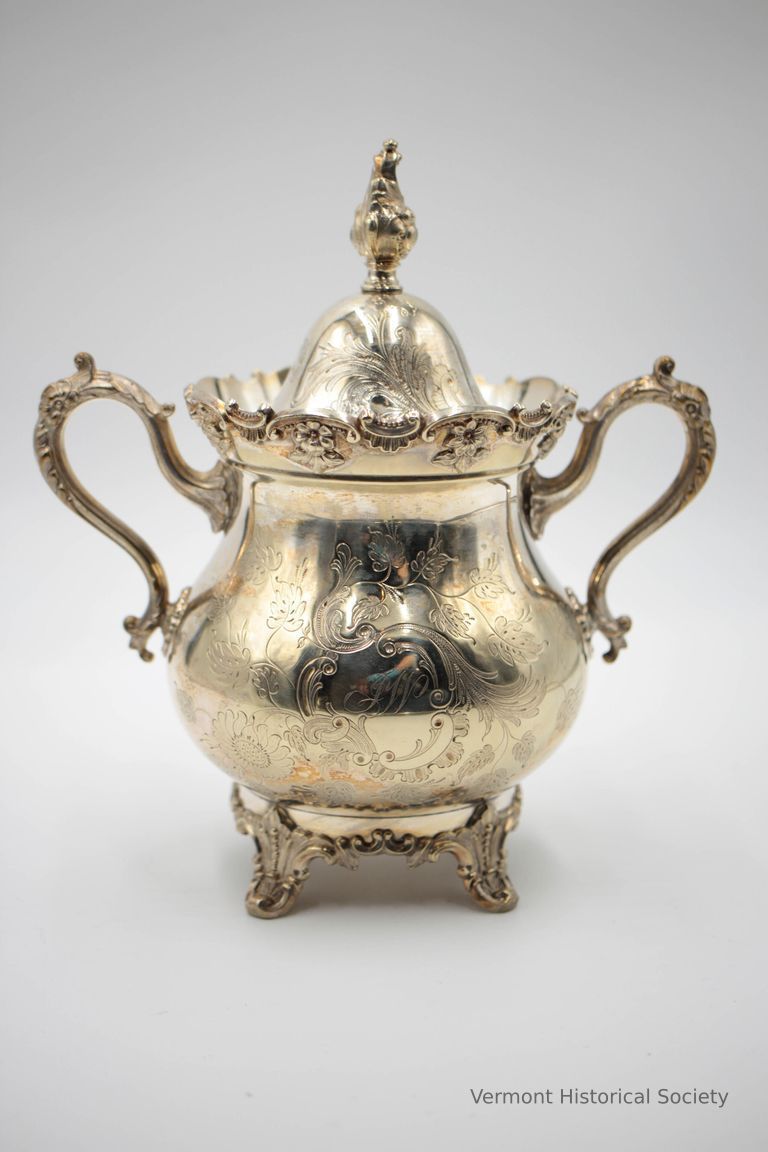
Sugar Bowl
Name/Title
Sugar Bowl
Lexicon
Description
Ornate silver sugar bowl with hinged lid and two handles. The bowl is extensively decorated with applied molded flowers at the base, handles, and rim. The body and lid are engraved with rococo-style scrollwork featuring oak leaves on the front and flowers on the back. A cartouche at the center front is engraved with the initials, "JW".
Acquisition
Accession
1972.58
Relationships
Related Person or Organization
Wilder, Jonas (1812-1906)
Person or Organization
Made/Created
Date made
1858
Manufacturer
Rogers & Bro.
Dimensions
Dimension Description
Overall
Materials
Material
Silver
Entry/Object ID
1972.58.1d
Context
Given as a retirement gift to Jonas Wilder, who invented the first refrigerated railroad car for transporting butter from Vermont to Boston.


Tea Service
Name/Title
Tea Service
Lexicon
Description
Silver-plated oval tray. The tray has two small handles on the ends and is engraved in the center with rococo-style scrollwork and hunt scenes.
Acquisition
Accession
1972.58
Relationships
Related Person or Organization
Wilder, Jonas (1812-1906)
Person or Organization
Made/Created
Date made
1858
Manufacturer
Manhattan Plate Company
Dimensions
Dimension Description
Overall
Materials
Material
Silver, Silverplate
Entry/Object ID
1972.58.1g
Context
Given as a retirement gift to Jonas Wilder, who invented the first refrigerated railroad car for transporting butter from Vermont to Boston.

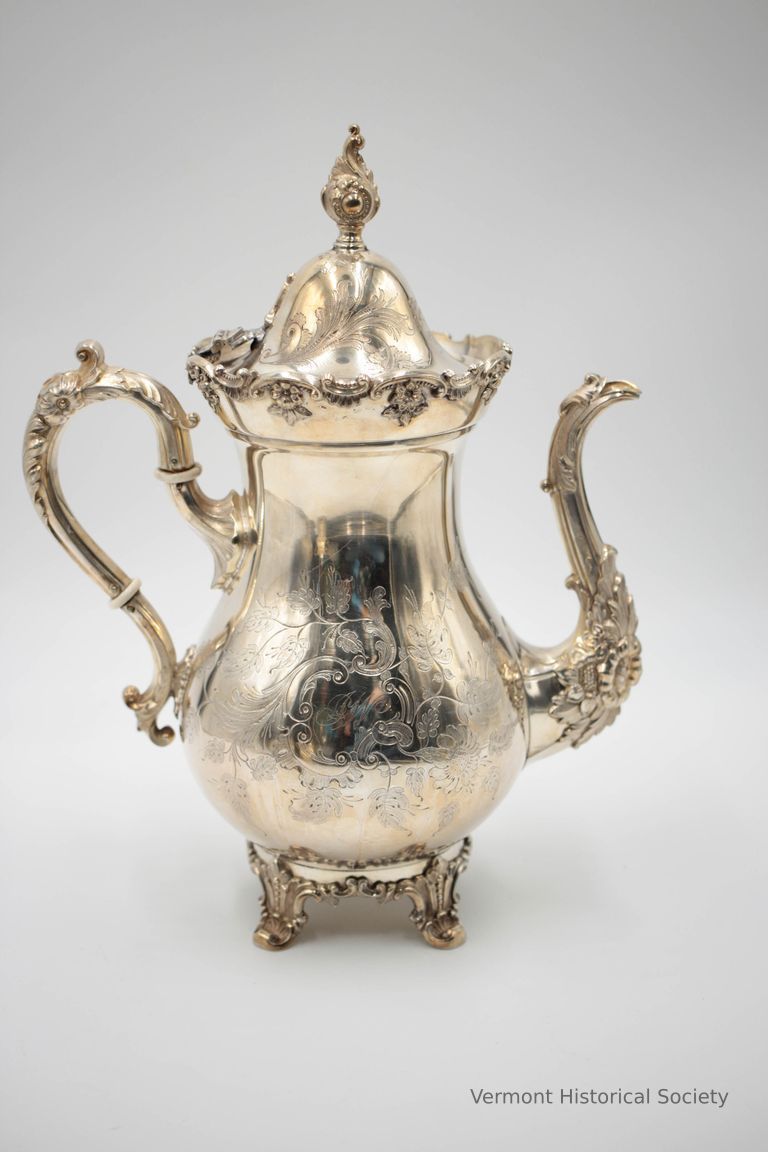
Teapot
Name/Title
Teapot
Lexicon
Description
Ornate, silver teapot with hinged lid. The pot is extensively decorated with applied molded flowers at the base, handle, spout, and rim. The body and lid are engraved with rococo-style scrollwork featuring oak leaves on the front and flowers on the back. A cartouche at the center front is engraved with the initials, "JW".
Acquisition
Accession
1972.58
Relationships
Related Person or Organization
Wilder, Jonas (1812-1906)
Person or Organization
Made/Created
Date made
1858
Manufacturer
Rogers & Bro.
Dimensions
Dimension Description
Overall
Materials
Material
Silver
Entry/Object ID
1972.58.1a
Context
Given as a retirement gift to Jonas Wilder, who invented the first refrigerated railroad car for transporting butter from Vermont to Boston.

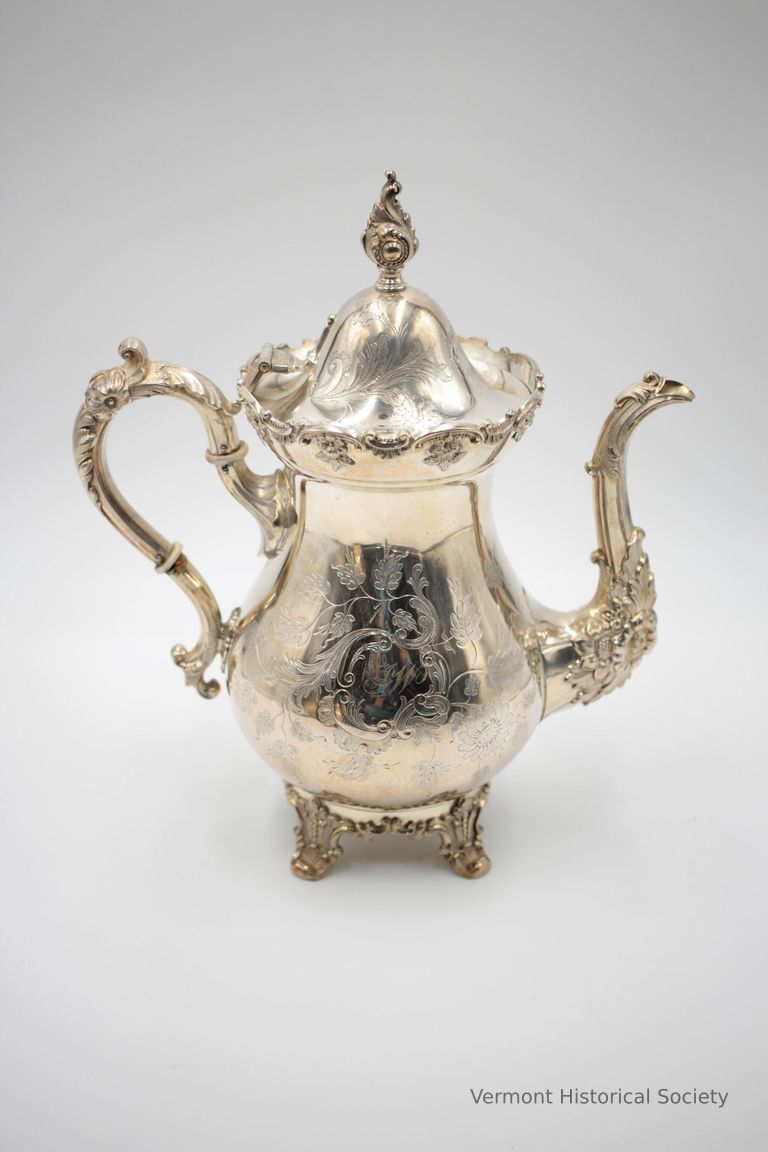
Teapot
Name/Title
Teapot
Lexicon
Description
Ornate, silver-plated teapot with hinged lid. The pot is extensively decorated with applied molded flowers at the base, handle, spout, and rim. The body and lid are engraved with rococo-style scrollwork featuring oak leaves on the front and flowers on the back. A cartouche at the center front is engraved with the initials, "JW".
Acquisition
Accession
1972.58
Relationships
Related Person or Organization
Wilder, Jonas (1812-1906)
Person or Organization
Made/Created
Date made
1858
Manufacturer
Rogers & Bro.
Dimensions
Dimension Description
Overall
Materials
Material
Silver
Entry/Object ID
1972.58.1b
Context
Given as a retirement gift to Jonas Wilder, who invented the first refrigerated railroad car for transporting butter from Vermont to Boston.


Teapot
Name/Title
Teapot
Lexicon
Description
Ornate, silver teapot with hinged lid. The pot is extensively decorated with applied molded flowers at the base, handle, spout, and rim. The body and lid are engraved with rococo-style scrollwork featuring oak leaves on the front and flowers on the back. A cartouche at the center front is engraved with the initials, "JW".
Acquisition
Accession
1972.58
Relationships
Related Person or Organization
Wilder, Jonas (1812-1906)
Person or Organization
Made/Created
Date made
1858
Manufacturer
Rogers & Bro.
Dimensions
Dimension Description
Overall
Materials
Material
Silver
Entry/Object ID
1972.58.1c
Context
Given as a retirement gift to Jonas Wilder, who invented the first refrigerated railroad car for transporting butter from Vermont to Boston.
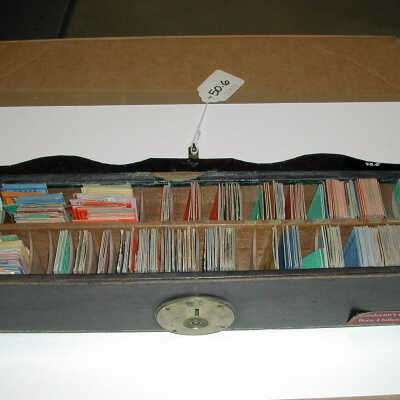

Ticket Box
Name/Title
Ticket Box
Lexicon
Description
Long, leather covered box. The box lid hinges from the back and secures with a front flap that locks in the center. The flap is labeled, "R. C. BUSH," on the left and "VT. C. R. R." on the right. The interior of the box has wooden dividers separating it into two rows with several small cubbies.
Use
Used to collect train tickets from passengers on the Vermont Central Railroad.
Acquisition
Accession
1950.6
Relationships
Related Person or Organization
Bush, R. C., Central Vermont Railway
Made/Created
Date made
1840-1850
Dimensions
Dimension Description
Overall
Materials
Material
Leather
Entry/Object ID
1950.6
Context
Used by R. C. Bush, a train conductor for Vermont Central Railroad. Bush died when the engine on his train exploded around 1850.


Ticket Punch
Name/Title
Ticket Punch
Lexicon
Description
Chrome-plated ticket punch. The punch has two rounded handles that lead to a mount with a slit in the middle. The punch tack is in the shape of an L.
Use
Used to stamp railroad tickets
Acquisition
Accession
1972.61
Dimensions
Materials
Material
Metal
Entry/Object ID
1972.61.1


Towel
Name/Title
Towel
Lexicon
Description
Linen kitchen towel printed with images of train stations and train-related objects of interest.
Acquisition
Accession
2021.5
Relationships
Related Person or Organization
Rutland Railroad
Person or Organization
Woven Textile Details
Warp
Linen
Warp Materials
Weave Type
Plain Weave
Weft
Linen
Weft Materials
Made/Created
Time Period
20th Century
Manufacturer
KayDee
Materials
Material
Linen
Entry/Object ID
2021.5.2
Context
The stations depicted are along the Rutland Railroad route.
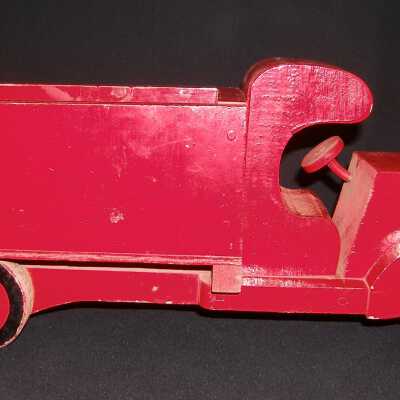

Toy Truck
Name/Title
Toy Truck
Description
Red-painted wooden toy truck. The truck has a walled bed and open cab. The outer walls of the wheels are painted black, and the wheels are each mounted on a wire axel, allowing them to rotate. The front bumper is painted silver, and there is a small silver decoration painted on the hood. The label, "R.H.A. 1952" is written in black ink on the bottom of the truck, beneath the driver's seat.
Acquisition
Accession
2008.38
Made/Created
Artist Information
Adams, Raymond Herbert (1920-1998)
Artist
Date made
1952
Dimensions
Dimension Description
Overall
Materials
Material
Wood
Entry/Object ID
2008.38.7
Context
Made by Raymond "Bob" H. Adams. He made several trucks as Christmas presents for all his male grandchildren. They were assembled and painted at the Railroad Station waiting room.
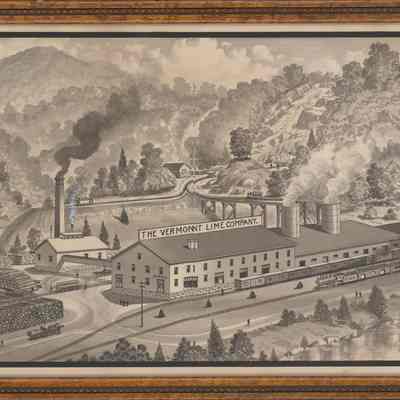
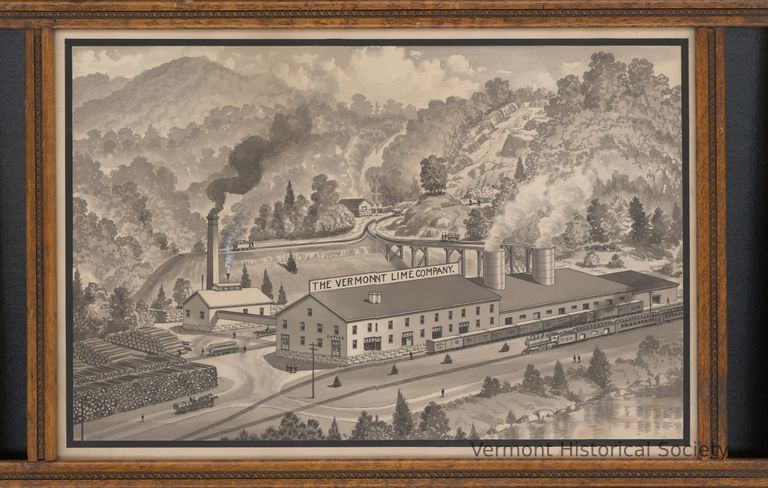
Vermont Lime Company
Name/Title
Vermont Lime Company
Lexicon
Description
This artwork is a watercolor and ink drawing depicting an industrial scene. At the center of the composition stands a large industrial building or factory, distinguished by a prominent sign on its roof peak that reads "THE VERMONT LIME COMPANY." This building is connected to a shorter factory structure, characterized by two substantial chimneys or smokestacks. In the foreground, parallel to the factory, two railroad tracks are depicted, with trains positioned along them. Towards the bottom right corner, a river flows. On the left side of the composition, piles of timber can be seen. In the background, the horizon is marked by rolling hills. The railroad tracks form a bridge leading into the hills.
Acquisition
Accession
2005.30
Relationships
Related Person or Organization
The Vermont Lime Company
Person or Organization
Artwork Details
Medium
Watercolor
Subject
Vermont Lime Company
Made/Created
Date made
1910-1913
Dimensions
Entry/Object ID
2005.30.1
Type of Drawing
Context
The Vermont Lime Company operated in Whitingham, Vermont from 1910 to 1913.
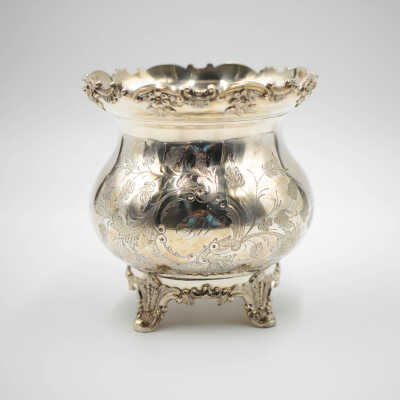

Waste Bowl
Name/Title
Waste Bowl
Lexicon
Description
Ornate silver waste bowl. The bowl is extensively decorated with applied molded flowers at the base and rim. The body is engraved with rococo-style scrollwork featuring oak leaves on the front and flowers on the back. A cartouche at the center front is engraved with the initials, "JW".
Acquisition
Accession
1972.58
Relationships
Related Person or Organization
Wilder, Jonas (1812-1906)
Person or Organization
Made/Created
Date made
1858
Manufacturer
Rogers & Bro.
Dimensions
Dimension Description
Overall
Materials
Material
Silver
Entry/Object ID
1972.58.1f
Context
Given as a retirement gift to Jonas Wilder, who invented the first refrigerated railroad car for transporting butter from Vermont to Boston.
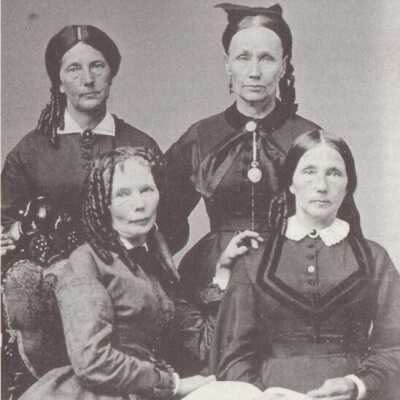
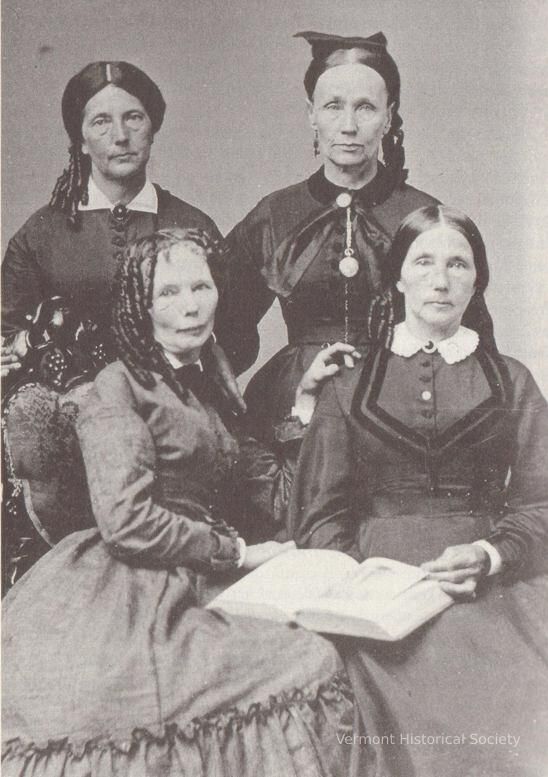
Webster, Delia (1817-1904)
Name/Title
Webster, Delia (1817-1904)
Description
Born: December 17, 1817 in Vergennes, Vermont
Died: January 18, 1904 in Des Moines, Iowa
Primary Residence: Vergennes
Active abolitionist in 1840's and 1850's
Died: January 18, 1904 in Des Moines, Iowa
Primary Residence: Vergennes
Active abolitionist in 1840's and 1850's
Biographical Information
Education
Attended courses at Oberlin College
Biography
Delia Webster was born on December 17, 1817 in Vergennes, Vermont, an area with strong anti-slavery sentiment. She attended Vergennes Classical School, and later studied at Oberlin College. Oberlin had a reputation for its abolitionist activities and was a station on the underground railroad. Webster left Oberlin due to an unknown dispute with the college.
In 1843 Webster then moved on to Lexington, Kentucky where she founded the Lexington Female Missionary Society, a girl's school. In 1844, she and the Methodist minister Calvin Fairbank succeeded in transporting a black family (Lewis Hayden, his wife, Harriet, and their young son, Joseph) across the border to freedom in Ohio. Webster and Fairbank were, however, caught on the return trip. Webster was sentenced to two years in the state penitentiary, though Kentucky's governor pardoned her after she spent two months in jail. As a condition of her release, she proclaimed that she was not an abolitionist, which was obviously a false statement.
Webster returned to Vermont and wrote a book (published 1845) with her father about her trial. After a few years in the north, she moved to Madison, Ind., on the Kentucky border, where she tutored children and became a governess. She then bought a farm in Kentucky, where newspapers soon reported that many slaves had disappeared. She left Kentucky in 1854 after raids on the farm, threats, and scandal. She continued to lecture and write for a while. Webster died in Iowa in 1904 at the age of eighty-six.
Occupation
Abolitionist
Teacher
Entry/Object ID
1.1.96
Web Links and URLs


Willoughby Lake House
Name/Title
Willoughby Lake House
Lexicon
Description
White, three-story hotel with outbuildings featured in lower right of print. Stage coach can be seen arriving. Two steep mountain peaks frame a lake in the middle and background. The lower left features visitors watching two chained bears fight.
The print is titled: Willoughby Lake House, Westmore, VT
The lithograph is noted as from a "Sketch by Hunter" and produced by "J.H. Bufford's Lith.-Boston."
Instructions for traveling to the resort by rail, stage, or road are printed at the bottom of the piece along with the resort ownership: Bemis, Hall & Company
The print is titled: Willoughby Lake House, Westmore, VT
The lithograph is noted as from a "Sketch by Hunter" and produced by "J.H. Bufford's Lith.-Boston."
Instructions for traveling to the resort by rail, stage, or road are printed at the bottom of the piece along with the resort ownership: Bemis, Hall & Company
Acquisition
Accession
2006.69
Relationships
Related Places
Place
Lake Willoughby
Lake
Westmore
Town
Orleans County
County
Vermont
State/Province
United States of America
Country
North America
Related Publications
Northern Tourist
Publication
Artwork Details
Medium
Paper, Ink
Subject
Willoughby Lake House
Made/Created
Date made
circa 1854
Manufacturer
Bufford's Lithography
Dimensions
Entry/Object ID
2006.69.9
Context
Alonzo Bemis of Lyndon, along with investors, constructed the Willoughby Lake House in 1852. By 1854, when this print was produced, the resort was very popular and growing fast. Summer guests took the Passumpsic Railroad and then the Willoughby Lake and White Mountains Stage Coach operated by resort owners Bemis, Hall & Co. Guests enjoyed boating excursions, guided angling, hikes up mounts Pisgah and Hor, or relaxation on the large lawns. The Lake House was a popular resort and large part of the Westmore economy right up until it was destroyed by fire in 1907. It was never rebuilt and much of the area is now a private campground.